The Impact of Technology on Mental Health
In the contemporary world, symptoms of depression, stress, anxiety, and other mental disorders have become more prevalent among university students. Researchers have proven that time spent on social media, videos, and Instant messaging is directly associated with psychological distress. This bibliography examines different literature discussing how technology affects mental wellness.
The scope of this research is to uncover the consequences of technology use on mental health. The research question above will help examine the relationship between technology use and how this action results in mental illnesses such as anxiety and depression. Information used in this study includes both primary and secondary sources focusing on their observational and experimental data analysis.
The article explores how web-based social networking is a significant limitation to mental health. Deepa and Priya (2020) introduce a concept of time whereby they explain that the hours spent on social networking platforms promote depression and anxiety (Deepa & Priya, 2020). Some of the digital technology students use are Instagram, Facebook, Twitter, YouTube, and other web-based sites platforms, which have become a threat to mental health (Deepa & Priya, 2020). The authors explain that researchers discovered that excessive social media use was linked to mental illnesses during schooling. However, it may be alleviated by dialectical thinking, positivity, meditation, and active coping.
The authors used descriptive research using simple sampling questionnaires and ANOVA to study different groups of students and the social media platforms they use. This system provided mixed results based on these groups and examinations (Deepa & Priya, 2020). The research findings revealed a relationship between being active on social media and depression. The authors contradict a study done by Gordon et al. (2007) that mentions that the time spent on the internet has nothing to do with depression (Deepa & Priya, 2020). Instead, it is what students engage in when they are active online. This study is credible because it is not outdated and involved many participants, which helped strengthen the hypothesis created. This source will be integral in answering the types of technology students use and their consequences on mental wellness. Additionally, the journal’s credibility is guaranteed, considering that the article is an international publication. This title indicates that the journal has been peer-reviewed by many other scholars to ensure the information provided is accurate.
The article examines how internet use affects well-being by analyzing the rate of internet use among college students. Gordon et al. (2007) mention that technology use is triggered by self-expression, consumptive motives, and sharing information. In this study, Gordon et al. (2007) posit that frequency of internet use does not affect mental illness. Instead, they mention that what students do on those platforms is the factor that contributes to mental illness.
First, they mention that the internet has provided ways for students to get new acquaintances, find intimate partners, and conduct research for their college assignments, among other things. This factor indicates that these students’ daily life has become increasingly reliant on the internet (Gordon et al., 2007). Therefore, increased internet use has formed a new environment, full of peer pressure. This explanation is an indication of what they do on the internet. The reason is that they see, admire, and adopt new habits which increase stress and depressive symptoms. Additionally, overdependence on technology has affected family cohesion and social connectedness.
The article provides similar ideologies as Junco et al. (2011) that technology causes social isolation by keeping students from the realities in their environment. It explains that students live a fictional life by actively engaging in technology to hide their true selves (Gordon et al., 2007). The research is valid considering it applies rationales from different authors to justify their deduction that technology use has become an avenue for peer pressure among students. This article is essential since it explains the negative impact of technology on mental health, which is explored in this research. It is also a scholarly article considering that these authors have doctors of philosophy in education, indicating vast knowledge and command to undertake this research.
These researchers use unique survey data to investigate the adverse effects of instant messaging on academic achievement. They explain that instant messaging is not destructive since it can provide company when needed. However, excessive use of instant messaging reduces concentration by diverting the mind’s attention away from the facts of the surroundings. Students lose focus when multitasking activities like chatting while studying (Junco & Cotten, 2011). It also impacts the essential, incidental, and representational processing systems, the foundation for learning and memory. When they fail their tests, they become withdrawn with significant effects, such as anxiety and depression.
Additionally, the authors mention that students using IM become socially disengaged since IM becomes their point of contact with others. Considering all these effects, it is evident that IM can cause anxiety, depression, and social isolation if not regulated. Unlike Gordon et al. (2007), who mention only the detrimental effects of using technology, these authors mention that IM, an example of technology, helps students manage stress (Junco & Cotten, 2011). They explain that through a survey of a target group whereby students reported that IM and other online platforms such as video games had provided contact with the outside world, which relieves stress.
This article’s viability is uncertain because most arguments presented are derived from other researchers’ work (Junco & Cotten, 2011). However, the article is helpful for my research because it provides the negative and positive effects of using technology. The position of this research is that IM can help deal with stress. The viability of this research is verified considering the research has been reviewed by Mendeley Company which generates citations for scholarly articles.
Karim et al. (2020) explore how social media impacts mental health. They begin by conducting a qualitative analysis of 16 different studies provided by various researchers on the topic (Karim et al., 2020). First, they listed different types of social media platforms, including Twitter, Linkedin, Facebook, Instagram, and Snapchat, to be the most widely used social media platforms among the youth. They also mention that social media has become an influential technology in the contemporary world (Karim et al., 2020). Although social media has incredible benefits, it is linked to various mental health issues such as depression and anxiety. Some works agreed that social media use is detrimental to mental well-being, and the timing does not matter (Karim et al., 2020). In contrast, other studies suggested that no evidence justifies the maximum time one should be active on social media. None of the research provided the limit of time recommended for anyone to be active on social media.
The credibility of the piece is jeopardized because the researchers did not conduct their study to identify the correlation between mental health and technology (Karim et al., 2020). However, it provides substantial ideas drawn from other credible sources, which are essential in providing information addressing this topic. For example, their position is that long hours of social media use contribute to depression and anxiety (Karim et al., 2020). This focus is integral in my research since it addresses the impact of technology on mental health by explaining the possible avenues for mental health crises.
Lattie et al. (2019) investigate how the rise in mental disorders such as anxiety and depression correlates with computing technologies. According to these authors, personal computing technologies such as smartphones have become the source of mental health crises since they provide access to social media (Lattie et al., 2019). This platform has promoted harmful ideas that make people experience peer comparison. For instance, “fear of missing out (FOMO) is a pressure promoted by media which dictates how people interact, behave and talk within these platforms” (Lattie et al., 2019, para. 8). FOMO is when people feel the need to fit in with a specific trend by emulating verbatim how their internet friends behave, dress or talk. For instance, if all the girls on social media put on branded clothes for attention, every girl on the platform would also want to be like them. This pressure will result in stress to keep up with the standards set, promoting mental health disorders. These authors conclude that the pressure to feel accepted has increased the number of students negatively affected by technology.
However, the authors also mention that this digital platform has played a significant role in promoting mental health wellness. In addition, some of the interventions available such as the Headspace and Pacifica applications, are technology-enabled and provide coping skills when students face a crisis (Lattie et al., 2019). Lattie et al. (2019) provide similar sentiments as Junco et al. (2011), who also stated that technology is not entirely to blame for mental crises considering that activities such as assimilation of culture affect well-being. Additionally, this article is relevant since it has applied different up-to-date scholarly reasoning to create a hypothesis (Lattie et al., 2019). Finally, the article’s position is that social media promotes mental health by providing coping skills while also deteriorating it by contributing to disorders such as depression. However, this information is contrary to what Junco et al. (2011) mention that technology has the power to relieve stress by providing a coping mechanism.
The article provides informative discussions on the risks that digital presence has promoted. Skillbred-Fjeld et al. (2020) mention that many people have experienced harassment online based on their appearance, ethnicity, age, race, and religion. This exposure to bullying has resulted in psychological distress such as depression and suicidal thoughts. The authors indicate that most students spend more hours on digital media than how they spend with families and friends while also being more exposed to harassment. This disconnect is also a challenge to maintaining mental health, considering it breaks the bond between families and friends.
These authors stress that cyberbullying is a prevalent occurrence in online engagement and has detrimental effects on individuals. This article does not share similar rationales with other articles in this search since it focuses on proving how cyberbullying results in mental illness. The article answers the proposed research question, and its position is that cyberbullying affects most students using digital communication systems (Skilbred-Fjeld et al., 2020). The article is credible for this research since the author engaged in intensive searches, which enhanced the viability of the information provided.
In her article “Cyberspace and Identity,” Turkle (1999) posits that the development of cyberspace interactions has extended the range of identities. The author establishes her case with four essential points. Her first observation is that digital presence is based on fiction and not reality. Second, she claims that digital profile results from a digital exhibition that does not last. The third point made by Turkle (1999) is that online identity affects real self-considering the fact that it affects thoughts and behaviors). Finally, she claims that online identity exemplifies a cultural conception of diversity.
This author introduces the aspect of role-playing promoted by digital presence. She mentions that people are given a chance to portray themselves in a different light from reality on digital platforms considering the anonymity established when altering self-image through textual construction (Turkle, 1999). The research by Gordon et al. (2007) reinforced this claim when they mentioned that digital engagement does not cause mental illness. Instead, what students do on those platforms is the primary factor contributing to mental illness (Turkle, 1999). This factor is relatable in the current digital world since people share their adventurous moments, making others who cannot enjoy such things feel unworthy, posing a significant threat to mental wellness. The article’s position is that images portrayed on digital platforms are illusions, and they have promoted peer pressure, anxiety, and depression in people who believe them to be true (Turkle, 1999). The same sentiments are shared by Skilbred-Fjeld et al. (2020) since they mention that social media has become a site to dehumanize others who are less privileged. This occurrence promotes fear, self-hate, and depression, indicating a match in reasoning among these authors.
Deepa, M., & Priya, K. (2020). Impact of social media on mental health of students. International Journal of Scientific & Technology Research , 9 (03). Web.
Gordon, C., Juang, L., & Syed, M. (2007). Internet use and well-being among college students: Beyond frequency of use. Journal of College Student Development , 48( 6), 674-688. Web.
Junco, R., & Cotten, S. R. (2011). Perceived academic effects of instant messaging use.
Computer & Education , 56 (2), 370-378. Web.
Karim, F., Oyewande, A. A., Abdalla, L. F., Ehsanullah, R. C., & Khan, S. (2020). Social media use and its connection to mental health: A systematic review. Cureus , 12 (6). Web.
Lattie, E. G., Lipson, S. K., & Eisenberg, D. (2019). Technology and college student mental health: Challenges and opportunities. Frontiers in psychiatry , (10) , 246. Web.
Skilbred-Fjeld, S., Reme, S. E., & Mossige, S. (2020). Cyberbullying involvement and mental health problems among late adolescents. Cyberpsychology: Journal of Psychosocial Research on Cyberspace , 14 (1). Web.
Turkle, S. (1999). Looking toward cyberspace: Beyond grounded sociology. Cyberspace and identity. Contemporary Sociology , 28 (6), Web.
Cite this paper
- Chicago (N-B)
- Chicago (A-D)
StudyCorgi. (2022, December 10). The Impact of Technology on Mental Health. https://studycorgi.com/the-impact-of-technology-on-mental-health/
"The Impact of Technology on Mental Health." StudyCorgi , 10 Dec. 2022, studycorgi.com/the-impact-of-technology-on-mental-health/.
StudyCorgi . (2022) 'The Impact of Technology on Mental Health'. 10 December.
1. StudyCorgi . "The Impact of Technology on Mental Health." December 10, 2022. https://studycorgi.com/the-impact-of-technology-on-mental-health/.
Bibliography
StudyCorgi . "The Impact of Technology on Mental Health." December 10, 2022. https://studycorgi.com/the-impact-of-technology-on-mental-health/.
StudyCorgi . 2022. "The Impact of Technology on Mental Health." December 10, 2022. https://studycorgi.com/the-impact-of-technology-on-mental-health/.
This paper, “The Impact of Technology on Mental Health”, was written and voluntary submitted to our free essay database by a straight-A student. Please ensure you properly reference the paper if you're using it to write your assignment.
Before publication, the StudyCorgi editorial team proofread and checked the paper to make sure it meets the highest standards in terms of grammar, punctuation, style, fact accuracy, copyright issues, and inclusive language. Last updated: December 10, 2022 .
If you are the author of this paper and no longer wish to have it published on StudyCorgi, request the removal . Please use the “ Donate your paper ” form to submit an essay.

Subscribe or renew today
Every print subscription comes with full digital access
Science News
Social media harms teens’ mental health, mounting evidence shows. what now.
Understanding what is going on in teens’ minds is necessary for targeted policy suggestions

Most teens use social media, often for hours on end. Some social scientists are confident that such use is harming their mental health. Now they want to pinpoint what explains the link.
Carol Yepes/Getty Images
Share this:
By Sujata Gupta
February 20, 2024 at 7:30 am
In January, Mark Zuckerberg, CEO of Facebook’s parent company Meta, appeared at a congressional hearing to answer questions about how social media potentially harms children. Zuckerberg opened by saying: “The existing body of scientific work has not shown a causal link between using social media and young people having worse mental health.”
But many social scientists would disagree with that statement. In recent years, studies have started to show a causal link between teen social media use and reduced well-being or mood disorders, chiefly depression and anxiety.
Ironically, one of the most cited studies into this link focused on Facebook.
Researchers delved into whether the platform’s introduction across college campuses in the mid 2000s increased symptoms associated with depression and anxiety. The answer was a clear yes , says MIT economist Alexey Makarin, a coauthor of the study, which appeared in the November 2022 American Economic Review . “There is still a lot to be explored,” Makarin says, but “[to say] there is no causal evidence that social media causes mental health issues, to that I definitely object.”
The concern, and the studies, come from statistics showing that social media use in teens ages 13 to 17 is now almost ubiquitous. Two-thirds of teens report using TikTok, and some 60 percent of teens report using Instagram or Snapchat, a 2022 survey found. (Only 30 percent said they used Facebook.) Another survey showed that girls, on average, allot roughly 3.4 hours per day to TikTok, Instagram and Facebook, compared with roughly 2.1 hours among boys. At the same time, more teens are showing signs of depression than ever, especially girls ( SN: 6/30/23 ).
As more studies show a strong link between these phenomena, some researchers are starting to shift their attention to possible mechanisms. Why does social media use seem to trigger mental health problems? Why are those effects unevenly distributed among different groups, such as girls or young adults? And can the positives of social media be teased out from the negatives to provide more targeted guidance to teens, their caregivers and policymakers?
“You can’t design good public policy if you don’t know why things are happening,” says Scott Cunningham, an economist at Baylor University in Waco, Texas.
Increasing rigor
Concerns over the effects of social media use in children have been circulating for years, resulting in a massive body of scientific literature. But those mostly correlational studies could not show if teen social media use was harming mental health or if teens with mental health problems were using more social media.
Moreover, the findings from such studies were often inconclusive, or the effects on mental health so small as to be inconsequential. In one study that received considerable media attention, psychologists Amy Orben and Andrew Przybylski combined data from three surveys to see if they could find a link between technology use, including social media, and reduced well-being. The duo gauged the well-being of over 355,000 teenagers by focusing on questions around depression, suicidal thinking and self-esteem.
Digital technology use was associated with a slight decrease in adolescent well-being , Orben, now of the University of Cambridge, and Przybylski, of the University of Oxford, reported in 2019 in Nature Human Behaviour . But the duo downplayed that finding, noting that researchers have observed similar drops in adolescent well-being associated with drinking milk, going to the movies or eating potatoes.
Holes have begun to appear in that narrative thanks to newer, more rigorous studies.
In one longitudinal study, researchers — including Orben and Przybylski — used survey data on social media use and well-being from over 17,400 teens and young adults to look at how individuals’ responses to a question gauging life satisfaction changed between 2011 and 2018. And they dug into how the responses varied by gender, age and time spent on social media.
Social media use was associated with a drop in well-being among teens during certain developmental periods, chiefly puberty and young adulthood, the team reported in 2022 in Nature Communications . That translated to lower well-being scores around ages 11 to 13 for girls and ages 14 to 15 for boys. Both groups also reported a drop in well-being around age 19. Moreover, among the older teens, the team found evidence for the Goldilocks Hypothesis: the idea that both too much and too little time spent on social media can harm mental health.
“There’s hardly any effect if you look over everybody. But if you look at specific age groups, at particularly what [Orben] calls ‘windows of sensitivity’ … you see these clear effects,” says L.J. Shrum, a consumer psychologist at HEC Paris who was not involved with this research. His review of studies related to teen social media use and mental health is forthcoming in the Journal of the Association for Consumer Research.
Cause and effect
That longitudinal study hints at causation, researchers say. But one of the clearest ways to pin down cause and effect is through natural or quasi-experiments. For these in-the-wild experiments, researchers must identify situations where the rollout of a societal “treatment” is staggered across space and time. They can then compare outcomes among members of the group who received the treatment to those still in the queue — the control group.
That was the approach Makarin and his team used in their study of Facebook. The researchers homed in on the staggered rollout of Facebook across 775 college campuses from 2004 to 2006. They combined that rollout data with student responses to the National College Health Assessment, a widely used survey of college students’ mental and physical health.
The team then sought to understand if those survey questions captured diagnosable mental health problems. Specifically, they had roughly 500 undergraduate students respond to questions both in the National College Health Assessment and in validated screening tools for depression and anxiety. They found that mental health scores on the assessment predicted scores on the screenings. That suggested that a drop in well-being on the college survey was a good proxy for a corresponding increase in diagnosable mental health disorders.
Compared with campuses that had not yet gained access to Facebook, college campuses with Facebook experienced a 2 percentage point increase in the number of students who met the diagnostic criteria for anxiety or depression, the team found.
When it comes to showing a causal link between social media use in teens and worse mental health, “that study really is the crown jewel right now,” says Cunningham, who was not involved in that research.
A need for nuance
The social media landscape today is vastly different than the landscape of 20 years ago. Facebook is now optimized for maximum addiction, Shrum says, and other newer platforms, such as Snapchat, Instagram and TikTok, have since copied and built on those features. Paired with the ubiquity of social media in general, the negative effects on mental health may well be larger now.
Moreover, social media research tends to focus on young adults — an easier cohort to study than minors. That needs to change, Cunningham says. “Most of us are worried about our high school kids and younger.”
And so, researchers must pivot accordingly. Crucially, simple comparisons of social media users and nonusers no longer make sense. As Orben and Przybylski’s 2022 work suggested, a teen not on social media might well feel worse than one who briefly logs on.
Researchers must also dig into why, and under what circumstances, social media use can harm mental health, Cunningham says. Explanations for this link abound. For instance, social media is thought to crowd out other activities or increase people’s likelihood of comparing themselves unfavorably with others. But big data studies, with their reliance on existing surveys and statistical analyses, cannot address those deeper questions. “These kinds of papers, there’s nothing you can really ask … to find these plausible mechanisms,” Cunningham says.
One ongoing effort to understand social media use from this more nuanced vantage point is the SMART Schools project out of the University of Birmingham in England. Pedagogical expert Victoria Goodyear and her team are comparing mental and physical health outcomes among children who attend schools that have restricted cell phone use to those attending schools without such a policy. The researchers described the protocol of that study of 30 schools and over 1,000 students in the July BMJ Open.
Goodyear and colleagues are also combining that natural experiment with qualitative research. They met with 36 five-person focus groups each consisting of all students, all parents or all educators at six of those schools. The team hopes to learn how students use their phones during the day, how usage practices make students feel, and what the various parties think of restrictions on cell phone use during the school day.
Talking to teens and those in their orbit is the best way to get at the mechanisms by which social media influences well-being — for better or worse, Goodyear says. Moving beyond big data to this more personal approach, however, takes considerable time and effort. “Social media has increased in pace and momentum very, very quickly,” she says. “And research takes a long time to catch up with that process.”
Until that catch-up occurs, though, researchers cannot dole out much advice. “What guidance could we provide to young people, parents and schools to help maintain the positives of social media use?” Goodyear asks. “There’s not concrete evidence yet.”
More Stories from Science News on Science & Society

Should we use AI to resurrect digital ‘ghosts’ of the dead?

A hidden danger lurks beneath Yellowstone

Online spaces may intensify teens’ uncertainty in social interactions

Want to see butterflies in your backyard? Try doing less yardwork

Ximena Velez-Liendo is saving Andean bears with honey

‘Flavorama’ guides readers through the complex landscape of flavor

Rain Bosworth studies how deaf children experience the world

Separating science fact from fiction in Netflix’s ‘3 Body Problem’
Subscribers, enter your e-mail address for full access to the Science News archives and digital editions.
Not a subscriber? Become one now .
- Bipolar Disorder
- Therapy Center
- When To See a Therapist
- Types of Therapy
- Best Online Therapy
- Best Couples Therapy
- Best Family Therapy
- Managing Stress
- Sleep and Dreaming
- Understanding Emotions
- Self-Improvement
- Healthy Relationships
- Student Resources
- Personality Types
- Guided Meditations
- Verywell Mind Insights
- 2024 Verywell Mind 25
- Mental Health in the Classroom
- Editorial Process
- Meet Our Review Board
- Crisis Support
For Better or Worse, Technology Is Taking Over the Health World
Sarah Fielding is a freelance writer covering a range of topics with a focus on mental health and women's issues.
:max_bytes(150000):strip_icc():format(webp)/SarahFieldingHeadshot1-afe3609d152d4e409fc179f68c17e652-0ddbe13118414f25ae9e00030fea1fae.jpg)
Steven Gans, MD is board-certified in psychiatry and is an active supervisor, teacher, and mentor at Massachusetts General Hospital.
:max_bytes(150000):strip_icc():format(webp)/steven-gans-1000-51582b7f23b6462f8713961deb74959f.jpg)
Nick Blackmer is a librarian, fact-checker, and researcher with more than 20 years’ experience in consumer-oriented health and wellness content. He keeps a DSM-5 on hand just in case.
:max_bytes(150000):strip_icc():format(webp)/NickBlackmer-1a9957221fee406e85bcdefd1b05a136.jpg)
For many people over the past year and a half, the world has existed primarily through a screen. With social distancing measures in place to protect individuals from becoming infected with the coronavirus, technology has stepped in to fill the void of physical connections. It’s also become a space for navigating existing and new mental health conditions through virtual therapy sessions, meditation apps, mental health influencers, and beyond.
“Over the years, mental health and technology have started touching each other more and more, and the pandemic accelerated that in an unprecedented way,” says Naomi Torres-Mackie, PhD , the head of research at The Mental Health Coalition , a clinical psychologist at Lenox Hill Hospital, and an adjunct professor at Columbia University. “This is especially the case because the pandemic has highlighted the importance of mental health for everyone as we struggle to make sense of an overwhelming new world and can find mental health information and services online.”
This shift is especially critical, with a tremendous spike occurring in mental health conditions. In the period between January and June 2019, 11% of US adults reported experiencing symptoms of an anxiety or depressive disorder. In January 2021, 10 months into the pandemic, in one survey that number increased to 41.1%. Research also points to a potential connection for some between having COVID-19 and developing a mental health condition—whether or not you previously had one.
The pandemic’s bridge between mental health and technology has helped to “meet the needs of many suffering from depression, anxiety, life transition, grief, family conflict, and addiction,” says Miyume McKinley, MSW, LCSW , a psychotherapist and founder of Epiphany Counseling, Consulting & Treatment Services.
Naomi Torres-Mackie, PhD
The risk of greater access is that the floodgates are open for anyone to say anything about mental health, and there’s no vetting process or way to truly check credibility.
This increased reliance on technology to facilitate mental health care and support appears to be a permanent one. Torres-Mackie has witnessed mental health clinicians drop their apprehension around virtual services throughout the pandemic and believes they will continue for good.
“Almost all therapists seem to be at least offering virtual sessions, and a good portion have transitioned their practices to be entirely virtual, giving up their traditional in-person offices,” adds Carrie Torn, MSW, LCSW , a licensed clinical social worker and psychotherapist in private practice in Charlotte, North Carolina.
The general public is also more receptive to technology’s expanded role in mental health care. “The pandemic has created a lasting relationship between technology, and it has helped increase access to mental health services across the world,” says McKinley. “There are lots of people seeking help who would not have done so prior to the pandemic, either due to the discomfort or because they simply didn’t know it was possible to obtain such services via technology.”
Accessibility Is a Tremendous Benefit of Technology
Every expert interviewed agreed: Accessibility is an undeniable and indispensable benefit of mental health’s increasing presence online. Torn points out, “We can access information, including mental health information and treatment like never before, and it’s low cost.”
A 2018 study found that, at the time, 74% of Americans didn’t view mental health as accessible to everyone. Participants cited long wait times, a lack of affordable options, low awareness, and social stigma as barriers to mental health care. The evolution of mental health and technology has alleviated some of these issues—whether it be through influencers creating open discussions around mental health and normalizing it or low-cost therapy apps . In addition, wait times may reduce when people are no longer tied to seeing a therapist in their immediate area.
While some people may still be apprehensive about trying digital therapy, research has shown that it is an effective strategy for managing your mental health. A 2020 review of 17 studies published in EClinicalMedicine found that online cognitive-behavioral therapy sessions were at least as effective at reducing the severity of depression symptoms than in-person sessions. There wasn’t a significant difference in participant satisfaction between the two options.
There Are Limitations to Mental Health and Technology’s Increasing Closeness
One of the most prevalent limitations of technology-fueled mental health care and awareness is the possibility of misleading or inaccurate information.
If you’re attending digital sessions with a therapist, it’s easy to check their qualifications and reviews. However, for most other online mental health resources, it can be more challenging but remains just as critical to verify their expertise and benefits. “The risk of greater access is that the floodgates are open for anyone to say anything about mental health, and there’s no vetting process or way to truly check credibility,” says Torres-Mackle.
To that point, James Giordano, PhD, MPhil , professor of neurology and ethics at Georgetown University Medical Center and author of the book “Neurotechnology: Premises, Potential, and Problems,” cautions that, while there are guiding institutions, the market still contains “unregulated products, resources, and services, many of which are available via the internet. Thus, it’s very important to engage due diligence when considering the use of any mental health technology .”
Verywell / Alison Czinkota
McKinley raises another valuable point: A person’s home is not always a space they can securely explore their mental health. “For many individuals, home is not a safe place due to abuse, addiction, toxic family, or unhealthy living environments,” she says. “Despite technology offering a means of support, if the home is not a safe place, many people won’t seek the help or mental health treatment that they need. For some, the therapy office is the only safe place they have.” Due to the pandemic and a general limit on private places outside of the home to dive into your personal feelings, someone in this situation may struggle to find opportunities for help.
Miyume McKinley, MSW, LCSW
There are lots of people seeking help that would not have done so prior to the pandemic, either due to the discomfort or because they simply didn’t know it was possible to obtain such services via technology.
Torn explains that therapists who work for tech platforms can also suffer due to burnout and low pay. She claims that some of these platforms prioritize seeing new clients instead of providing time for existing clients to grow their relationship. “I’ve heard about clients having to jump from one therapist to the next, or therapists who can’t even leave stops open for their existing clients, and instead their schedule gets filled with new clients,” she says. “Therapists are burning out in general right now, and especially on these platforms, which leads to a lower quality of care for clients.”
Screen Time Can Also Have a Negative Impact
As mental health care continues to spread into online platforms, clinicians and individuals must contend with society’s growing addiction to tech and extended screen time’s negative aspects.
Social media, in particular, has been shown to impact an individual’s mental health negatively. A 2019 study looked at how social media affected feelings of social isolation in 1,178 students aged 18 to 30. While having a positive experience on social media didn’t improve it, each 10% increase in negative experiences elevated social isolation feelings by 13%.
Verywell / Alison Czinkota
While certain aspects like Zoom therapy and mental health influencers require looking at a screen, you can use other digital options such as meditation apps without constantly staring at your device.
What to Be Mindful of as You Explore Mental Health Within Technology
Nothing is all bad or all good and that stands true for mental health’s increased presence within technology. What’s critical is being aware that “technology is a tool, and just like any tool, its impact depends on how it's used,” says Torres-Mackie.
For example, technology can produce positive results if you use the digital space to access treatment that you may have struggled to otherwise, support your mental well-being, or gather helpful—and credible—information about mental health. In contrast, she explains that diving into social media or other avenues only to compare yourself with others and avoid your responsibilities can have negative repercussions on your mental health and relationships.
Giordano expresses the importance of staying vigilant about your relationship with and reliance on tech and your power to control it.
With that in mind, pay attention to how much time you spend online. “We are spending less time outside, and more time glued to our screens. People are constantly comparing their lives to someone else's on social media, making it harder to be present in the moment and actually live our lives,” says Torn.
Between the increase in necessary services moving online and trying to connect with people through a screen, it’s critical to take time away from your devices. According to a 2018 study, changing your social media habits, in particular, can improve your overall well-being . Participants limited Instagram, Facebook, and Snapchat use to 10 minutes a day per platform for three weeks. At the end of the study, they showed significant reductions in depression and loneliness compared to the control group. However, even the increased awareness of their social media use appeared to help the control group lower feelings of anxiety and fear of missing out.
“Remember, it’s okay to turn your phone off. It’s okay to turn notifications off for news, apps, and emails,” says McKinley. Take opportunities to step outside, spend time with loved ones, and explore screen-free self-care activities. She adds, “Most of the things in life that make life worthwhile cannot be found on our devices, apps, or through technology—it’s found within ourselves and each other.”
Kaiser Family Foundation. The implications of COVID-19 for mental health and substance use .
Taquet M, Luciano S, Geddes JR, Harrison PJ. Bidirectional associations between COVID-19 and psychiatric disorder: retrospective cohort studies of 62 354 COVID-19 cases in the USA . Lancet Psychiatry . 2021;8(2):130-140. doi:10.1016/S2215-0366(20)30462-4
Luo C, Sanger N, Singhal N, et al. A comparison of electronically-delivered and face to face cognitive behavioural therapies in depressive disorders: a systematic review and meta-analysis . EClinicalMedicine . 2020;24:100442. doi:10.1016/j.eclinm.2020.100442
Primack BA, Karim SA, Shensa A, Bowman N, Knight J, Sidani JE. Positive and negative experiences on social media and perceived social isolation . Am J Health Promot . 2019;33(6):859-868. doi:10.1177/0890117118824196
Hunt MG, Marx R, Lipson C, Young J. No more FOMO: Limiting social media decreases loneliness and depression . J Soc Clin Psychol . 2018;37(10):751-768. doi:10.1521/jscp.2018.37.10.751

How Does Technology Affect Mental Health?
View all blog posts under Articles | View all blog posts under Counseling Resources

Upon completion of a Master of Arts in Counseling degree , individuals can choose to work as mental health counselors — individuals who help clients living with varying mental health and/or interpersonal issues. For example, a mental health counselor may meet with a bereaved woman in the morning who recently has lost her husband, and then a young man in his 20s in the afternoon who is living with an anxiety disorder. The role is challenging and rewarding, and necessitates understanding and expertise for a whole spectrum of mental health concerns.
Given the ubiquity of technology in daily life — particularly the internet and internet-based platforms such as social media sites and smartphone apps — mental health counselors working today likely will encounter clients who are experiencing issues that may be directly or indirectly linked to the use of digital media. According to Dr. Igor Pantic, writing in the literature review “Online Social Networking and Mental Health,” published by the U.S. National Library of Medicine, there is little doubt that the internet and social media platforms such as Facebook have had a notable impact on the way that individuals communicate.
Pantic further explained that a number of recent studies have observed a link between social media use and certain mental health problems, including anxiety and depression. Pantic is quick to assert, however, that the studies are by no means conclusive and that endeavors to understand the relationship between mental health and technology remain in their infancy.
Still, it is useful for mental health counselors to have an understanding of the research and insights into technology’s impact on mental health, which extends to the positive impacts, as well. After all, drawbacks aside, technology continues to improve many aspects of daily life for the better, and the arena of mental health is no exception: there are a number of observable areas in which the development of technology has helped clients take charge of their mental health care in a positive way.
Technology: A force for good?
Despite progress in terms of mental health awareness, journalist Conor Farrington, writing for the Guardian, explained how mental health care still receives a notable lack of funding from international governments. For example, Farrington reported that the per capita expenses on mental health care in industrialized nations such as the U.S. and U.K. amounts to just over $33, which equates to a little under £33. The amount is considerably less in developing countries. Consequently, Farrington argued that technology holds promise as a vehicle for improving access to mental health care, particularly in nations where such services are elementary at best.
Technology is improving mental health care in a number of ways, Lena H. Sun explained, writing for the Los Angeles Times, and it is primarily through platforms such as apps based on smartphones and computers that can help provide services and information to clients in a more cost-effective way. For example, Sun explained how there are now, in addition to smartphone apps that promote mental wellness, certain platforms available that allow patients to complete courses of cognitive behavioral therapy online. In her article, Sun profiled a British-based service known as the Big White Wall, which has been endorsed by the U.K.’s government-funded National Health Service. Big White Wall is an online platform that enables users living with mental health problems such as anxiety and depression to manage their symptoms from home via tools such as educational resources, online conversations and virtual classes on issues of mental health. The efficacy of Big White Wall is conspicuous — Sun reported on a 2009 study that found that a vast majority of the service’s users —some 95 percent —noted an improvement in their symptoms.

How can counselors harness technology?
Mental health counselors can play an important role in facilitating access to services such as Big White Wall and also can help promote smartphone apps and other online services that can be used to help improve general mental health. Technology can be used alongside in-person counseling, as opposed to being employed as a substitution. Counselors even may find that digital platforms allow the development of deeper working relationships with clients, particularly younger clients who are used to utilizing technology on a daily basis. Bethany Bay, writing in an article for Counseling Today, interviewed Sarah Spiegelhoff, a counselor from Syracuse, N.Y., who elaborated on this important point :
“I find technology resources to be great tools to supplement traditional counseling services, as well as a way for counselors to reach larger populations than we typically serve on an individual basis […] I find that college students are quicker to check Facebook and Twitter statuses than their email, so using social media has been one way for us to promote and distribute information on healthy living and outreach events […] I also share information related to new apps that promote wellness both through our social media accounts and directly in counseling sessions. For example, during alcohol awareness programming, we encouraged students to download free blood alcohol calculator apps. We also offer free mindfulness meditation MP3s through iTunes. I find the MP3s to be a great resource because I am able to present them to clients in session, talk about their experiences listening to and practicing the meditations and then develop a treatment plan that includes their use of the meditations outside of the counseling sessions.”
Counselors also can use platforms to connect with clients who may be situated in underserved or rural areas and are unable to travel for in-person meetings. As Farrington explained, some studies, including one from Oxford University, have found that text messaging and phone calls can be effective ways for counselors to connect with clients. Furthermore, telehealth platforms, which include instant messaging or video calling, already are proving useful in primary care settings for helping counselors reach clients. For example, Rob Reinhardt, writing for Counseling Today, interviewed Tasha Holland-Kornegay, a counseling professional who primarily provides counseling services to clients living with HIV via a messaging platform, which incorporates the option for video and audio calls.
Reinhardt, writing in a different piece published by Tame Your Practice, explained how the use of telemedicine platforms in mental health counseling has been shown to be beneficial in a number of ways. Perhaps most importantly, Reinhardt cited a study from researchers based at the University of Zurich, as detailed by Science Daily, which found that counseling conducted online actually can be more effective than face-to-face sessions. Researchers examined two groups of clients — one group received in-person therapy and the other received therapy via a telemedicine platform. Researchers found that the clients who received counseling sessions online actually experienced better outcomes — 53 percent reported that their depression had abated, compared to 50 percent reporting the same in the group that received in-person counseling. Other benefits include the fact that it is cheaper and allows a wider net of clients to be seen and treated, particularly those who are unable to access mental health services in person, whether due to geography, lack of funds or issues such as social anxiety disorder.
A point of clarification needs to be made, however. Whereas counselors may indeed use online technologies to aid the counseling process or to provide counseling services, they always must abide by the ethical guidelines on the use of technologies. These guidelines can be found in the Ethics Code of American Counseling Association and through the National Board for Certified Counselors’ website. Furthermore, counselors are required by law to be licensed in the locations where their clients reside.
Can technology have an adverse impact on mental health?
Although the use of technology can have a positive impact in terms of helping clients manage and get treated for certain mental health conditions, some research has indicated that the use of technology in general — and especially the internet — actually can be connected with the development of mental health conditions, such as anxiety and depression in some individuals. As Pantic noted, while more research is needed in this area, it is useful to take a closer look at what has been published on this topic so far:
Internet addiction
As detailed by Dr. Romeo Vitelli, writing in an article published by Psychology Today, research has indicated that addiction to the internet , particularly among younger demographics such as adolescents, is becoming a notable issue. Vitelli explained that internet addiction disorder shares many similar features when compared with other forms of addiction, such as withdrawal symptoms when online access is precluded. While the internet can be an agent for good in terms of education and the strengthening of interpersonal relationships, internet addiction can be problematic because it can negatively impact academic success and one’s ability to communicate effectively in person. Vitalli noted that research also has observed a link between certain mental illnesses and internet addiction, including depression, low self-esteem and loneliness.
The link between social media use and mental illness
In his literature review, Pantic explained how several studies have shown a link between depression and the use of social media sites, such as Facebook, Twitter and Instagram. Pantic is quick to caution that much more research is needed before the conclusions reached in the aforementioned studies are widely accepted as fact within the counseling community. Still, the findings are worth examining. Pantic reported on one study from 2013, which found that younger adults who frequently used the social networking site Facebook tended to report feeling less happy, with the use of the social platform possibly to blame. Pantic also reported on a study that he personally was involved with that found among high school students, rates of depression tended to be higher among those who regularly utilized social media sites.
Pantic proffered some possible reasons for the findings, explaining that social media sites, for some individuals, can trigger feelings of low self-esteem. For example, a social media site user may see other people on the site and assume those individuals are more successful, beautiful, intelligent and so on. Pantic explained that a study examining students at a Utah university found those who routinely used social media sites tended to feel as though their peers were more successful and happier than they were. Pantic noted that although these feelings are not necessarily linked to depression, there can be a relationship between them, particularly if the individuals in question already experience or are likely to experience mental health problems.
Dr. Saju Mathew was interviewed for an article by Piedmont Health, wherein he elaborated on this important point : “When we get on social media, we are looking for affirmation and consciously or not, we are comparing our life to the lives of others. As a result, we may not enjoy what’s in the moment.”
In conclusion
The impact of technology has extended into the realm of health care, and it is clear that technology also is making positive changes in terms of mental health care. Research has indicated, however, that the very tools that can help alleviate mental health issues, such as smartphone apps, may be linked with the experience of mental health problems in different contexts. As Pantic stressed, more research is needed before definitive conclusions are drawn. Still, for mental health counselors entering the field, a comprehensive understanding of the nuanced relationship between technology and mental health is necessary for effective practice. Counselors are compelled to expand their technological competencies but always in compliance with their respective ethical guidelines and the rule of law.
Consider Bradley University
If you are interested in pursuing a career as a mental health counselor, consider applying to Bradley University’s online Master of Arts in Counseling — Clinical Mental Health Counseling program. Designed with a busy schedule in mind, completion of the degree program will put you on a direct path to becoming licensed to practice.
Recommended Readings
Substance abuse counseling: What you can learn in a MAC program
What are the Clinical Mental Health specialty courses?
Bradley University Online Counseling Programs
- #5 Among Regional Universities (Midwest) – U.S. News & World Report: Best Colleges (2021)
- #5 Best Value Schools, Regional Universities (Midwest) – U.S. News & World Report (2019)
- Bradley Ranked Among Nation’s Best Universities – The Princeton Review: The Best 384 Colleges (2019). Only 15% of all four-year colleges receive this distinction each year, and Bradley has regularly been included on the list.
- Bradley University has been named a Military Friendly School – a designation honoring the top 20% of colleges, universities and trade schools nationwide that are doing the most to embrace U.S. military service members, veterans and spouses to ensure their success as students.
- Open access
- Published: 06 July 2023
Pros & cons: impacts of social media on mental health
- Ágnes Zsila 1 , 2 &
- Marc Eric S. Reyes ORCID: orcid.org/0000-0002-5280-1315 3
BMC Psychology volume 11 , Article number: 201 ( 2023 ) Cite this article
435k Accesses
15 Citations
107 Altmetric
Metrics details
The use of social media significantly impacts mental health. It can enhance connection, increase self-esteem, and improve a sense of belonging. But it can also lead to tremendous stress, pressure to compare oneself to others, and increased sadness and isolation. Mindful use is essential to social media consumption.
Social media has become integral to our daily routines: we interact with family members and friends, accept invitations to public events, and join online communities to meet people who share similar preferences using these platforms. Social media has opened a new avenue for social experiences since the early 2000s, extending the possibilities for communication. According to recent research [ 1 ], people spend 2.3 h daily on social media. YouTube, TikTok, Instagram, and Snapchat have become increasingly popular among youth in 2022, and one-third think they spend too much time on these platforms [ 2 ]. The considerable time people spend on social media worldwide has directed researchers’ attention toward the potential benefits and risks. Research shows excessive use is mainly associated with lower psychological well-being [ 3 ]. However, findings also suggest that the quality rather than the quantity of social media use can determine whether the experience will enhance or deteriorate the user’s mental health [ 4 ]. In this collection, we will explore the impact of social media use on mental health by providing comprehensive research perspectives on positive and negative effects.
Social media can provide opportunities to enhance the mental health of users by facilitating social connections and peer support [ 5 ]. Indeed, online communities can provide a space for discussions regarding health conditions, adverse life events, or everyday challenges, which may decrease the sense of stigmatization and increase belongingness and perceived emotional support. Mutual friendships, rewarding social interactions, and humor on social media also reduced stress during the COVID-19 pandemic [ 4 ].
On the other hand, several studies have pointed out the potentially detrimental effects of social media use on mental health. Concerns have been raised that social media may lead to body image dissatisfaction [ 6 ], increase the risk of addiction and cyberbullying involvement [ 5 ], contribute to phubbing behaviors [ 7 ], and negatively affects mood [ 8 ]. Excessive use has increased loneliness, fear of missing out, and decreased subjective well-being and life satisfaction [ 8 ]. Users at risk of social media addiction often report depressive symptoms and lower self-esteem [ 9 ].
Overall, findings regarding the impact of social media on mental health pointed out some essential resources for psychological well-being through rewarding online social interactions. However, there is a need to raise awareness about the possible risks associated with excessive use, which can negatively affect mental health and everyday functioning [ 9 ]. There is neither a negative nor positive consensus regarding the effects of social media on people. However, by teaching people social media literacy, we can maximize their chances of having balanced, safe, and meaningful experiences on these platforms [ 10 ].
We encourage researchers to submit their research articles and contribute to a more differentiated overview of the impact of social media on mental health. BMC Psychology welcomes submissions to its new collection, which promises to present the latest findings in the emerging field of social media research. We seek research papers using qualitative and quantitative methods, focusing on social media users’ positive and negative aspects. We believe this collection will provide a more comprehensive picture of social media’s positive and negative effects on users’ mental health.
Data Availability
Not applicable.
Statista. (2022). Time spent on social media [Chart]. Accessed June 14, 2023, from https://www.statista.com/chart/18983/time-spent-on-social-media/ .
Pew Research Center. (2023). Teens and social media: Key findings from Pew Research Center surveys. Retrieved June 14, 2023, from https://www.pewresearch.org/short-reads/2023/04/24/teens-and-social-media-key-findings-from-pew-research-center-surveys/ .
Boer, M., Van Den Eijnden, R. J., Boniel-Nissim, M., Wong, S. L., Inchley, J. C.,Badura, P.,… Stevens, G. W. (2020). Adolescents’ intense and problematic social media use and their well-being in 29 countries. Journal of Adolescent Health , 66(6), S89-S99. https://doi.org/10.1016/j.jadohealth.2020.02.011.
Marciano L, Ostroumova M, Schulz PJ, Camerini AL. Digital media use and adolescents’ mental health during the COVID-19 pandemic: a systematic review and meta-analysis. Front Public Health. 2022;9:2208. https://doi.org/10.3389/fpubh.2021.641831 .
Article Google Scholar
Naslund JA, Bondre A, Torous J, Aschbrenner KA. Social media and mental health: benefits, risks, and opportunities for research and practice. J Technol Behav Sci. 2020;5:245–57. https://doi.org/10.1007/s41347-020-00094-8 .
Article PubMed PubMed Central Google Scholar
Harriger JA, Thompson JK, Tiggemann M. TikTok, TikTok, the time is now: future directions in social media and body image. Body Image. 2023;44:222–6. https://doi.org/10.1016/j.bodyim.2021.12.005 .
Article PubMed Google Scholar
Chi LC, Tang TC, Tang E. The phubbing phenomenon: a cross-sectional study on the relationships among social media addiction, fear of missing out, personality traits, and phubbing behavior. Curr Psychol. 2022;41(2):1112–23. https://doi.org/10.1007/s12144-022-0135-4 .
Valkenburg PM. Social media use and well-being: what we know and what we need to know. Curr Opin Psychol. 2022;45:101294. https://doi.org/10.1016/j.copsyc.2020.101294 .
Bányai F, Zsila Á, Király O, Maraz A, Elekes Z, Griffiths MD, Urbán R, Farkas J, Rigó P Jr, Demetrovics Z. Problematic social media use: results from a large-scale nationally representative adolescent sample. PLoS ONE. 2017;12(1):e0169839. https://doi.org/10.1371/journal.pone.0169839 .
American Psychological Association. (2023). APA panel issues recommendations for adolescent social media use. Retrieved from https://apa-panel-issues-recommendations-for-adolescent-social-media-use-774560.html .
Download references
Acknowledgements
Ágnes Zsila was supported by the ÚNKP-22-4 New National Excellence Program of the Ministry for Culture and Innovation from the source of the National Research, Development and Innovation Fund.
Author information
Authors and affiliations.
Institute of Psychology, Pázmány Péter Catholic University, Budapest, Hungary
Ágnes Zsila
Institute of Psychology, ELTE Eötvös Loránd University, Budapest, Hungary
Department of Psychology, College of Science, University of Santo Tomas, Manila, 1008, Philippines
Marc Eric S. Reyes
You can also search for this author in PubMed Google Scholar
Contributions
AZ conceived and drafted the Editorial. MESR wrote the abstract and revised the Editorial. All authors read and approved the final manuscript.
Corresponding author
Correspondence to Marc Eric S. Reyes .
Ethics declarations
Ethics approval and consent to participate, consent for publication, competing interests.
The authors have no competing interests to declare relevant to the content of this article.
Additional information
Publisher’s note.
Springer Nature remains neutral with regard to jurisdictional claims in published maps and institutional affiliations.
Rights and permissions
Open Access This article is licensed under a Creative Commons Attribution 4.0 International License, which permits use, sharing, adaptation, distribution and reproduction in any medium or format, as long as you give appropriate credit to the original author(s) and the source, provide a link to the Creative Commons licence, and indicate if changes were made. The images or other third party material in this article are included in the article’s Creative Commons licence, unless indicated otherwise in a credit line to the material. If material is not included in the article’s Creative Commons licence and your intended use is not permitted by statutory regulation or exceeds the permitted use, you will need to obtain permission directly from the copyright holder. To view a copy of this licence, visit http://creativecommons.org/licenses/by/4.0/ . The Creative Commons Public Domain Dedication waiver ( http://creativecommons.org/publicdomain/zero/1.0/ ) applies to the data made available in this article, unless otherwise stated in a credit line to the data.
Reprints and permissions
About this article
Cite this article.
Zsila, Á., Reyes, M.E.S. Pros & cons: impacts of social media on mental health. BMC Psychol 11 , 201 (2023). https://doi.org/10.1186/s40359-023-01243-x
Download citation
Received : 15 June 2023
Accepted : 03 July 2023
Published : 06 July 2023
DOI : https://doi.org/10.1186/s40359-023-01243-x
Share this article
Anyone you share the following link with will be able to read this content:
Sorry, a shareable link is not currently available for this article.
Provided by the Springer Nature SharedIt content-sharing initiative
- Social media
- Mental health
BMC Psychology
ISSN: 2050-7283
- General enquiries: [email protected]
Advertisement
Social Media and Mental Health: Benefits, Risks, and Opportunities for Research and Practice
- Published: 20 April 2020
- Volume 5 , pages 245–257, ( 2020 )
Cite this article

- John A. Naslund 1 ,
- Ameya Bondre 2 ,
- John Torous 3 &
- Kelly A. Aschbrenner 4
371k Accesses
184 Citations
148 Altmetric
12 Mentions
Explore all metrics
Avoid common mistakes on your manuscript.
Introduction
Social media has become a prominent fixture in the lives of many individuals facing the challenges of mental illness. Social media refers broadly to web and mobile platforms that allow individuals to connect with others within a virtual network (such as Facebook, Twitter, Instagram, Snapchat, or LinkedIn), where they can share, co-create, or exchange various forms of digital content, including information, messages, photos, or videos (Ahmed et al. 2019 ). Studies have reported that individuals living with a range of mental disorders, including depression, psychotic disorders, or other severe mental illnesses, use social media platforms at comparable rates as the general population, with use ranging from about 70% among middle-age and older individuals to upwards of 97% among younger individuals (Aschbrenner et al. 2018b ; Birnbaum et al. 2017b ; Brunette et al. 2019 ; Naslund et al. 2016 ). Other exploratory studies have found that many of these individuals with mental illness appear to turn to social media to share their personal experiences, seek information about their mental health and treatment options, and give and receive support from others facing similar mental health challenges (Bucci et al. 2019 ; Naslund et al. 2016b ).
Across the USA and globally, very few people living with mental illness have access to adequate mental health services (Patel et al. 2018 ). The wide reach and near ubiquitous use of social media platforms may afford novel opportunities to address these shortfalls in existing mental health care, by enhancing the quality, availability, and reach of services. Recent studies have explored patterns of social media use, impact of social media use on mental health and wellbeing, and the potential to leverage the popularity and interactive features of social media to enhance the delivery of interventions. However, there remains uncertainty regarding the risks and potential harms of social media for mental health (Orben and Przybylski 2019 ) and how best to weigh these concerns against potential benefits.
In this commentary, we summarized current research on the use of social media among individuals with mental illness, with consideration of the impact of social media on mental wellbeing, as well as early efforts using social media for delivery of evidence-based programs for addressing mental health problems. We searched for recent peer reviewed publications in Medline and Google Scholar using the search terms “mental health” or “mental illness” and “social media,” and searched the reference lists of recent reviews and other relevant studies. We reviewed the risks, potential harms, and necessary safety precautions with using social media for mental health. Overall, our goal was to consider the role of social media as a potentially viable intervention platform for offering support to persons with mental disorders, promoting engagement and retention in care, and enhancing existing mental health services, while balancing the need for safety. Given this broad objective, we did not perform a systematic search of the literature and we did not apply specific inclusion criteria based on study design or type of mental disorder.
Social Media Use and Mental Health
In 2020, there are an estimated 3.8 billion social media users worldwide, representing half the global population (We Are Social 2020 ). Recent studies have shown that individuals with mental disorders are increasingly gaining access to and using mobile devices, such as smartphones (Firth et al. 2015 ; Glick et al. 2016 ; Torous et al. 2014a , b ). Similarly, there is mounting evidence showing high rates of social media use among individuals with mental disorders, including studies looking at engagement with these popular platforms across diverse settings and disorder types. Initial studies from 2015 found that nearly half of a sample of psychiatric patients were social media users, with greater use among younger individuals (Trefflich et al. 2015 ), while 47% of inpatients and outpatients with schizophrenia reported using social media, of which 79% reported at least once-a-week usage of social media websites (Miller et al. 2015 ). Rates of social media use among psychiatric populations have increased in recent years, as reflected in a study with data from 2017 showing comparable rates of social media use (approximately 70%) among individuals with serious mental illness in treatment as compared with low-income groups from the general population (Brunette et al. 2019 ).
Similarly, among individuals with serious mental illness receiving community-based mental health services, a recent study found equivalent rates of social media use as the general population, even exceeding 70% of participants (Naslund et al. 2016 ). Comparable findings were demonstrated among middle-age and older individuals with mental illness accessing services at peer support agencies, where 72% of respondents reported using social media (Aschbrenner et al. 2018b ). Similar results, with 68% of those with first episode psychosis using social media daily were reported in another study (Abdel-Baki et al. 2017 ).
Individuals who self-identified as having a schizophrenia spectrum disorder responded to a survey shared through the National Alliance of Mental Illness (NAMI) and reported that visiting social media sites was one of their most common activities when using digital devices, taking up roughly 2 h each day (Gay et al. 2016 ). For adolescents and young adults ages 12 to 21 with psychotic disorders and mood disorders, over 97% reported using social media, with average use exceeding 2.5 h per day (Birnbaum et al. 2017b ). Similarly, in a sample of adolescents ages 13–18 recruited from community mental health centers, 98% reported using social media, with YouTube as the most popular platform, followed by Instagram and Snapchat (Aschbrenner et al. 2019 ).
Research has also explored the motivations for using social media as well as the perceived benefits of interacting on these platforms among individuals with mental illness. In the sections that follow (see Table 1 for a summary), we consider three potentially unique features of interacting and connecting with others on social media that may offer benefits for individuals living with mental illness. These include: (1) Facilitate social interaction; (2) Access to a peer support network; and (3) Promote engagement and retention in services.
Facilitate Social Interaction
Social media platforms offer near continuous opportunities to connect and interact with others, regardless of time of day or geographic location. This on demand ease of communication may be especially important for facilitating social interaction among individuals with mental disorders experiencing difficulties interacting in face-to-face settings. For example, impaired social functioning is a common deficit in schizophrenia spectrum disorders, and social media may facilitate communication and interacting with others for these individuals (Torous and Keshavan 2016 ). This was suggested in one study where participants with schizophrenia indicated that social media helped them to interact and socialize more easily (Miller et al. 2015 ). Like other online communication, the ability to connect with others anonymously may be an important feature of social media, especially for individuals living with highly stigmatizing health conditions (Berger et al. 2005 ), such as serious mental disorders (Highton-Williamson et al. 2015 ).
Studies have found that individuals with serious mental disorders (Spinzy et al. 2012 ) as well as young adults with mental illness (Gowen et al. 2012 ) appear to form online relationships and connect with others on social media as often as social media users from the general population. This is an important observation because individuals living with serious mental disorders typically have few social contacts in the offline world and also experience high rates of loneliness (Badcock et al. 2015 ; Giacco et al. 2016 ). Among individuals receiving publicly funded mental health services who use social media, nearly half (47%) reported using these platforms at least weekly to feel less alone (Brusilovskiy et al. 2016 ). In another study of young adults with serious mental illness, most indicated that they used social media to help feel less isolated (Gowen et al. 2012 ). Interestingly, more frequent use of social media among a sample of individuals with serious mental illness was associated with greater community participation, measured as participation in shopping, work, religious activities, or visiting friends and family, as well as greater civic engagement, reflected as voting in local elections (Brusilovskiy et al. 2016 ).
Emerging research also shows that young people with moderate to severe depressive symptoms appear to prefer communicating on social media rather than in-person (Rideout and Fox 2018 ), while other studies have found that some individuals may prefer to seek help for mental health concerns online rather than through in-person encounters (Batterham and Calear 2017 ). In a qualitative study, participants with schizophrenia described greater anonymity, the ability to discover that other people have experienced similar health challenges and reducing fears through greater access to information as important motivations for using the Internet to seek mental health information (Schrank et al. 2010 ). Because social media does not require the immediate responses necessary in face-to-face communication, it may overcome deficits with social interaction due to psychotic symptoms that typically adversely affect face-to-face conversations (Docherty et al. 1996 ). Online social interactions may not require the use of non-verbal cues, particularly in the initial stages of interaction (Kiesler et al. 1984 ), with interactions being more fluid and within the control of users, thereby overcoming possible social anxieties linked to in-person interaction (Indian and Grieve 2014 ). Furthermore, many individuals with serious mental disorders can experience symptoms including passive social withdrawal, blunted affect, and attentional impairment, as well as active social avoidance due to hallucinations or other concerns (Hansen et al. 2009 ), thus potentially reinforcing the relative advantage, as perceived by users, of using social media over in person conversations.
Access to a Peer Support Network
There is growing recognition about the role that social media channels could play in enabling peer support (Bucci et al. 2019 ; Naslund et al. 2016b ), referred to as a system of mutual giving and receiving where individuals who have endured the difficulties of mental illness can offer hope, friendship, and support to others facing similar challenges (Davidson et al. 2006 ; Mead et al. 2001 ). Initial studies exploring use of online self-help forums among individuals with serious mental illnesses have found that individuals with schizophrenia appeared to use these forums for self-disclosure and sharing personal experiences, in addition to providing or requesting information, describing symptoms, or discussing medication (Haker et al. 2005 ), while users with bipolar disorder reported using these forums to ask for help from others about their illness (Vayreda and Antaki 2009 ). More recently, in a review of online social networking in people with psychosis, Highton-Williamson et al. ( 2015 ) highlight that an important purpose of such online connections was to establish new friendships, pursue romantic relationships, maintain existing relationships or reconnect with people, and seek online peer support from others with lived experience (Highton-Williamson et al. 2015 ).
Online peer support among individuals with mental illness has been further elaborated in various studies. In a content analysis of comments posted to YouTube by individuals who self-identified as having a serious mental illness, there appeared to be opportunities to feel less alone, provide hope, find support and learn through mutual reciprocity, and share coping strategies for day-to-day challenges of living with a mental illness (Naslund et al. 2014 ). In another study, Chang ( 2009 ) delineated various communication patterns in an online psychosis peer-support group (Chang 2009 ). Specifically, different forms of support emerged, including “informational support” about medication use or contacting mental health providers, “esteem support” involving positive comments for encouragement, “network support” for sharing similar experiences, and “emotional support” to express understanding of a peer’s situation and offer hope or confidence (Chang 2009 ). Bauer et al. ( 2013 ) reported that the main interest in online self-help forums for patients with bipolar disorder was to share emotions with others, allow exchange of information, and benefit by being part of an online social group (Bauer et al. 2013 ).
For individuals who openly discuss mental health problems on Twitter, a study by Berry et al. ( 2017 ) found that this served as an important opportunity to seek support and to hear about the experiences of others (Berry et al. 2017 ). In a survey of social media users with mental illness, respondents reported that sharing personal experiences about living with mental illness and opportunities to learn about strategies for coping with mental illness from others were important reasons for using social media (Naslund et al. 2017 ). A computational study of mental health awareness campaigns on Twitter provides further support with inspirational posts and tips being the most shared (Saha et al. 2019 ). Taken together, these studies offer insights about the potential for social media to facilitate access to an informal peer support network, though more research is necessary to examine how these online interactions may impact intentions to seek care, illness self-management, and clinically meaningful outcomes in offline contexts.
Promote Engagement and Retention in Services
Many individuals living with mental disorders have expressed interest in using social media platforms for seeking mental health information (Lal et al. 2018 ), connecting with mental health providers (Birnbaum et al. 2017b ), and accessing evidence-based mental health services delivered over social media specifically for coping with mental health symptoms or for promoting overall health and wellbeing (Naslund et al. 2017 ). With the widespread use of social media among individuals living with mental illness combined with the potential to facilitate social interaction and connect with supportive peers, as summarized above, it may be possible to leverage the popular features of social media to enhance existing mental health programs and services. A recent review by Biagianti et al. ( 2018 ) found that peer-to-peer support appeared to offer feasible and acceptable ways to augment digital mental health interventions for individuals with psychotic disorders by specifically improving engagement, compliance, and adherence to the interventions and may also improve perceived social support (Biagianti et al. 2018 ).
Among digital programs that have incorporated peer-to-peer social networking consistent with popular features on social media platforms, a pilot study of the HORYZONS online psychosocial intervention demonstrated significant reductions in depression among patients with first episode psychosis (Alvarez-Jimenez et al. 2013 ). Importantly, the majority of participants (95%) in this study engaged with the peer-to-peer networking feature of the program, with many reporting increases in perceived social connectedness and empowerment in their recovery process (Alvarez-Jimenez et al. 2013 ). This moderated online social therapy program is now being evaluated as part of a large randomized controlled trial for maintaining treatment effects from first episode psychosis services (Alvarez-Jimenez et al. 2019 ).
Other early efforts have demonstrated that use of digital environments with the interactive peer-to-peer features of social media can enhance social functioning and wellbeing in young people at high risk of psychosis (Alvarez-Jimenez et al. 2018 ). There has also been a recent emergence of several mobile apps to support symptom monitoring and relapse prevention in psychotic disorders. Among these apps, the development of PRIME (Personalized Real-time Intervention for Motivational Enhancement) has involved working closely with young people with schizophrenia to ensure that the design of the app has the look and feel of mainstream social media platforms, as opposed to existing clinical tools (Schlosser et al. 2016 ). This unique approach to the design of the app is aimed at promoting engagement and ensuring that the app can effectively improve motivation and functioning through goal setting and promoting better quality of life of users with schizophrenia (Schlosser et al. 2018 ).
Social media platforms could also be used to promote engagement and participation in in-person services delivered through community mental health settings. For example, the peer-based lifestyle intervention called PeerFIT targets weight loss and improved fitness among individuals living with serious mental illness through a combination of in-person lifestyle classes, exercise groups, and use of digital technologies (Aschbrenner et al. 2016b , c ). The intervention holds tremendous promise as lack of support is one of the largest barriers towards exercise in patients with serious mental illness (Firth et al. 2016 ), and it is now possible to use social media to counter such. Specifically, in PeerFIT, a private Facebook group is closely integrated into the program to offer a closed platform where participants can connect with the lifestyle coaches, access intervention content, and support or encourage each other as they work towards their lifestyle goals (Aschbrenner et al. 2016a ; Naslund et al. 2016a ). To date, this program has demonstrated preliminary effectiveness for meaningfully reducing cardiovascular risk factors that contribute to early mortality in this patient group (Aschbrenner, Naslund, Shevenell, Kinney, et al., 2016), while the Facebook component appears to have increased engagement in the program, while allowing participants who were unable to attend in-person sessions due to other health concerns or competing demands to remain connected with the program (Naslund et al. 2018 ). This lifestyle intervention is currently being evaluated in a randomized controlled trial enrolling young adults with serious mental illness from real world community mental health services settings (Aschbrenner et al. 2018a ).
These examples highlight the promise of incorporating the features of popular social media into existing programs, which may offer opportunities to safely promote engagement and program retention, while achieving improved clinical outcomes. This is an emerging area of research, as evidenced by several important effectiveness trials underway (Alvarez-Jimenez et al. 2019 ; Aschbrenner et al. 2018a ), including efforts to leverage online social networking to support family caregivers of individuals receiving first episode psychosis services (Gleeson et al. 2017 ).
Challenges with Social Media for Mental Health
The science on the role of social media for engaging persons with mental disorders needs a cautionary note on the effects of social media usage on mental health and wellbeing, particularly in adolescents and young adults. While the risks and harms of social media are frequently covered in the popular press and mainstream news reports, careful consideration of the research in this area is necessary. In a review of 43 studies in young people, many benefits of social media were cited, including increased self-esteem and opportunities for self-disclosure (Best et al. 2014 ). Yet, reported negative effects were an increased exposure to harm, social isolation, depressive symptoms, and bullying (Best et al. 2014 ). In the sections that follow (see Table 1 for a summary), we consider three major categories of risk related to use of social media and mental health. These include: (1) Impact on symptoms; (2) Facing hostile interactions; and (3) Consequences for daily life.
Impact on Symptoms
Studies consistently highlight that use of social media, especially heavy use and prolonged time spent on social media platforms, appears to contribute to increased risk for a variety of mental health symptoms and poor wellbeing, especially among young people (Andreassen et al. 2016 ; Kross et al. 2013 ; Woods and Scott 2016 ). This may partly be driven by the detrimental effects of screen time on mental health, including increased severity of anxiety and depressive symptoms, which have been well documented (Stiglic and Viner 2019 ). Recent studies have reported negative effects of social media use on mental health of young people, including social comparison pressure with others and greater feeling of social isolation after being rejected by others on social media (Rideout and Fox 2018 ). In a study of young adults, it was found that negative comparisons with others on Facebook contributed to risk of rumination and subsequent increases in depression symptoms (Feinstein et al. 2013 ). Still, the cross-sectional nature of many screen time and mental health studies makes it challenging to reach causal inferences (Orben and Przybylski 2019 ).
Quantity of social media use is also an important factor, as highlighted in a survey of young adults ages 19 to 32, where more frequent visits to social media platforms each week were correlated with greater depressive symptoms (Lin et al. 2016 ). More time spent using social media is also associated with greater symptoms of anxiety (Vannucci et al. 2017 ). The actual number of platforms accessed also appears to contribute to risk as reflected in another national survey of young adults where use of a large number of social media platforms was associated with negative impact on mental health (Primack et al. 2017 ). Among survey respondents using between 7 and 11 different social media platforms compared with respondents using only 2 or fewer platforms, there were 3 times greater odds of having high levels of depressive symptoms and a 3.2 times greater odds of having high levels of anxiety symptoms (Primack et al. 2017 ).
Many researchers have postulated that worsening mental health attributed to social media use may be because social media replaces face-to-face interactions for young people (Twenge and Campbell 2018 ) and may contribute to greater loneliness (Bucci et al. 2019 ) and negative effects on other aspects of health and wellbeing (Woods and Scott 2016 ). One nationally representative survey of US adolescents found that among respondents who reported more time accessing media such as social media platforms or smartphone devices, there were significantly greater depressive symptoms and increased risk of suicide when compared with adolescents who reported spending more time on non-screen activities, such as in-person social interaction or sports and recreation activities (Twenge et al. 2018 ). For individuals living with more severe mental illnesses, the effects of social media on psychiatric symptoms have received less attention. One study found that participation in chat rooms may contribute to worsening symptoms in young people with psychotic disorders (Mittal et al. 2007 ), while another study of patients with psychosis found that social media use appeared to predict low mood (Berry et al. 2018 ). These studies highlight a clear relationship between social media use and mental health that may not be present in general population studies (Orben and Przybylski 2019 ) and emphasize the need to explore how social media may contribute to symptom severity and whether protective factors may be identified to mitigate these risks.
Facing Hostile Interactions
Popular social media platforms can create potential situations where individuals may be victimized by negative comments or posts. Cyberbullying represents a form of online aggression directed towards specific individuals, such as peers or acquaintances, which is perceived to be most harmful when compared with random hostile comments posted online (Hamm et al. 2015 ). Importantly, cyberbullying on social media consistently shows harmful impact on mental health in the form of increased depressive symptoms as well as worsening of anxiety symptoms, as evidenced in a review of 36 studies among children and young people (Hamm et al. 2015 ). Furthermore, cyberbullying disproportionately impacts females as reflected in a national survey of adolescents in the USA, where females were twice as likely to be victims of cyberbullying compared with males (Alhajji et al. 2019 ). Most studies report cross-sectional associations between cyberbullying and symptoms of depression or anxiety (Hamm et al. 2015 ), though one longitudinal study in Switzerland found that cyberbullying contributed to significantly greater depression over time (Machmutow et al. 2012 ).
For youth ages 10 to 17 who reported major depressive symptomatology, there were over 3 times greater odds of facing online harassment in the last year compared with youth who reported mild or no depressive symptoms (Ybarra 2004 ). Similarly, in a 2018 national survey of young people, respondents ages 14 to 22 with moderate to severe depressive symptoms were more likely to have had negative experiences when using social media and, in particular, were more likely to report having faced hostile comments or being “trolled” from others when compared with respondents without depressive symptoms (31% vs. 14%) (Rideout and Fox 2018 ). As these studies depict risks for victimization on social media and the correlation with poor mental health, it is possible that individuals living with mental illness may also experience greater hostility online compared to individuals without mental illness. This would be consistent with research showing greater risk of hostility, including increased violence and discrimination, directed towards individuals living with mental illness in in-person contexts, especially targeted at those with severe mental illnesses (Goodman et al. 1999 ).
A computational study of mental health awareness campaigns on Twitter reported that while stigmatizing content was rare, it was actually the most spread (re-tweeted) demonstrating that harmful content can travel quickly on social media (Saha et al. 2019 ). Another study was able to map the spread of social media posts about the Blue Whale Challenge, an alleged game promoting suicide, over Twitter, YouTube, Reddit, Tumblr, and other forums across 127 countries (Sumner et al. 2019 ). These findings show that it is critical to monitor the actual content of social media posts, such as determining whether content is hostile or promotes harm to self or others. This is pertinent because existing research looking at duration of exposure cannot account for the impact of specific types of content on mental health and is insufficient to fully understand the effects of using these platforms on mental health.
Consequences for Daily Life
The ways in which individuals use social media can also impact their offline relationships and everyday activities. To date, reports have described risks of social media use pertaining to privacy, confidentiality, and unintended consequences of disclosing personal health information online (Torous and Keshavan 2016 ). Additionally, concerns have been raised about poor quality or misleading health information shared on social media and that social media users may not be aware of misleading information or conflicts of interest especially when the platforms promote popular content regardless of whether it is from a trustworthy source (Moorhead et al. 2013 ; Ventola 2014 ). For persons living with mental illness, there may be additional risks from using social media. A recent study that specifically explored the perspectives of social media users with serious mental illnesses, including participants with schizophrenia spectrum disorders, bipolar disorder, or major depression, found that over one third of participants expressed concerns about privacy when using social media (Naslund and Aschbrenner 2019 ). The reported risks of social media use were directly related to many aspects of everyday life, including concerns about threats to employment, fear of stigma and being judged, impact on personal relationships, and facing hostility or being hurt (Naslund and Aschbrenner 2019 ). While few studies have specifically explored the dangers of social media use from the perspectives of individuals living with mental illness, it is important to recognize that use of these platforms may contribute to risks that extend beyond worsening symptoms and that can affect different aspects of daily life.
In this commentary, we considered ways in which social media may yield benefits for individuals living with mental illness, while contrasting these with the possible harms. Studies reporting on the threats of social media for individuals with mental illness are mostly cross-sectional, making it difficult to draw conclusions about direction of causation. However, the risks are potentially serious. These risks should be carefully considered in discussions pertaining to use of social media and the broader use of digital mental health technologies, as avenues for mental health promotion or for supporting access to evidence-based programs or mental health services. At this point, it would be premature to view the benefits of social media as outweighing the possible harms, when it is clear from the studies summarized here that social media use can have negative effects on mental health symptoms, can potentially expose individuals to hurtful content and hostile interactions, and can result in serious consequences for daily life, including threats to employment and personal relationships. Despite these risks, it is also necessary to recognize that individuals with mental illness will continue to use social media given the ease of accessing these platforms and the immense popularity of online social networking. With this in mind, it may be ideal to raise awareness about these possible risks so that individuals can implement necessary safeguards, while highlighting that there could also be benefits. Being aware of the risks is an essential first step, before then recognizing that use of these popular platforms could contribute to some benefits like finding meaningful interactions with others, engaging with peer support networks, and accessing information and services.
To capitalize on the widespread use of social media and to achieve the promise that these platforms may hold for supporting the delivery of targeted mental health interventions, there is need for continued research to better understand how individuals living with mental illness use social media. Such efforts could inform safety measures and also encourage use of social media in ways that maximize potential benefits while minimizing risk of harm. It will be important to recognize how gender and race contribute to differences in use of social media for seeking mental health information or accessing interventions, as well as differences in how social media might impact mental wellbeing. For example, a national survey of 14- to 22-year olds in the USA found that female respondents were more likely to search online for information about depression or anxiety and to try to connect with other people online who share similar mental health concerns when compared with male respondents (Rideout and Fox 2018 ). In the same survey, there did not appear to be any differences between racial or ethnic groups in social media use for seeking mental health information (Rideout and Fox 2018 ). Social media use also appears to have a differential impact on mental health and emotional wellbeing between females and males (Booker et al. 2018 ), highlighting the need to explore unique experiences between gender groups to inform tailored programs and services. Research shows that lesbian, gay, bisexual, or transgender individuals frequently use social media for searching for health information and may be more likely compared with heterosexual individuals to share their own personal health experiences with others online (Rideout and Fox 2018 ). Less is known about use of social media for seeking support for mental health concerns among gender minorities, though this is an important area for further investigation as these individuals are more likely to experience mental health problems and online victimization when compared with heterosexual individuals (Mereish et al. 2019 ).
Similarly, efforts are needed to explore the relationship between social media use and mental health among ethnic and racial minorities. A recent study found that exposure to traumatic online content on social media showing violence or hateful posts directed at racial minorities contributed to increases in psychological distress, PTSD symptoms, and depression among African American and Latinx adolescents in the USA (Tynes et al. 2019 ). These concerns are contrasted by growing interest in the potential for new technologies including social media to expand the reach of services to underrepresented minority groups (Schueller et al. 2019 ). Therefore, greater attention is needed to understanding the perspectives of ethnic and racial minorities to inform effective and safe use of social media for mental health promotion efforts.
Research has found that individuals living with mental illness have expressed interest in accessing mental health services through social media platforms. A survey of social media users with mental illness found that most respondents were interested in accessing programs for mental health on social media targeting symptom management, health promotion, and support for communicating with health care providers and interacting with the health system (Naslund et al. 2017 ). Importantly, individuals with serious mental illness have also emphasized that any mental health intervention on social media would need to be moderated by someone with adequate training and credentials, would need to have ground rules and ways to promote safety and minimize risks, and importantly, would need to be free and easy to access.
An important strength with this commentary is that it combines a range of studies broadly covering the topic of social media and mental health. We have provided a summary of recent evidence in a rapidly advancing field with the goal of presenting unique ways that social media could offer benefits for individuals with mental illness, while also acknowledging the potentially serious risks and the need for further investigation. There are also several limitations with this commentary that warrant consideration. Importantly, as we aimed to address this broad objective, we did not conduct a systematic review of the literature. Therefore, the studies reported here are not exhaustive, and there may be additional relevant studies that were not included. Additionally, we only summarized published studies, and as a result, any reports from the private sector or websites from different organizations using social media or other apps containing social media–like features would have been omitted. Although, it is difficult to rigorously summarize work from the private sector, sometimes referred to as “gray literature,” because many of these projects are unpublished and are likely selective in their reporting of findings given the target audience may be shareholders or consumers.
Another notable limitation is that we did not assess risk of bias in the studies summarized in this commentary. We found many studies that highlighted risks associated with social media use for individuals living with mental illness; however, few studies of programs or interventions reported negative findings, suggesting the possibility that negative findings may go unpublished. This concern highlights the need for a future more rigorous review of the literature with careful consideration of bias and an accompanying quality assessment. Most of the studies that we described were from the USA, as well as from other higher income settings such as Australia or the UK. Despite the global reach of social media platforms, there is a dearth of research on the impact of these platforms on the mental health of individuals in diverse settings, as well as the ways in which social media could support mental health services in lower income countries where there is virtually no access to mental health providers. Future research is necessary to explore the opportunities and risks for social media to support mental health promotion in low-income and middle-income countries, especially as these countries face a disproportionate share of the global burden of mental disorders, yet account for the majority of social media users worldwide (Naslund et al. 2019 ).
Future Directions for Social Media and Mental Health
As we consider future research directions, the near ubiquitous social media use also yields new opportunities to study the onset and manifestation of mental health symptoms and illness severity earlier than traditional clinical assessments. There is an emerging field of research referred to as “digital phenotyping” aimed at capturing how individuals interact with their digital devices, including social media platforms, in order to study patterns of illness and identify optimal time points for intervention (Jain et al. 2015 ; Onnela and Rauch 2016 ). Given that most people access social media via mobile devices, digital phenotyping and social media are closely related (Torous et al. 2019 ). To date, the emergence of machine learning, a powerful computational method involving statistical and mathematical algorithms (Shatte et al. 2019 ), has made it possible to study large quantities of data captured from popular social media platforms such as Twitter or Instagram to illuminate various features of mental health (Manikonda and De Choudhury 2017 ; Reece et al. 2017 ). Specifically, conversations on Twitter have been analyzed to characterize the onset of depression (De Choudhury et al. 2013 ) as well as detecting users’ mood and affective states (De Choudhury et al. 2012 ), while photos posted to Instagram can yield insights for predicting depression (Reece and Danforth 2017 ). The intersection of social media and digital phenotyping will likely add new levels of context to social media use in the near future.
Several studies have also demonstrated that when compared with a control group, Twitter users with a self-disclosed diagnosis of schizophrenia show unique online communication patterns (Birnbaum et al. 2017a ), including more frequent discussion of tobacco use (Hswen et al. 2017 ), symptoms of depression and anxiety (Hswen et al. 2018b ), and suicide (Hswen et al. 2018a ). Another study found that online disclosures about mental illness appeared beneficial as reflected by fewer posts about symptoms following self-disclosure (Ernala et al. 2017 ). Each of these examples offers early insights into the potential to leverage widely available online data for better understanding the onset and course of mental illness. It is possible that social media data could be used to supplement additional digital data, such as continuous monitoring using smartphone apps or smart watches, to generate a more comprehensive “digital phenotype” to predict relapse and identify high-risk health behaviors among individuals living with mental illness (Torous et al. 2019 ).
With research increasingly showing the valuable insights that social media data can yield about mental health states, greater attention to the ethical concerns with using individual data in this way is necessary (Chancellor et al. 2019 ). For instance, data is typically captured from social media platforms without the consent or awareness of users (Bidargaddi et al. 2017 ), which is especially crucial when the data relates to a socially stigmatizing health condition such as mental illness (Guntuku et al. 2017 ). Precautions are needed to ensure that data is not made identifiable in ways that were not originally intended by the user who posted the content as this could place an individual at risk of harm or divulge sensitive health information (Webb et al. 2017 ; Williams et al. 2017 ). Promising approaches for minimizing these risks include supporting the participation of individuals with expertise in privacy, clinicians, and the target individuals with mental illness throughout the collection of data, development of predictive algorithms, and interpretation of findings (Chancellor et al. 2019 ).
In recognizing that many individuals living with mental illness use social media to search for information about their mental health, it is possible that they may also want to ask their clinicians about what they find online to check if the information is reliable and trustworthy. Alternatively, many individuals may feel embarrassed or reluctant to talk to their clinicians about using social media to find mental health information out of concerns of being judged or dismissed. Therefore, mental health clinicians may be ideally positioned to talk with their patients about using social media and offer recommendations to promote safe use of these sites while also respecting their patients’ autonomy and personal motivations for using these popular platforms. Given the gap in clinical knowledge about the impact of social media on mental health, clinicians should be aware of the many potential risks so that they can inform their patients while remaining open to the possibility that their patients may also experience benefits through use of these platforms. As awareness of these risks grows, it may be possible that new protections will be put in place by industry or through new policies that will make the social media environment safer. It is hard to estimate a number needed to treat or harm today given the nascent state of research, which means the patient and clinician need to weigh the choice on a personal level. Thus, offering education and information is an important first step in that process. As patients increasingly show interest in accessing mental health information or services through social media, it will be necessary for health systems to recognize social media as a potential avenue for reaching or offering support to patients. This aligns with growing emphasis on the need for greater integration of digital psychiatry, including apps, smartphones, or wearable devices, into patient care and clinical services through institution-wide initiatives and training clinical providers (Hilty et al. 2019 ). Within a learning healthcare environment where research and care are tightly intertwined and feedback between both is rapid, the integration of digital technologies into services may create new opportunities for advancing use of social media for mental health.
As highlighted in this commentary, social media has become an important part of the lives of many individuals living with mental disorders. Many of these individuals use social media to share their lived experiences with mental illness, to seek support from others, and to search for information about treatment recommendations, accessing mental health services and coping with symptoms (Bucci et al. 2019 ; Highton-Williamson et al. 2015 ; Naslund et al. 2016b ). As the field of digital mental health advances, the wide reach, ease of access, and popularity of social media platforms could be used to allow individuals in need of mental health services or facing challenges of mental illness to access evidence-based treatment and support. To achieve this end and to explore whether social media platforms can advance efforts to close the gap in available mental health services in the USA and globally, it will be essential for researchers to work closely with clinicians and with those affected by mental illness to ensure that possible benefits of using social media are carefully weighed against anticipated risks.
Abdel-Baki, A., Lal, S., Charron, D.-C., Stip, E., & Kara, N. (2017). Understanding access and use of technology among youth with first-episode psychosis to inform the development of technology-enabled therapeutic interventions. Early Intervention in Psychiatry, 11 (1), 72–76.
PubMed Google Scholar
Ahmed, Y. A., Ahmad, M. N., Ahmad, N., & Zakaria, N. H. (2019). Social media for knowledge-sharing: a systematic literature review. Telematics and Informatics, 37 , 72–112.
Google Scholar
Alhajji, M., Bass, S., & Dai, T. (2019). Cyberbullying, mental health, and violence in adolescents and associations with sex and race: data from the 2015 youth risk behavior survey. Global Pediatric Health, 6 , 2333794X19868887.
PubMed PubMed Central Google Scholar
Alvarez-Jimenez, M., Bendall, S., Lederman, R., Wadley, G., Chinnery, G., Vargas, S., Larkin, M., Killackey, E., McGorry, P., & Gleeson, J. F. (2013). On the HORYZON: moderated online social therapy for long-term recovery in first episode psychosis. Schizophrenia Research, 143 (1), 143–149.
Alvarez-Jimenez, M., Gleeson, J., Bendall, S., Penn, D., Yung, A., Ryan, R., et al. (2018). Enhancing social functioning in young people at ultra high risk (UHR) for psychosis: a pilot study of a novel strengths and mindfulness-based online social therapy. Schizophrenia Research, 202 , 369–377.
Alvarez-Jimenez, M., Bendall, S., Koval, P., Rice, S., Cagliarini, D., Valentine, L., et al. (2019). HORYZONS trial: protocol for a randomised controlled trial of a moderated online social therapy to maintain treatment effects from first-episode psychosis services. BMJ Open, 9 (2), e024104.
Andreassen, C. S., Billieux, J., Griffiths, M. D., Kuss, D. J., Demetrovics, Z., Mazzoni, E., & Pallesen, S. (2016). The relationship between addictive use of social media and video games and symptoms of psychiatric disorders: a large-scale cross-sectional study. Psychology of Addictive Behaviors, 30 (2), 252.
Aschbrenner, K. A., Naslund, J. A., & Bartels, S. J. (2016a). A mixed methods study of peer-to-peer support in a group-based lifestyle intervention for adults with serious mental illness. Psychiatric Rehabilitation Journal, 39 (4), 328–334.
Aschbrenner, K. A., Naslund, J. A., Shevenell, M., Kinney, E., & Bartels, S. J. (2016b). A pilot study of a peer-group lifestyle intervention enhanced with mHealth technology and social media for adults with serious mental illness. The Journal of Nervous and Mental Disease, 204 (6), 483–486.
Aschbrenner, K. A., Naslund, J. A., Shevenell, M., Mueser, K. T., & Bartels, S. J. (2016c). Feasibility of behavioral weight loss treatment enhanced with peer support and mobile health technology for individuals with serious mental illness. Psychiatric Quarterly, 87 (3), 401–415.
Aschbrenner, K. A., Naslund, J. A., Gorin, A. A., Mueser, K. T., Scherer, E. A., Viron, M., et al. (2018a). Peer support and mobile health technology targeting obesity-related cardiovascular risk in young adults with serious mental illness: protocol for a randomized controlled trial. Contemporary Clinical Trials, 74 , 97–106.
Aschbrenner, K. A., Naslund, J. A., Grinley, T., Bienvenida, J. C. M., Bartels, S. J., & Brunette, M. (2018b). A survey of online and mobile technology use at peer support agencies. Psychiatric Quarterly , 1–10.
Aschbrenner, K. A., Naslund, J. A., Tomlinson, E. F., Kinney, A., Pratt, S. I., & Brunette, M. F. (2019). Adolescents’ use of digital technologies and preferences for mobile health coaching in mental health settings. Frontiers in Public Health. 7 , 178.
Badcock, J. C., Shah, S., Mackinnon, A., Stain, H. J., Galletly, C., Jablensky, A., & Morgan, V. A. (2015). Loneliness in psychotic disorders and its association with cognitive function and symptom profile. Schizophrenia Research, 169 (1–3), 268–273.
Batterham, P. J., & Calear, A. J. (2017). Preferences for internet-based mental health interventions in an adult online sample: findings from ann online community survey. JMIR Mental Health, 4 (2), e26.
Bauer, R., Bauer, M., Spiessl, H., & Kagerbauer, T. (2013). Cyber-support: an analysis of online self-help forums (online self-help forums in bipolar disorder). Nordic Journal of Psychiatry, 67 (3), 185–190.
Berger, M., Wagner, T. H., & Baker, L. C. (2005). Internet use and stigmatized illness. Social Science & Medicine, 61 (8), 1821–1827.
Berry, N., Lobban, F., Belousov, M., Emsley, R., Nenadic, G., & Bucci, S. (2017). # WhyWeTweetMH: understanding why people use Twitter to discuss mental health problems. Journal of Medical Internet Research, 19 (4), e107.
Berry, N., Emsley, R., Lobban, F., & Bucci, S. (2018). Social media and its relationship with mood, self-esteem and paranoia in psychosis. Acta Psychiatrica Scandinavica, 138 , 558–570.
Best, P., Manktelow, R., & Taylor, B. (2014). Online communication, social media and adolescent wellbeing: a systematic narrative review. Children and Youth Services Review, 41 , 27–36.
Biagianti, B., Quraishi, S. H., & Schlosser, D. A. (2018). Potential benefits of incorporating peer-to-peer interactions into digital interventions for psychotic disorders: a systematic review. Psychiatric Services, 69 (4), 377–388.
Bidargaddi, N., Musiat, P., Makinen, V.-P., Ermes, M., Schrader, G., & Licinio, J. (2017). Digital footprints: facilitating large-scale environmental psychiatric research in naturalistic settings through data from everyday technologies. Molecular Psychiatry, 22 (2), 164.
Birnbaum, M. L., Ernala, S. K., Rizvi, A. F., De Choudhury, M., & Kane, J. M. (2017a). A collaborative approach to identifying social media markers of schizophrenia by employing machine learning and clinical appraisals. Journal of Medical Internet Research, 19 (8), e289.
Birnbaum, M. L., Rizvi, A. F., Correll, C. U., Kane, J. M., & Confino, J. (2017b). Role of social media and the Internet in pathways to care for adolescents and young adults with psychotic disorders and non-psychotic mood disorders. Early Intervention in Psychiatry, 11 (4), 290–295.
Booker, C. L., Kelly, Y. J., & Sacker, A. (2018). Gender differences in the associations between age trends of social media interaction and well-being among 10-15 year olds in the UK. BMC Public Health, 18 (1), 321.
Brunette, M., Achtyes, E., Pratt, S., Stilwell, K., Opperman, M., Guarino, S., & Kay-Lambkin, F. (2019). Use of smartphones, computers and social media among people with SMI: opportunity for intervention. Community Mental Health Journal , 1–6.
Brusilovskiy, E., Townley, G., Snethen, G., & Salzer, M. S. (2016). Social media use, community participation and psychological well-being among individuals with serious mental illnesses. Computers in Human Behavior, 65 , 232–240.
Bucci, S., Schwannauer, M., & Berry, N. (2019). The digital revolution and its impact on mental health care. Psychology and Psychotherapy: Theory, Research and Practice, 92 (2), 277–297.
Chancellor, S., Birnbaum, M. L., Caine, E. D., Silenzio, V. M., & De Choudhury, M. (2019). A taxonomy of ethical tensions in inferring mental health states from social media. In Proceedings of the Conference on Fairness, Accountability, and Transparency, 79–88.
Chang, H. J. (2009). Online supportive interactions: using a network approach to examine communication patterns within a psychosis social support group in Taiwan. Journal of the American Society for Information Science and Technology, 60 (7), 1504–1517.
Davidson, L., Chinman, M., Sells, D., & Rowe, M. (2006). Peer support among adults with serious mental illness: a report from the field. Schizophrenia Bulletin, 32 (3), 443–450.
De Choudhury, M., Gamon, M., & Counts, S. (2012). Happy, nervous or surprised? classification of human affective states in social media. Paper presented at the sixth international Association for Advancement of Artificial Intelligence (AAAI) Conference on Weblogs and Social Meedia, 435–438.
De Choudhury, M., Gamon, M., Counts, S., & Horvitz, E. (2013). Predicting depression via social media. Paper presented at the seventh international Association for Advancement of Artificial Intelligence (AAAI) Conference on Weblogs and Social Media, 128–137.
Docherty, N. M., Hawkins, K. A., Hoffman, R. E., Quinlan, D. M., Rakfeldt, J., & Sledge, W. H. (1996). Working memory, attention, and communication disturbances in schizophrenia. Journal of Abnormal Psychology, 105 (2), 212–219.
Ernala, S. K., Rizvi, A. F., Birnbaum, M. L., Kane, J. M., & De Choudhury, M. (2017). Linguistic markers indicating therapeutic outcomes of social media disclosures of schizophrenia. Proceedings of the ACM on Human-Computer Interaction, 1 (1), 43.
Feinstein, B. A., Hershenberg, R., Bhatia, V., Latack, J. A., Meuwly, N., & Davila, J. (2013). Negative social comparison on Facebook and depressive symptoms: rumination as a mechanism. Psychology of Popular Media Culture, 2 (3), 161.
Firth, J., Cotter, J., Torous, J., Bucci, S., Firth, J. A., & Yung, A. R. (2015). Mobile phone ownership and endorsement of “mHealth” among people with psychosis: a meta-analysis of cross-sectional studies. Schizophrenia Bulletin, 42 (2), 448–455.
Firth, J., Rosenbaum, S., Stubbs, B., Gorczynski, P., Yung, A. R., & Vancampfort, D. (2016). Motivating factors and barriers towards exercise in severe mental illness: a systematic review and meta-analysis. Psychological Medicine, 46 (14), 2869–2881.
Gay, K., Torous, J., Joseph, A., Pandya, A., & Duckworth, K. (2016). Digital technology use among individuals with schizophrenia: results of an online survey. JMIR Mental Health, 3 (2), e15.
Giacco, D., Palumbo, C., Strappelli, N., Catapano, F., & Priebe, S. (2016). Social contacts and loneliness in people with psychotic and mood disorders. Comprehensive Psychiatry, 66 , 59–66.
Gleeson, J., Lederman, R., Herrman, H., Koval, P., Eleftheriadis, D., Bendall, S., Cotton, S. M., & Alvarez-Jimenez, M. (2017). Moderated online social therapy for carers of young people recovering from first-episode psychosis: study protocol for a randomised controlled trial. Trials, 18 (1), 27.
Glick, G., Druss, B., Pina, J., Lally, C., & Conde, M. (2016). Use of mobile technology in a community mental health setting. Journal of Telemedicine and Telecare, 22 (7), 430–435.
Goodman, L. A., Thompson, K. M., Weinfurt, K., Corl, S., Acker, P., Mueser, K. T., & Rosenberg, S. D. (1999). Reliability of reports of violent victimization and posttraumatic stress disorder among men and women with serious mental illness. Journal of Traumatic Stress: Official Publication of the International Society for Traumatic Stress Studies, 12 (4), 587–599.
Gowen, K., Deschaine, M., Gruttadara, D., & Markey, D. (2012). Young adults with mental health conditions and social networking websites: seeking tools to build community. Psychiatric Rehabilitation Journal, 35 (3), 245–250.
Guntuku, S. C., Yaden, D. B., Kern, M. L., Ungar, L. H., & Eichstaedt, J. C. (2017). Detecting depression and mental illness on social media: an integrative review. Current Opinion in Behavioral Sciences, 18 , 43–49.
Haker, H., Lauber, C., & Rössler, W. (2005). Internet forums: a self-help approach for individuals with schizophrenia? Acta Psychiatrica Scandinavica, 112 (6), 474–477.
Hamm, M. P., Newton, A. S., Chisholm, A., Shulhan, J., Milne, A., Sundar, P., Ennis, H., Scott, S. D., & Hartling, L. (2015). Prevalence and effect of cyberbullying on children and young people: a scoping review of social media studies. JAMA Pediatrics, 169 (8), 770–777.
Hansen, C. F., Torgalsbøen, A.-K., Melle, I., & Bell, M. D. (2009). Passive/apathetic social withdrawal and active social avoidance in schizophrenia: difference in underlying psychological processes. The Journal of Nervous and Mental Disease, 197 (4), 274–277.
Highton-Williamson, E., Priebe, S., & Giacco, D. (2015). Online social networking in people with psychosis: a systematic review. International Journal of Social Psychiatry, 61 (1), 92–101.
Hilty, D. M., Chan, S., Torous, J., Luo, J., & Boland, R. J. (2019). Mobile health, smartphone/device, and apps for psychiatry and medicine: competencies, training, and faculty development issues. Psychiatric Clinics, 42 (3), 513–534.
Hswen, Y., Naslund, J. A., Chandrashekar, P., Siegel, R., Brownstein, J. S., & Hawkins, J. B. (2017). Exploring online communication about cigarette smoking among Twitter users who self-identify as having schizophrenia. Psychiatry Research, 257 , 479–484.
Hswen, Y., Naslund, J. A., Brownstein, J. S., & Hawkins, J. B. (2018a). Monitoring online discussions about suicide among Twitter users with schizophrenia: exploratory study. JMIR Mental Health, 5 (4), e11483.
Hswen, Y., Naslund, J. A., Brownstein, J. S., & Hawkins, J. B. (2018b). Online communication about depression and anxiety among twitter users with schizophrenia: preliminary findings to inform a digital phenotype using social media. Psychiatric Quarterly, 89 (3), 569–580.
Indian, M., & Grieve, R. (2014). When Facebook is easier than face-to-face: social support derived from Facebook in socially anxious individuals. Personality and Individual Differences, 59 , 102–106.
Jain, S. H., Powers, B. W., Hawkins, J. B., & Brownstein, J. S. (2015). The digital phenotype. Nature Biotechnology, 33 (5), 462–463.
Kiesler, S., Siegel, J., & McGuire, T. W. (1984). Social psychological aspects of computer-mediated communication. American Psychologist, 39 , 1123–1134.
Kross, E., Verduyn, P., Demiralp, E., Park, J., Lee, D. S., Lin, N., Shablack, H., Jonides, J., & Ybarra, O. (2013). Facebook use predicts declines in subjective well-being in young adults. PLoS One, 8 (8), e69841.
Lal, S., Nguyen, V., & Theriault, J. (2018). Seeking mental health information and support online: experiences and perspectives of young people receiving treatment for first-episode psychosis. Early Intervention in Psychiatry, 12 (3), 324–330.
Lin, L. Y., Sidani, J. E., Shensa, A., Radovic, A., Miller, E., Colditz, J. B., Hoffman, B. L., Giles, L. M., & Primack, B. A. (2016). Association between social media use and depression among US young adults. Depression and Anxiety, 33 (4), 323–331.
Machmutow, K., Perren, S., Sticca, F., & Alsaker, F. D. (2012). Peer victimisation and depressive symptoms: can specific coping strategies buffer the negative impact of cybervictimisation? Emotional and Behavioural Difficulties, 17 (3–4), 403–420.
Manikonda, L., & De Choudhury, M. (2017). Modeling and understanding visual attributes of mental health disclosures in social media. In Proceedings of the 2017 CHI Conference on Human Factors in Computing Systems, 170–181.
Mead, S., Hilton, D., & Curtis, L. (2001). Peer support: a theoretical perspective. Psychiatric Rehabilitation Journal, 25 (2), 134–141.
Mereish, E. H., Sheskier, M., Hawthorne, D. J., & Goldbach, J. T. (2019). Sexual orientation disparities in mental health and substance use among Black American young people in the USA: effects of cyber and bias-based victimisation. Culture, Health & Sexuality, 21 (9), 985–998.
Miller, B. J., Stewart, A., Schrimsher, J., Peeples, D., & Buckley, P. F. (2015). How connected are people with schizophrenia? Cell phone, computer, email, and social media use. Psychiatry Research, 225 (3), 458–463.
Mittal, V. A., Tessner, K. D., & Walker, E. F. (2007). Elevated social Internet use and schizotypal personality disorder in adolescents. Schizophrenia Research, 94 (1–3), 50–57.
Moorhead, S. A., Hazlett, D. E., Harrison, L., Carroll, J. K., Irwin, A., & Hoving, C. (2013). A new dimension of health care: systematic review of the uses, benefits, and limitations of social media for health communication. Journal of Medical Internet Research, 15 (4), e85.
Naslund, J. A., & Aschbrenner, K. A. (2019). Risks to privacy with use of social media: understanding the views of social media users with serious mental illness. Psychiatric Services, 70 (7), 561–568.
Naslund, J. A., Grande, S. W., Aschbrenner, K. A., & Elwyn, G. (2014). Naturally occurring peer support through social media: the experiences of individuals with severe mental illness using YouTube. PLoS One, 9 (10), e110171.
Naslund, J. A., Aschbrenner, K. A., & Bartels, S. J. (2016). How people living with serious mental illness use smartphones, mobile apps, and social media. Psychiatric Rehabilitation Journal, 39 (4), 364–367.
Naslund, J. A., Aschbrenner, K. A., Marsch, L. A., & Bartels, S. J. (2016a). Feasibility and acceptability of Facebook for health promotion among people with serious mental illness. Digital Health, 2 , 2055207616654822.
PubMed Central Google Scholar
Naslund, J. A., Aschbrenner, K. A., Marsch, L. A., & Bartels, S. J. (2016b). The future of mental health care: peer-to-peer support and social media. Epidemiology and Psychiatric Sciences, 25 (2), 113–122.
Naslund, J. A., Aschbrenner, K. A., McHugo, G. J., Unützer, J., Marsch, L. A., & Bartels, S. J. (2019). Exploring opportunities to support mental health care using social media: A survey of social media users with mental illness. Early Intervention in Psychiatry, 13 (3), 405–413.
Naslund, J. A., Aschbrenner, K. A., Marsch, L. A., McHugo, G. J., & Bartels, S. J. (2018). Facebook for supporting a lifestyle intervention for people with major depressive disorder, bipolar disorder, and schizophrenia: an exploratory study. Psychiatric Quarterly, 89 (1), 81–94.
Naslund, J. A., Gonsalves, P. P., Gruebner, O., Pendse, S. R., Smith, S. L., Sharma, A., & Raviola, G. (2019). Digital innovations for global mental health: opportunities for data science, task sharing, and early intervention. Current Treatment Options in Psychiatry , 1–15.
Onnela, J.-P., & Rauch, S. L. (2016). Harnessing smartphone-based digital phenotyping to enhance behavioral and mental health. Neuropsychopharmacology, 41 (7), 1691–1696.
Orben, A., & Przybylski, A. K. (2019). The association between adolescent well-being and digital technology use. Nature Human Behaviour, 3 (2), 173–182.
Patel, V., Saxena, S., Lund, C., Thornicroft, G., Baingana, F., Bolton, P., et al. (2018). The Lancet Commission on global mental health and sustainable development. The Lancet, 392 (10157), 1553–1598.
Primack, B. A., Shensa, A., Escobar-Viera, C. G., Barrett, E. L., Sidani, J. E., Colditz, J. B., & James, A. E. (2017). Use of multiple social media platforms and symptoms of depression and anxiety: a nationally-representative study among US young adults. Computers in Human Behavior, 69 , 1–9.
Reece, A. G., & Danforth, C. M. (2017). Instagram photos reveal predictive markers of depression. EPJ Data Science, 6 (1), 15.
Reece, A. G., Reagan, A. J., Lix, K. L., Dodds, P. S., Danforth, C. M., & Langer, E. J. (2017). Forecasting the onset and course of mental illness with Twitter data. Scientific Reports, 7 (1), 13006.
Rideout, V., & Fox, S. (2018). Digital health practices, social media use, and mental well-being among teens and young adults in the U.S. Retrieved from San Francisco, CA: https://www.hopelab.org/reports/pdf/a-national-survey-by-hopelab-and-well-being-trust-2018.pdf . Accessed 10 Jan 2020.
Saha, K., Torous, J., Ernala, S. K., Rizuto, C., Stafford, A., & De Choudhury, M. (2019). A computational study of mental health awareness campaigns on social media. Translational behavioral medicine, 9 (6), 1197–1207.
Schlosser, D. A., Campellone, T., Kim, D., Truong, B., Vergani, S., Ward, C., & Vinogradov, S. (2016). Feasibility of PRIME: a cognitive neuroscience-informed mobile app intervention to enhance motivated behavior and improve quality of life in recent onset schizophrenia. JMIR Research Protocols, 5 (2).
Schlosser, D. A., Campellone, T. R., Truong, B., Etter, K., Vergani, S., Komaiko, K., & Vinogradov, S. (2018). Efficacy of PRIME, a mobile app intervention designed to improve motivation in young people with schizophrenia. Schizophrenia Bulletin, 44 (5), 1010–1020.
Schrank, B., Sibitz, I., Unger, A., & Amering, M. (2010). How patients with schizophrenia use the internet: qualitative study. Journal of Medical Internet Research, 12 (5), e70.
Schueller, S. M., Hunter, J. F., Figueroa, C., & Aguilera, A. (2019). Use of digital mental health for marginalized and underserved populations. Current Treatment Options in Psychiatry, 6 (3), 243–255.
Shatte, A. B., Hutchinson, D. M., & Teague, S. J. (2019). Machine learning in mental health: a scoping review of methods and applications. Psychological Medicine, 49 (9), 1426–1448.
Spinzy, Y., Nitzan, U., Becker, G., Bloch, Y., & Fennig, S. (2012). Does the Internet offer social opportunities for individuals with schizophrenia? A cross-sectional pilot study. Psychiatry Research, 198 (2), 319–320.
Stiglic, N., & Viner, R. M. (2019). Effects of screentime on the health and well-being of children and adolescents: a systematic review of reviews. BMJ Open, 9 (1), e023191.
Sumner, S. A., Galik, S., Mathieu, J., Ward, M., Kiley, T., Bartholow, B., et al. (2019). Temporal and geographic patterns of social media posts about an emerging suicide game. Journal of Adolescent Health, 65 (1), 94–100.
Torous, J., & Keshavan, M. (2016). The role of social media in schizophrenia: evaluating risks, benefits, and potential. Current Opinion in Psychiatry, 29 (3), 190–195.
Torous, J., Chan, S. R., Tan, S. Y.-M., Behrens, J., Mathew, I., Conrad, E. J., et al. (2014a). Patient smartphone ownership and interest in mobile apps to monitor symptoms of mental health conditions: a survey in four geographically distinct psychiatric clinics. JMIR Mental Health, 1 (1), e5.
Torous, J., Friedman, R., & Keshavan, M. (2014b). Smartphone ownership and interest in mobile applications to monitor symptoms of mental health conditions. JMIR mHealth and uHealth, 2 (1), e2.
Torous, J., Wisniewski, H., Bird, B., Carpenter, E., David, G., Elejalde, E., et al. (2019). Creating a digital health smartphone app and digital phenotyping platform for mental health and diverse healthcare needs: an interdisciplinary and collaborative approach. Journal of Technology in Behavioral Science, 4 (2), 73–85.
Trefflich, F., Kalckreuth, S., Mergl, R., & Rummel-Kluge, C. (2015). Psychiatric patients' internet use corresponds to the internet use of the general public. Psychiatry Research, 226 , 136–141.
Twenge, J. M., & Campbell, W. K. (2018). Associations between screen time and lower psychological well-being among children and adolescents: evidence from a population-based study. Preventive Medicine Reports, 12 , 271–283.
Twenge, J. M., Joiner, T. E., Rogers, M. L., & Martin, G. N. (2018). Increases in depressive symptoms, suicide-related outcomes, and suicide rates among US adolescents after 2010 and links to increased new media screen time. Clinical Psychological Science, 6 (1), 3–17.
Tynes, B. M., Willis, H. A., Stewart, A. M., & Hamilton, M. W. (2019). Race-related traumatic events online and mental health among adolescents of color. Journal of Adolescent Health, 65 (3), 371–377.
Vannucci, A., Flannery, K. M., & Ohannessian, C. M. (2017). Social media use and anxiety in emerging adults. Journal of Affective Disorders, 207 , 163–166.
Vayreda, A., & Antaki, C. (2009). Social support and unsolicited advice in a bipolar disorder online forum. Qualitative Health Research, 19 (7), 931–942.
Ventola, C. L. (2014). Social media and health care professionals: benefits, risks, and best practices. Pharmacy and Therapeutics, 39 (7), 491–520.
We Are Social. (2020). Digital in 2020. Retrieved from https://wearesocial.com/global-digital-report-2019 . Accessed 10 Jan 2020.
Webb, H., Jirotka, M., Stahl, B. C., Housley, W., Edwards, A., Williams, M., ... & Burnap, P. (2017). The ethical challenges of publishing Twitter data for research dissemination . Paper presented at the proceedings of the 2017 ACM on Web Science Conference, 339–348.
Williams, M. L., Burnap, P., & Sloan, L. (2017). Towards an ethical framework for publishing twitter data in social research: taking into account users’ views, online context and algorithmic estimation. Sociology, 51 (6), 1149–1168.
Woods, H. C., & Scott, H. (2016). # Sleepyteens: social media use in adolescence is associated with poor sleep quality, anxiety, depression and low self-esteem. Journal of Adolescence, 51 , 41–49.
Ybarra, M. L. (2004). Linkages between depressive symptomatology and internet harassment among young regular Internet users. Cyberpsychology & Behavior, 7 (2), 247–257.
Download references
Dr. Naslund is supported by a grant from the National Institute of Mental Health (U19MH113211). Dr. Aschbrenner is supported by a grant from the National Institute of Mental Health (1R01MH110965-01).
Author information
Authors and affiliations.
Department of Global Health and Social Medicine, Harvard Medical School, 641 Huntington Avenue, Boston, MA, 02115, USA
John A. Naslund
Digital Mental Health Research Consultant, Mumbai, India
Ameya Bondre
Division of Digital Psychiatry, Beth Israel Deaconess Medical Center, Harvard Medical School, Boston, MA, USA
John Torous
Department of Psychiatry, Geisel School of Medicine at Dartmouth, Lebanon, NH, USA
Kelly A. Aschbrenner
You can also search for this author in PubMed Google Scholar
Corresponding author
Correspondence to John A. Naslund .
Ethics declarations
Conflict of interest.
The authors declare that they have no conflict of interest.
Additional information
Publisher’s note.
Springer Nature remains neutral with regard to jurisdictional claims in published maps and institutional affiliations.
Rights and permissions
Reprints and permissions
About this article
Naslund, J.A., Bondre, A., Torous, J. et al. Social Media and Mental Health: Benefits, Risks, and Opportunities for Research and Practice. J. technol. behav. sci. 5 , 245–257 (2020). https://doi.org/10.1007/s41347-020-00134-x
Download citation
Received : 19 October 2019
Revised : 24 February 2020
Accepted : 17 March 2020
Published : 20 April 2020
Issue Date : September 2020
DOI : https://doi.org/10.1007/s41347-020-00134-x
Share this article
Anyone you share the following link with will be able to read this content:
Sorry, a shareable link is not currently available for this article.
Provided by the Springer Nature SharedIt content-sharing initiative
- Find a journal
- Publish with us
- Track your research
Thank you for visiting nature.com. You are using a browser version with limited support for CSS. To obtain the best experience, we recommend you use a more up to date browser (or turn off compatibility mode in Internet Explorer). In the meantime, to ensure continued support, we are displaying the site without styles and JavaScript.
- View all journals
- Explore content
- About the journal
- Publish with us
- Sign up for alerts
- 12 May 2024
Is the Internet bad for you? Huge study reveals surprise effect on well-being
- Carissa Wong
You can also search for this author in PubMed Google Scholar
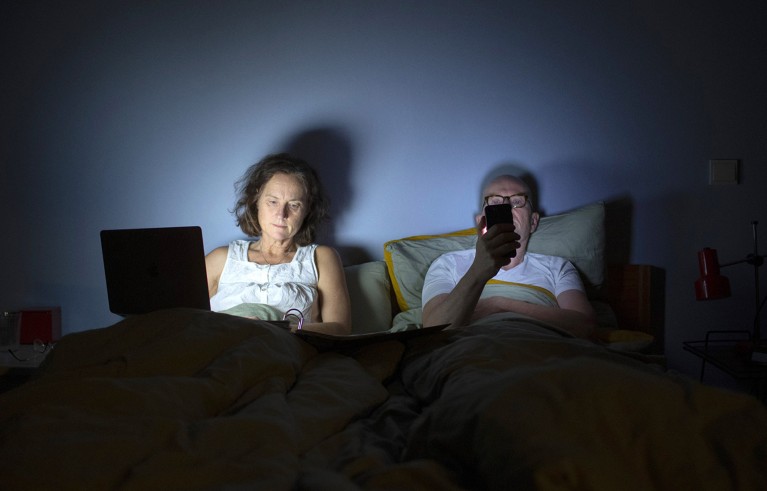
People who had access to the Internet scored higher on measures of life satisfaction in a global survey. Credit: Ute Grabowsky/Photothek via Getty
A global, 16-year study 1 of 2.4 million people has found that Internet use might boost measures of well-being, such as life satisfaction and sense of purpose — challenging the commonly held idea that Internet use has negative effects on people’s welfare.
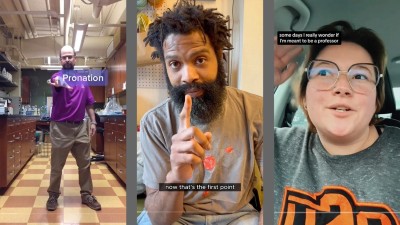
US TikTok ban: how the looming restriction is affecting scientists on the app
“It’s an important piece of the puzzle on digital-media use and mental health,” says psychologist Markus Appel at the University of Würzburg in Germany. “If social media and Internet and mobile-phone use is really such a devastating force in our society, we should see it on this bird’s-eye view [study] — but we don’t.” Such concerns are typically related to behaviours linked to social-media use, such as cyberbullying, social-media addiction and body-image issues. But the best studies have so far shown small negative effects, if any 2 , 3 , of Internet use on well-being, says Appel.
The authors of the latest study, published on 13 May in Technology, Mind and Behaviour , sought to capture a more global picture of the Internet’s effects than did previous research. “While the Internet is global, the study of it is not,” said Andrew Przybylski, a researcher at the University of Oxford, UK, who studies how technology affects well-being, in a press briefing on 9 May. “More than 90% of data sets come from a handful of English-speaking countries” that are mostly in the global north, he said. Previous studies have also focused on young people, he added.
To address this research gap, Pryzbylski and his colleagues analysed data on how Internet access was related to eight measures of well-being from the Gallup World Poll , conducted by analytics company Gallup, based in Washington DC. The data were collected annually from 2006 to 2021 from 1,000 people, aged 15 and above, in 168 countries, through phone or in-person interviews. The researchers controlled for factors that might affect Internet use and welfare, including income level, employment status, education level and health problems.
Like a walk in nature
The team found that, on average, people who had access to the Internet scored 8% higher on measures of life satisfaction, positive experiences and contentment with their social life, compared with people who lacked web access. Online activities can help people to learn new things and make friends, and this could contribute to the beneficial effects, suggests Appel.
The positive effect is similar to the well-being benefit associated with taking a walk in nature, says Przybylski.
However, women aged 15–24 who reported having used the Internet in the past week were, on average, less happy with the place they live, compared with people who didn’t use the web. This could be because people who do not feel welcome in their community spend more time online, said Przybylski. Further studies are needed to determine whether links between Internet use and well-being are causal or merely associations, he added.
The study comes at a time of discussion around the regulation of Internet and social-media use , especially among young people. “The study cannot contribute to the recent debate on whether or not social-media use is harmful, or whether or not smartphones should be banned at schools,” because the study was not designed to answer these questions, says Tobias Dienlin, who studies how social media affects well-being at the University of Vienna. “Different channels and uses of the Internet have vastly different effects on well-being outcomes,” he says.
doi: https://doi.org/10.1038/d41586-024-01410-z
Vuorre, M. & Przybylski, A. K. Technol. Mind Behav . https://doi.org/10.1037/tmb0000127 (2024).
Article Google Scholar
Heffer, T. et al. Clin. Psychol. Sci. 7 , 462–470 (2018).
Coyne, S. M., Rogers, A. A., Zurcher, J. D., Stockdale, L. & Booth, M. Comput. Hum. Behav . 104 , 106160 (2020).
Download references
Reprints and permissions
Related Articles

- Public health

How does ChatGPT ‘think’? Psychology and neuroscience crack open AI large language models
News Feature 14 MAY 24

Daniel Kahneman obituary: psychologist who revolutionized the way we think about thinking
Obituary 03 MAY 24

Pandemic lockdowns were less of a shock for people with fewer ties
Research Highlight 01 MAY 24

Could bird flu in cows lead to a human outbreak? Slow response worries scientists
News 17 MAY 24

Neglecting sex and gender in research is a public-health risk
Comment 15 MAY 24
Interpersonal therapy can be an effective tool against the devastating effects of loneliness
Correspondence 14 MAY 24
Inequality is bad — but that doesn’t mean the rich are
Postdoc in CRISPR Meta-Analytics and AI for Therapeutic Target Discovery and Priotisation (OT Grant)
APPLICATION CLOSING DATE: 14/06/2024 Human Technopole (HT) is a new interdisciplinary life science research institute created and supported by the...
Human Technopole
Research Associate - Metabolism
Houston, Texas (US)
Baylor College of Medicine (BCM)
Postdoc Fellowships
Train with world-renowned cancer researchers at NIH? Consider joining the Center for Cancer Research (CCR) at the National Cancer Institute
Bethesda, Maryland
NIH National Cancer Institute (NCI)
Faculty Recruitment, Westlake University School of Medicine
Faculty positions are open at four distinct ranks: Assistant Professor, Associate Professor, Full Professor, and Chair Professor.
Hangzhou, Zhejiang, China
Westlake University

PhD/master's Candidate
PhD/master's Candidate Graduate School of Frontier Science Initiative, Kanazawa University is seeking candidates for PhD and master's students i...
Kanazawa University
Sign up for the Nature Briefing newsletter — what matters in science, free to your inbox daily.
Quick links
- Explore articles by subject
- Guide to authors
- Editorial policies

- Liberty University
- Jerry Falwell Library
- Special Collections
- < Previous
Home > ETD > Doctoral > 5556
Doctoral Dissertations and Projects
The effects of online learning on mental health during a pandemic.
Christina J. McRae , Liberty University Follow
School of Behavioral Sciences
Doctor of Philosophy in Psychology (PhD)
Margaret Teresa Gopaul
Online learning, pandemic, mental health, adolescents, academic performance, physical activity, social isolation, food insecurity and other stressors, pros and cons, and religion and mental health, parent involvement, teacher preparedness, teacher availability, flexibility, anxiety, depression, resiliency, coping skills, awareness
Disciplines
Recommended citation.
McRae, Christina J., "The Effects of Online Learning on Mental Health During a Pandemic" (2024). Doctoral Dissertations and Projects . 5556. https://digitalcommons.liberty.edu/doctoral/5556
This study investigated the effects of online learning on mental health. The focus included six aspects: academic performance, physical activity, social isolation, food insecurity and other stressors, pros and cons, and religion and mental health. Each aspect included advantages and disadvantages that adolescent students experienced. The study included 6th - 12th graders attending a Charter school. The eligibility requirement was that participants participated in online learning during the 2020-2021 school year. Academic performance data was obtained from the school office for students who attended the school during online learning and requested from parents if they attended other schools. Both positive and negative effects of factors were obtained using online questionnaires, which were reviewed during in-person interviews to investigate what challenges students experienced and how online learning effected mental health. Parents of student participants and current teachers were recruited and administered a short questionnaire to obtain their perspectives and observations of the six aspects. Results showed that students adapted and used alternative methods to limit negative issues to mental health. Academic performance was maintained, despite students feeling they struggled. Physical activity and food insecurity and other stressors were not a noticeable issue. Students reported both pros – flexibility, sleeping in, self-paced schedule - and cons – social isolation, technology glitches, lack of teacher connection. Students showed resiliency and self-initiative attitudes in finding alternative methods to persevere through the cons. Social isolation was reported as the most negative. Religion and mental health was not a factor in negative/positive effects.
Included in
Psychology Commons
- Collections
- Faculty Expert Gallery
- Theses and Dissertations
- Conferences and Events
- Open Educational Resources (OER)
- Explore Disciplines
Advanced Search
- Notify me via email or RSS .
Faculty Authors
- Submit Research
- Expert Gallery Login
Student Authors
- Undergraduate Submissions
- Graduate Submissions
- Honors Submissions
Home | About | FAQ | My Account | Accessibility Statement
Privacy Copyright

Essay on Negative Effects Of Technology On Health
Students are often asked to write an essay on Negative Effects Of Technology On Health in their schools and colleges. And if you’re also looking for the same, we have created 100-word, 250-word, and 500-word essays on the topic.
Let’s take a look…
100 Words Essay on Negative Effects Of Technology On Health
Too much screen time.
When we stare at screens like phones and computers for a long time, our eyes can get tired and sore. This is called eye strain. Kids might also find it hard to sleep if they use screens before bed because the light from the screen tricks their brains into thinking it’s still daytime.
Poor Posture and Pain
Sitting down and looking at a device for hours can make our backs and necks hurt. This happens because we often bend into uncomfortable positions and forget to move around. This can lead to bad posture and even cause pain in our bodies.
Less Physical Activity
Playing games or watching videos on a device can be fun, but it means we move less. Running, jumping, and playing outside keep our bodies healthy. If we spend too much time with technology, we might not get enough exercise, which is important for a strong heart and muscles.
Unhealthy Weight Gain
Not moving much and snacking while using devices can lead to weight gain. Eating without thinking when we are looking at a screen can make us eat more than our body needs. This can make it hard to stay at a healthy weight.
Mental Health Issues
Spending a lot of time on social media or playing stressful games can make some kids feel sad or worried. It’s important to balance screen time with activities that make us feel good, like spending time with friends and family or playing outside.
250 Words Essay on Negative Effects Of Technology On Health
When we use our phones, computers, or tablets for a long time, it can be bad for our eyes. Staring at screens can make our eyes tired and can cause headaches. This is because our eyes have to work hard to look at the bright light and small text on screens. It is important to take breaks and look at things far away to give our eyes a rest.
Technology can also make it hard for us to sleep well. The blue light from screens can trick our brains into thinking it’s still daytime, making it tough to fall asleep. Not getting enough sleep can make us feel tired and grumpy the next day. It’s good to stop using screens at least an hour before bed to help our brains get ready for sleep.
Not Enough Exercise
Playing outside or doing sports is great for our health. But sometimes, we might choose to play video games or watch TV instead. This means we sit still for too long and don’t move our bodies enough. Moving around is important to keep our muscles and bones strong and to stay fit.
Eating Unhealthy
Sometimes, when we are watching something interesting, we might eat snacks without thinking. This can lead to eating too much junk food, which is not good for our bodies. It’s better to eat snacks at a table without screens so we can pay attention to how much we are eating.
Mental Health
Lastly, using technology a lot can make us feel lonely or sad, especially if we spend more time online than with real people. Talking and playing with friends and family is very important for our happiness. We should try to balance the time we spend with technology and with others.
500 Words Essay on Negative Effects Of Technology On Health
Physical problems from too much screen time.
When we use our phones, computers, or tablets a lot, we can start to have physical problems. One common issue is eye strain. Staring at screens for too long can make our eyes tired and sore. It can even lead to headaches and trouble seeing clearly. Another problem is bad posture. Sitting hunched over a gadget for hours isn’t good for our backs or necks. It can cause pain and even long-term damage to our spine. Also, if we’re always sitting and not moving much, we might gain weight or get other health problems because our bodies need activity to stay healthy.
Too Little Sleep
Technology can also mess with our sleep, which is super important for our health. Bright screens can trick our brains into thinking it’s still daytime, so we don’t feel sleepy. If we use our devices at night, it can be harder to fall asleep and stay asleep. Not getting enough sleep can make us feel grumpy, have trouble thinking, and weaken our immune system, which helps us fight off sickness.
Mental Health Struggles
Our minds can be hurt by technology, too. Social media can make us feel bad about ourselves if we think everyone else’s life looks perfect and ours doesn’t. It can also make us feel lonely if we’re scrolling instead of talking to people face-to-face. Sometimes, the things we see online can make us scared or sad, and those feelings can stick with us even after we turn off our devices.
Less Exercise and Outdoor Time
When we’re glued to our screens, we’re not running around outside or playing sports as much. Our bodies need to move to be strong and healthy. Plus, being outside in the fresh air and nature is good for our mood and helps us feel calm. Without enough exercise and outdoor time, we might not be as fit, and we might feel more stressed or anxious.
Bad Habits and Safety Risks
Using technology a lot can lead to some risky habits. For example, looking at your phone while walking can cause accidents, like bumping into things or even walking into the street without looking. Also, if we’re always reaching for our phone or gaming console, we might not be learning other important skills, like cooking or making things with our hands.
Technology is a big part of our lives, and it can be really helpful. But it’s important to remember that using it too much can be bad for our health. We should try to take breaks from screens, get plenty of sleep, spend time with friends and family in person, and play outside. By finding a good balance, we can enjoy technology without letting it hurt our health.
That’s it! I hope the essay helped you.
If you’re looking for more, here are essays on other interesting topics:
- Essay on Negative Effects Of Social Media On Mental Health
- Essay on Fashion Among Students
- Essay on Nature And Technology
Apart from these, you can look at all the essays by clicking here .
Happy studying!
Leave a Reply Cancel reply
Your email address will not be published. Required fields are marked *
Save my name, email, and website in this browser for the next time I comment.

385-254-3522
Stay up to date with Therapy Utah

The Impact of Heavy Technology Use on Mental Health: Understanding the Risks
Kathy kinghorn, june 27, 2023, individual therapy | mental illness | treatment options.
- Prolonged technology use can lead to physical health problems such as back pain, neck pain, and headaches, as well as mental health problems such as anxiety, depression, and social isolation.
- Heavy use of social media has been linked to sleep issues and decreased self-esteem. It may also increase the risk of developing mental health issues such as anxiety and depression.
- Professional help can be an effective tool for overcoming the stress and side effects created by heavy technology use. Contact Therapy Utah to be matched with a therapist who can provide support, coping strategies, and tools to help you manage these challenges.
The world we live in today is heavily reliant on technology. From smartphones to laptops, we use technology for work, entertainment, and communication. But while technology has brought many benefits to our lives, it can also have negative effects on our physical and mental health.
Therapy Utah has helped a wide range of people adversely affected by technology use through our individual therapy services , so we’re extremely familiar with the most common problems it causes and the best ways to address them. In this article, we will discuss some of the risks associated with prolonged technology use and offer strategies to help mitigate these risks.
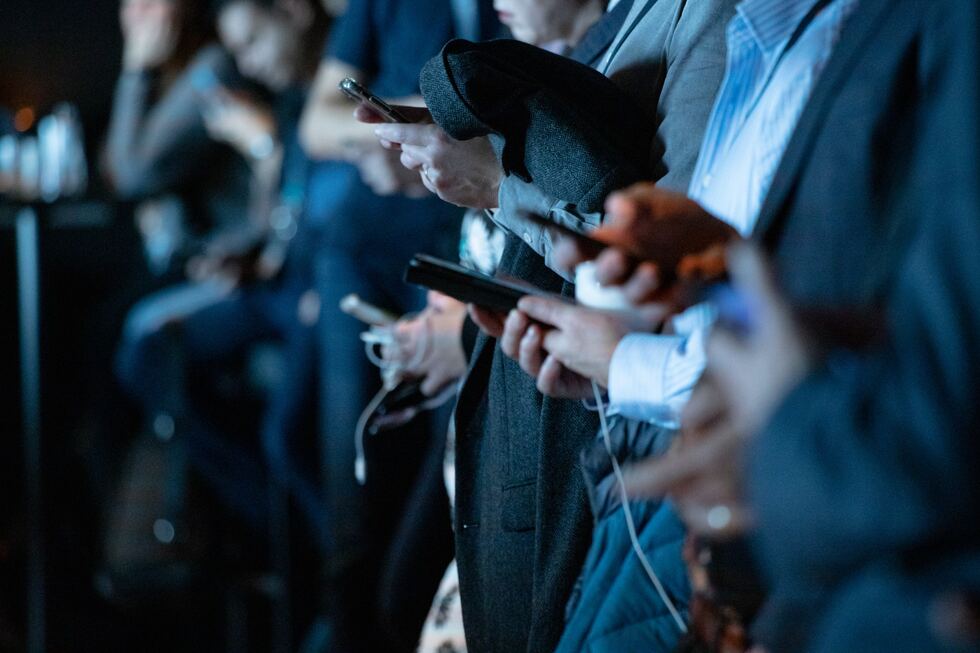
Via Unsplash .
The Main Risks of Prolonged Technology Use
Negative mental health effects.
Prolonged technology use can lead to mental health problems such as anxiety, depression, and social isolation. Heavy use of social media has been linked to decreased self-esteem and an increased risk of developing mental health issues . Studies have also found that individuals who spend more time on social media are more likely to experience symptoms of anxiety and depression . Additionally, poor sleep caused by technology use can exacerbate any mental health issues that are already present.
Negative Physical Impacts
Prolonged technology use can also lead to physical health problems—and since physical challenges can have a significant impact on your overall well-being and mood, it’s important to consider how they might affect your mental health by proxy. Common physical side-effects from heavy tech use include:
Some of these problems are caused by poor posture and excessive screen time, while others result from looking at screens for extended periods of time. The blue light emitted by screens can also interfere with our circadian rhythm and make it difficult to fall asleep, which can result in insomnia and poor sleep quality.
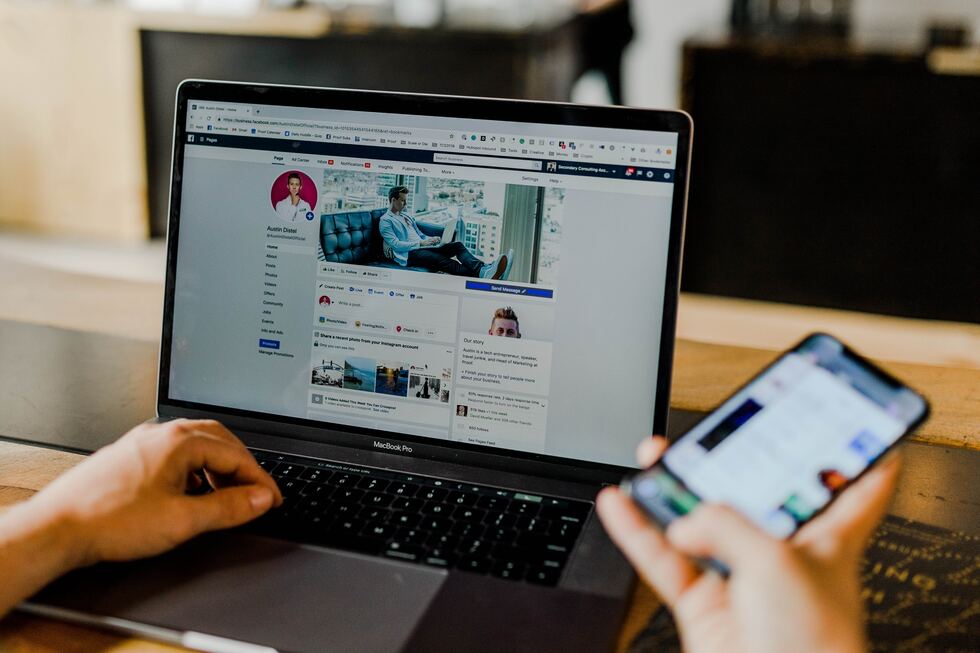
How & Why Heavy Technology Use Impacts Mental Health
Social media use has been linked to increased symptoms of anxiety and depression. When individuals use social media, they are often exposed to images of people living seemingly perfect lives, which can make them feel inadequate or inferior. This can exacerbate feelings of anxiety and depression, as individuals may feel like they are not living up to the standards set by others on social media.
As noted above, another reason for the link between prolonged technology use and anxiety and depression is the impact of blue light on our sleep patterns. The blue light emitted by screens can interfere with our natural circadian rhythms, which can lead to sleep disturbances and poor sleep quality. Poor sleep has been linked to mental health issues, including anxiety and depression.
Cyberbullying and online harassment are also potential risks associated with heavy technology use. Social media can be a source of cyberbullying and harassment, which can lead to anxiety and depression. The anonymity of the internet can make it easier for people to engage in negative behaviors, and the constant access to social media platforms can make it difficult for victims to escape the harassment.
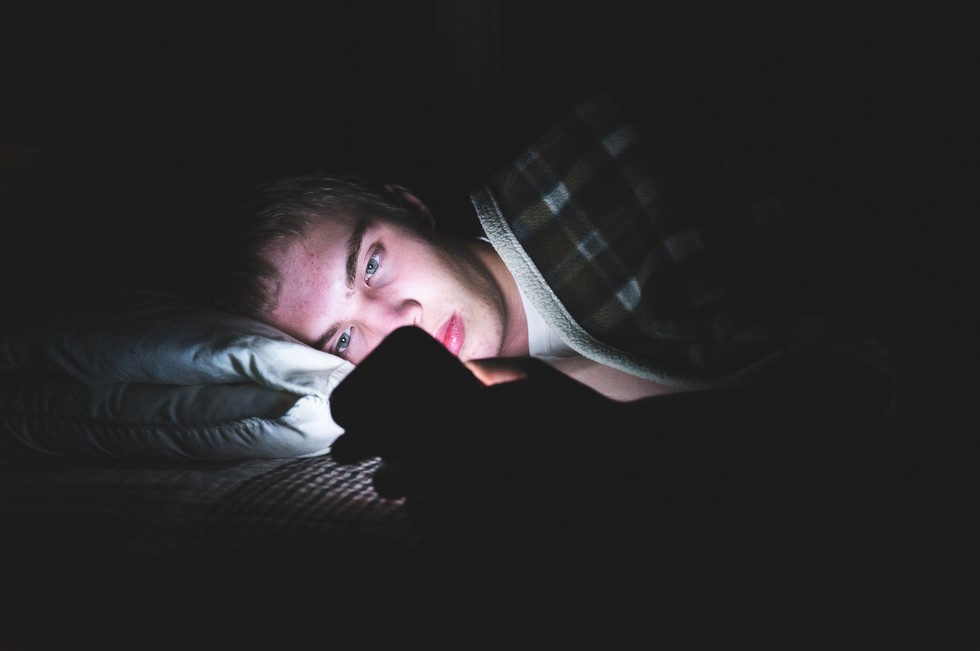
Strategies to Mitigate Risks of Prolonged Technology Use
To mitigate the negative effects of heavy technology use on mental health, it is important to adopt strategies for managing our technology habits. Additionally, it is important to be mindful of the impact of social media on mental health and to remember that social media often presents an unrealistic and curated version of reality. Here are some strategies we recommend:
- Take Breaks: One of the most effective ways to mitigate the risks of prolonged technology use is to take frequent breaks. We recommend taking a 10-15 minute break every hour to stretch, stand up and walk around.
- Use the 20-20-20 Rule: Another strategy to reduce eye strain is to use the 20-20-20 rule. Every 20 minutes, look away from your screen and focus on an object that is 20 feet away for 20 seconds.
- Exercise Regularly: Exercise is essential for maintaining good physical and mental health. Regular exercise can help reduce stress and anxiety and improve sleep quality.
- Practice Good Posture: Poor posture can cause physical health problems such as neck and back pain. When using technology, it is important to practice good posture by sitting up straight and keeping your shoulders relaxed.
- Set Limits on Screen Time: Setting limits on screen time can help reduce the risks associated with prolonged technology use. Experts recommend limiting screen time to no more than two hours per day for children and teenagers.

Finding Support for a Healthier Relationship with Social Media
While technology has brought many benefits to our lives, it is important to be aware of the risks associated with prolonged technology use. By adopting healthy technology habits and prioritizing our mental health, we can reduce the negative impact of technology on our physical and mental well-being.
It’s ultimately up to each of us as individuals to take responsibility for our own technology habits and to make conscious choices to ensure that technology use does not negatively impact their mental health. However, doing this alone can be difficult—so seeking professional support is a valid and effective way to set and practice social media habits that support your mental health.
At Therapy Utah, we understand the unique challenges of balancing technology use with mental health. Our therapists can help you develop healthy technology habits and reduce the negative impact of heavy technology use on your day-to-day life. Whether you are struggling with anxiety, depression, or other mental health issues, we are here to support you on your journey towards wellness. Contact us now to speak with a team member who can help you find an ideal therapeutic match.
Recent Posts

What Are the Stages of Betrayal Trauma?
Betrayal trauma occurs when someone we deeply trust breaks that trust in a significant way. This can be emotionally shattering, leaving individuals to grapple with intense feelings of hurt and confusion. Betrayal trauma not only affects emotional well-being but can...

5 Common Sex Addiction Withdrawal Symptoms
Sex addiction, while not officially listed in the DSM, is a condition characterized by an excessive preoccupation with sexual thoughts and behaviors that continues despite risks and negative consequences. Withdrawal from sex addiction involves a range of symptoms,...

7 Ways of Preventing Burnout in Women
Therapy Utah recognizes the essential role mental health plays in women's lives. In this article, we explore the unique mental health challenges women face and present ideas on how to address them. Our individual therapy services provide essential resources for women...
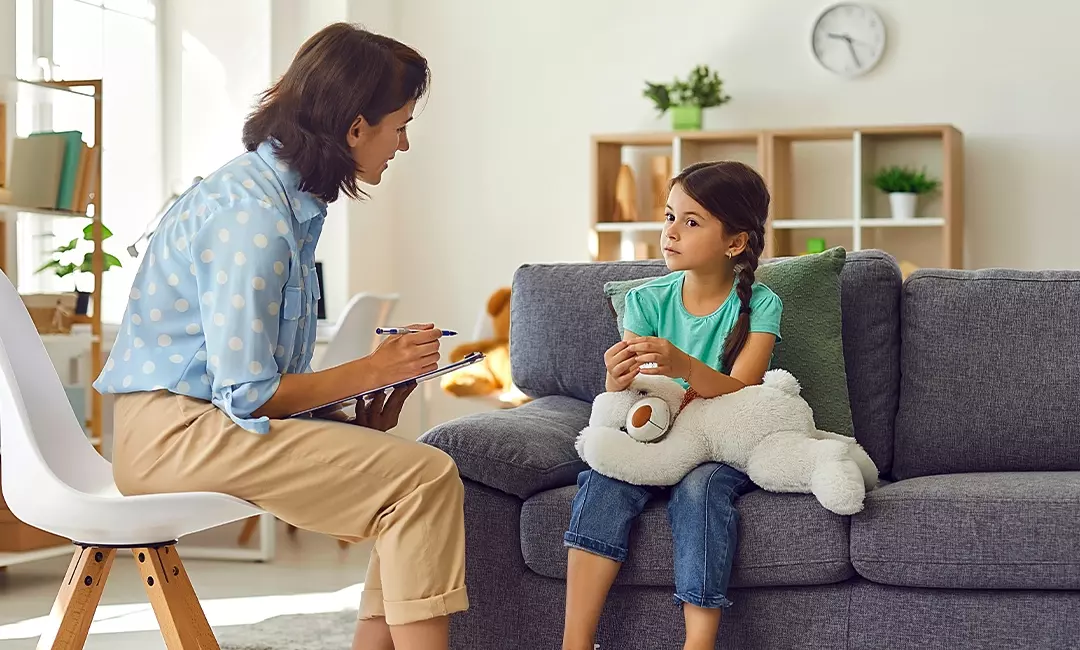
Is ART Therapy for Kids Okay?
Therapy Utah knows that there are many ways to support a child’s life and many ways to reduce negative experiences. ART (Accelerated Resolution Therapy) is one of the treatment techniques and methods we utilize in the world of pediatric mental health. Our adolescent...

Is Women’s Mental Health Taken Seriously Enough?

Maintaining Your Mental Health During the Holidays
Summary The holidays can bring about stress from family dynamics, financial pressures, unrealistic expectations, overcommitment, and experiences of grief or loss. It's crucial to recognize and manage these stressors to maintain mental health. Practical strategies to...
Related Posts

by Kathy Kinghorn
Betrayal trauma occurs when someone we deeply trust breaks that trust in a significant way. This can be emotionally shattering, leaving individuals to grapple with intense feelings of hurt and...

by Brannon Patrick
Sex addiction, while not officially listed in the DSM, is a condition characterized by an excessive preoccupation with sexual thoughts and behaviors that continues despite risks and negative...

Therapy Utah recognizes the essential role mental health plays in women's lives. In this article, we explore the unique mental health challenges women face and present ideas on how to address them....

Internet use statistically associated with higher wellbeing, finds new global Oxford study
Links between internet adoption and wellbeing are likely to be positive, despite popular concerns to the contrary, according to a major new international study from researchers at the Oxford Internet Institute, part of the University of Oxford.
The study encompassed more than two million participants psychological wellbeing from 2006-2021 across 168 countries, in relation to internet use and psychological well-being across 33,792 different statistical models and subsets of data, 84.9% of associations between internet connectivity and wellbeing were positive and statistically significant.
The study analysed data from two million individuals aged 15 to 99 in 168 countries, including Latin America, Asia, and Africa and found internet access and use was consistently associated with positive wellbeing.
Assistant Professor Matti Vuorre, Tilburg University and Research Associate, Oxford Internet Institute and Professor Andrew Przybylski, Oxford Internet Institute carried out the study to assess how technology relates to wellbeing in parts of the world that are rarely studied.
Professor Przybylski said: 'Whilst internet technologies and platforms and their potential psychological consequences remain debated, research to date has been inconclusive and of limited geographic and demographic scope. The overwhelming majority of studies have focused on the Global North and younger people thereby ignoring the fact that the penetration of the internet has been, and continues to be, a global phenomenon'.
'We set out to address this gap by analysing how internet access, mobile internet access and active internet use might predict psychological wellbeing on a global level across the life stages. To our knowledge, no other research has directly grappled with these issues and addressed the worldwide scope of the debate.'
The researchers studied eight indicators of well-being: life satisfaction, daily negative and positive experiences, two indices of social well-being, physical wellbeing, community wellbeing and experiences of purpose.
Commenting on the findings, Professor Vuorre said, “We were surprised to find a positive correlation between well-being and internet use across the majority of the thousands of models we used for our analysis.”
Whilst the associations between internet access and use for the average country was very consistently positive, the researchers did find some variation by gender and wellbeing indicators: The researchers found that 4.9% of associations linking internet use and community well-being were negative, with most of those observed among young women aged 15-24yrs.
Whilst not identified by the researchers as a causal relation, the paper notes that this specific finding is consistent with previous reports of increased cyberbullying and more negative associations between social media use and depressive symptoms among young women.
Adds Przybylski, 'Overall we found that average associations were consistent across internet adoption predictors and wellbeing outcomes, with those who had access to or actively used the internet reporting meaningfully greater wellbeing than those who did not'.
'We hope our findings bring some greater context to the screentime debate however further work is still needed in this important area. We urge platform providers to share their detailed data on user behaviour with social scientists working in this field for transparent and independent scientific enquiry, to enable a more comprehensive understanding of internet technologies in our daily lives.'
In the study, the researchers examined data from the Gallup World Poll, from 2,414,294 individuals from 168 countries, from 2006-2021. The poll assessed well-being with face-to-face and phone surveys by local interviewers in the respondents’ native languages. The researchers applied statistical modelling techniques to the data using wellbeing indicators to test the association between internet adoption and wellbeing outcomes.
Watch the American Psychological Association (APA) video highlighting the key findings from the research.
Download the paper ‘ A multiverse analysis of the associations between internet use and well-being ’ published in the journal Technology, Mind and Behaviour, American Psychological Association.
DISCOVER MORE
- Support Oxford's research
- Partner with Oxford on research
- Study at Oxford
- Research jobs at Oxford
You can view all news or browse by category
More From Forbes
How ai and technology can impact mental health care.
- Share to Facebook
- Share to Twitter
- Share to Linkedin
Vice President / GM Health, Education and Consumer Industries at Intel Corporation.
The question was simple: If you or someone you know has been impacted by mental health issues, could you please stand up? Every. Single. Person. Stood up. Including me.
The 350 University of Maryland Xplore Summit attendees—students, administrators, government leaders, investors and successful entrepreneurs—all stood up. It was an inspiring moment during my recent travels, and it solidified my belief that mental health has emerged as a significant challenge that has to be talked about and addressed.
In the past two months, I met with executives from nearly 200 different companies and visited several universities. The topic of mental wellness came up in at least 90% of the discussions. I honestly was shocked. Count me in with the group of people who were out of touch on this growing issue. The ever-increasing mental health issue has gotten bad enough that the education space—along with enterprise businesses from health care to retail—is starting to see it as a top concern.
The impacts of businesses not addressing mental health can have far-reaching implications. Employees are more likely to take sick leave, and untreated mental health conditions can result in higher turnover rates . Productivity goes down, and employee healthcare costs go up. More troubling is sinking employee morale. This low morale is being seen in fields such as nursing today, where both the suicide rates and the resignation rates remain incredibly high. It is not a pretty picture.
Ghost Of Tsushima Is Already Flooded With Negative Reviews On Steam
This is a big deal congress suddenly hurtling toward a crucial crypto vote that could blow up the price of bitcoin ethereum and xrp, los angeles da condemns extremely disturbing sean diddy combs video but won t bring charges here s why, technology, conflict and global pandemics as the disruptors.
I’m a student of history. I can’t help drawing parallels to another time in near history when this level of mental health became a top concern.
We know the Industrial Revolution reshaped the world. The rapid changes brought about by the revolution disrupted traditional social structures and ways of life. People experienced a sense of dislocation and alienation as they struggled to adapt to new norms. Massive outbreaks of cholera and influenza —much like the Covid-19 pandemic—impacted everyone. Wars and regional conflicts threatened social stability.
It is interesting to note that research shows the impact of untreated mental health issues from this time still exists today in and around big industrial centers from the 1800s. The cost of not addressing mental health is not only the people experiencing challenges today; it carries over to future generations.
AI Technologies As A Catalyst For Good
Companies are taking proactive measures to address mental health issues. This includes offering mental health resources and support, implementing flexible work arrangements and promoting a culture of openness and understanding. Some companies have even appointed mental health officers or established employee assistance programs to provide counseling and support services.
But where I see the most significant impact—and hope for change—is the explosion of cutting-edge technologies, especially AI-related ones. We see more apps coming to market incorporating AI, natural language processing and machine learning that provide:
• Data-Driven Insights: The ability to transform unstructured data (such as social media posts, comments or reviews) into structured insights opens avenues for data-driven insights. Algorithms can tailor app content based on analysis of activities, mood patterns and behavior. Personalized recommendations can guide users toward relevant resources, coping strategies and exercises. For example, AI can identify irrational or negative thought patterns and guide how to reframe them. AI-enabled apps can also encourage positive behaviors by sending reminders, setting goals and tracking progress.
• Predictive Analytics: AI-driven chatbots can offer immediate support, answer questions and provide coping strategies. They can simulate conversations with a human therapist and are available 24/7. A therapist chatbot can detect a user’s feelings, engage in conversations, and offer emotional support. AI algorithms can also analyze large datasets to identify patterns and trends in mental health , enabling early intervention and targeted intervention.
• Sentiment Analysis: In addition to data-driven insights, AI algorithms can assess sentiment in user-generated content across social platforms. Apps can detect signs of distress, anxiety or depression by analyzing language patterns. When the app detects concerning language, it can offer crisis resources or connect users with a human counselor.
AI has the potential to offer better, more accessible and personalized solutions for mental health care. However, these apps are not a substitute for professional care, and more work and research are needed to test the safety and efficacy of AI-driven mental health solutions.
Challenges That Need To Be Addressed
The industry needs to move fast yet cautiously in this area, where AI will interact with people in their most emotionally vulnerable state. There is a proliferation of apps on the market, but we need to overcome multiple issues before the apps become part of a quantifiable solution.
• Privacy issues and security are big unknowns. Users need to be confident there are robust security protocols, data collection and sharing practices in place.
• Most apps currently lack clinically validated evidence of efficacy, and apps that have been scientifically evaluated are often unavailable to the public.
• There has been little quality control over the data used to train AI models. We need guardrails to ensure models are unbiased. Culturally sensitive is also essential. The models would be incredibly problematic if chatbots were trained by information and behaviors on social media and the internet.
• There is a wide range of options to navigate, from expert-recommended apps to potentially harmful ones. Not all apps are vetted by mental health experts and may provide inaccurate advice.
We need specialized, well-vetted and tested models in this area. This requires companies, universities and mental health specialists to work together to create these new AI-enhanced solutions. The confluence of science, innovation and inspiration is guaranteed to have an impact.
Forbes Technology Council is an invitation-only community for world-class CIOs, CTOs and technology executives. Do I qualify?

- Editorial Standards
- Reprints & Permissions
Numbers, Facts and Trends Shaping Your World
Read our research on:
Full Topic List
Regions & Countries
- Publications
- Our Methods
- Short Reads
- Tools & Resources
Read Our Research On:
Teens and Video Games Today
85% of u.s. teens say they play video games, and about four-in-ten do so daily. teens see both positive and negative sides of video games – from problem-solving and making friends to harassment and sleep loss, table of contents.
- Who plays video games?
- How often do teens play video games?
- What devices do teens play video games on?
- Social media use among gamers
- Teen views on how much they play video games and efforts to cut back
- Are teens social with others through video games?
- Do teens think video games positively or negatively impact their lives?
- Why do teens play video games?
- Bullying and violence in video games
- Appendix A: Detailed charts
- Acknowledgments
- Methodology
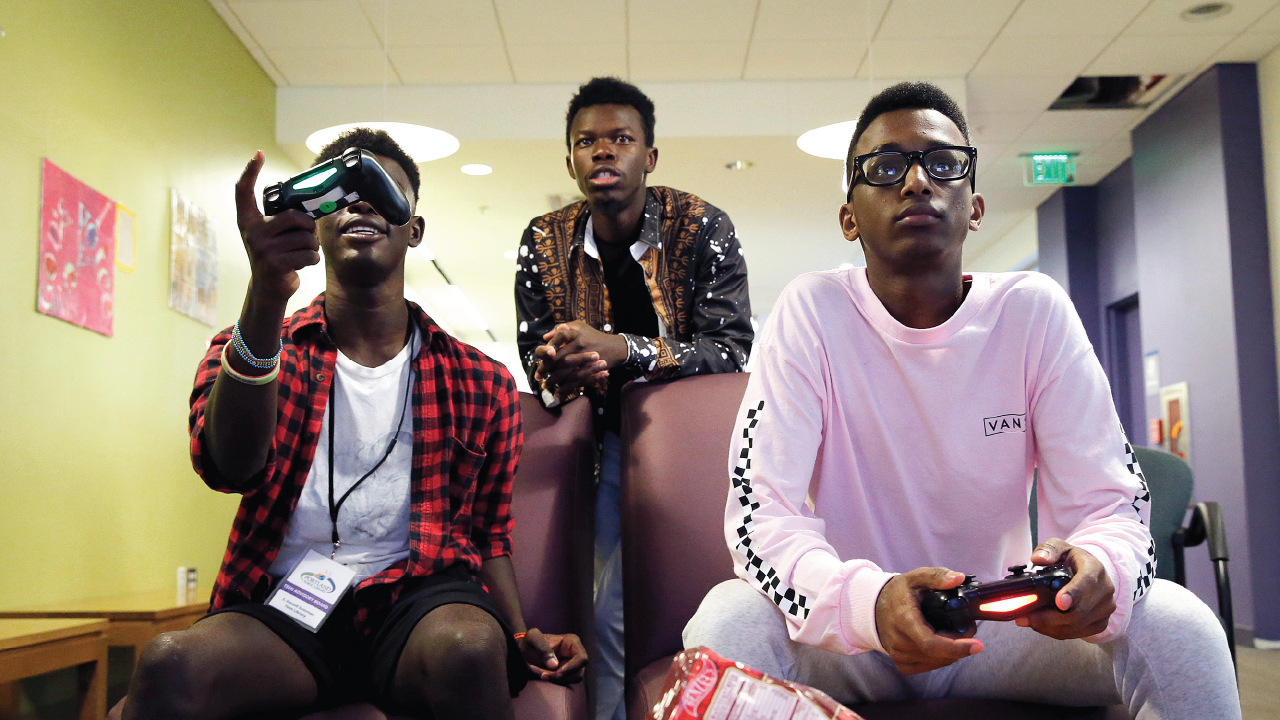
Pew Research Center conducted this analysis to better understand teens’ use of and experiences with video games.
The Center conducted an online survey of 1,453 U.S. teens from Sept. 26 to Oct. 23, 2023, through Ipsos. Ipsos recruited the teens via their parents, who were part of its KnowledgePanel . The KnowledgePanel is a probability-based web panel recruited primarily through national, random sampling of residential addresses. The survey was weighted to be representative of U.S. teens ages 13 to 17 who live with their parents by age, gender, race and ethnicity, household income, and other categories.
This research was reviewed and approved by an external institutional review board (IRB), Advarra, an independent committee of experts specializing in helping to protect the rights of research participants.
Here are the questions used for this analysis , along with responses, and its methodology .
There are long-standing debates about the impact of video games on youth. Some credit them for helping young people form friendships and teaching them about teamwork and problem-solving . Others say video games expose teenagers to violent content, negatively impact their sleep and can even lead to addiction.
With this in mind, Pew Research Center surveyed 1,423 U.S. teens ages 13 to 17 about their own video game habits – from how often they play to the friends they’ve made and whether it gets in the way of them doing well in school or getting a good night’s sleep. 1
Key findings from the survey
- Video games as a part of daily teen life: 85% of U.S. teens report playing video games, and 41% say they play them at least once a day. Four-in-ten identify as a gamer.
- Gaming as a social experience: 72% of teens who play video games say that a reason why they play them is to spend time with others. And some have even made a friend online from playing them – 47% of teen video game players say they’ve done this.
- Helpful with problem-solving, less so for sleep: Over half of teens who play video games say it has helped their problem-solving skills, but 41% also say it has hurt their sleep.
- Bullying is a problem: 80% of all teens think harassment over video games is a problem for people their age. And 41% of those who play them say they’ve been called an offensive name when playing.
- Boys’ and girls’ experiences differ: Most teen boys and girls play video games, but larger shares of boys identify as gamers (62% vs. 17%) and play every day (61% vs. 22%). Boys who play them are also more likely to experience positive things from it, like making friends, and more troubling things like harassment.
Jump to read about: Who plays video games | Socializing over video games | Views about video games’ impact | Harassment and violence in video games
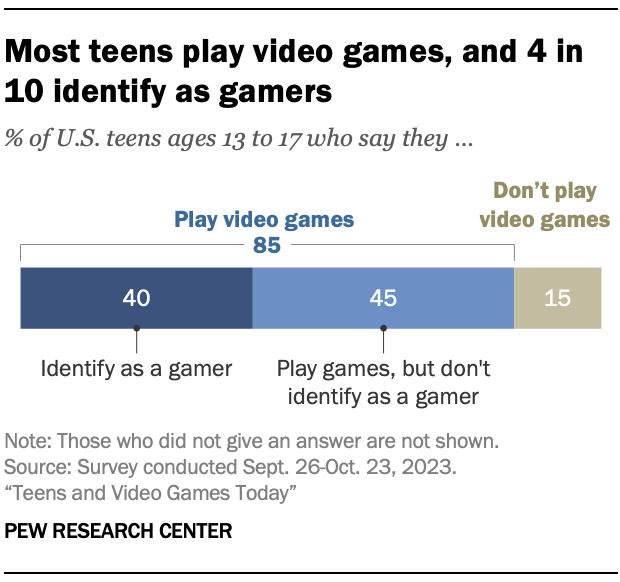
Playing video games is widespread among teens. The vast majority of U.S. teens (85%) say they play them. Just 15% say they never do, according to the survey conducted Sept. 26-Oct. 23, 2023.
In addition to asking whether teens play video games, we also wanted to learn whether they consider themselves gamers. Overall, four-in-ten U.S. teens think of themselves as gamers. Just under half of teens (45%) play video games but do not think of themselves as gamers.
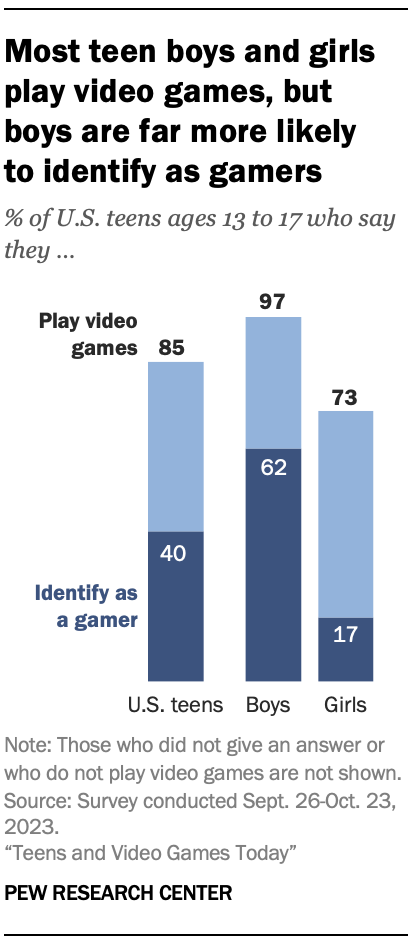
Nearly all boys (97%) say they play video games, compared with about three-quarters of teen girls. There is a substantial gap by gender in whether teens identify as gamers: 62% of teen boys do, compared with 17% of girls. 2
By gender and age
Younger teen girls are more likely than older girls to say they play video games: 81% of girls ages 13 to 14 compared with 67% of those ages 15 to 17. But among boys, nearly all play video games regardless of age.
Similar shares of teens play video games across different racial and ethnic groups and among those who live in households with different annual incomes. Go to Appendix A for more detail on which teens play video games and which teens identify as gamers.
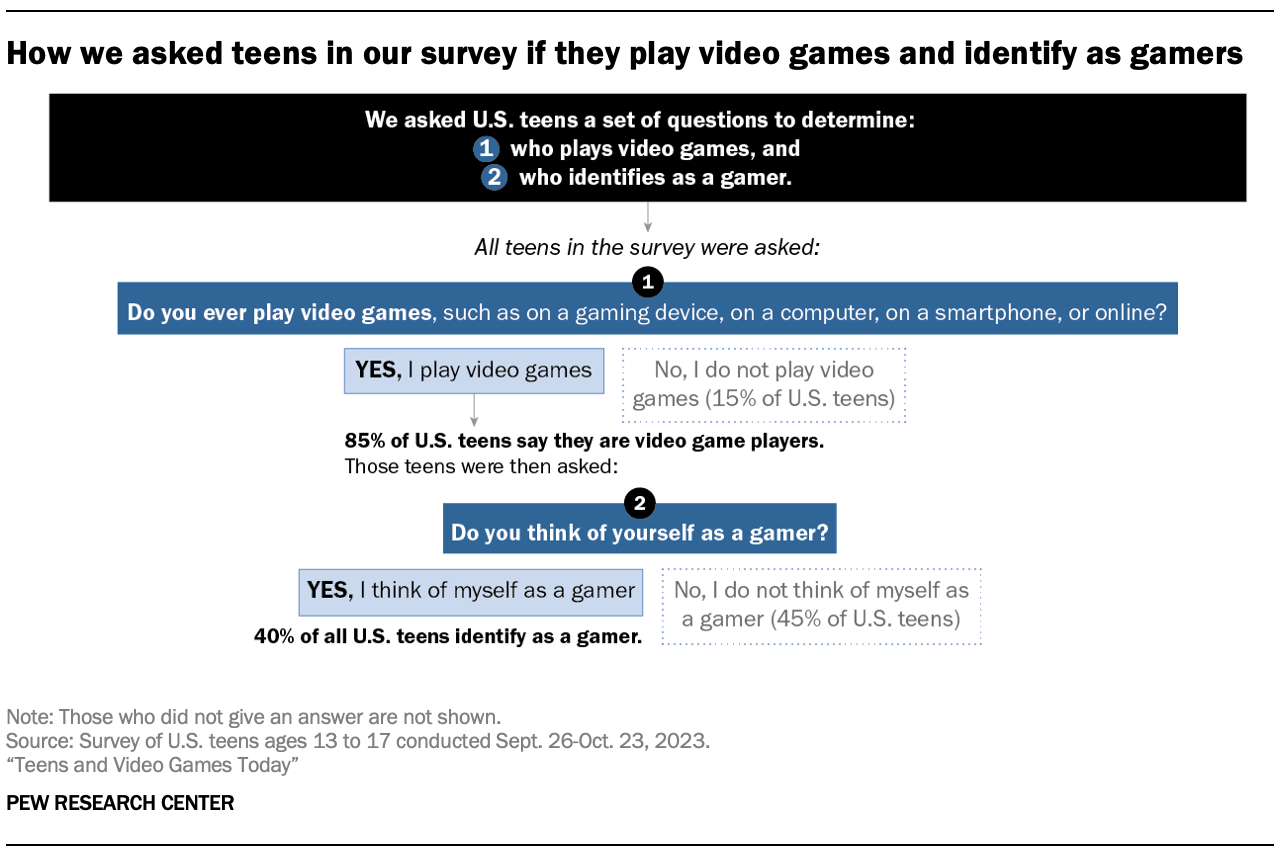
We also asked teens how often they play video games. About four-in-ten U.S. teens say they play video games daily, including 23% who do so several times a day.
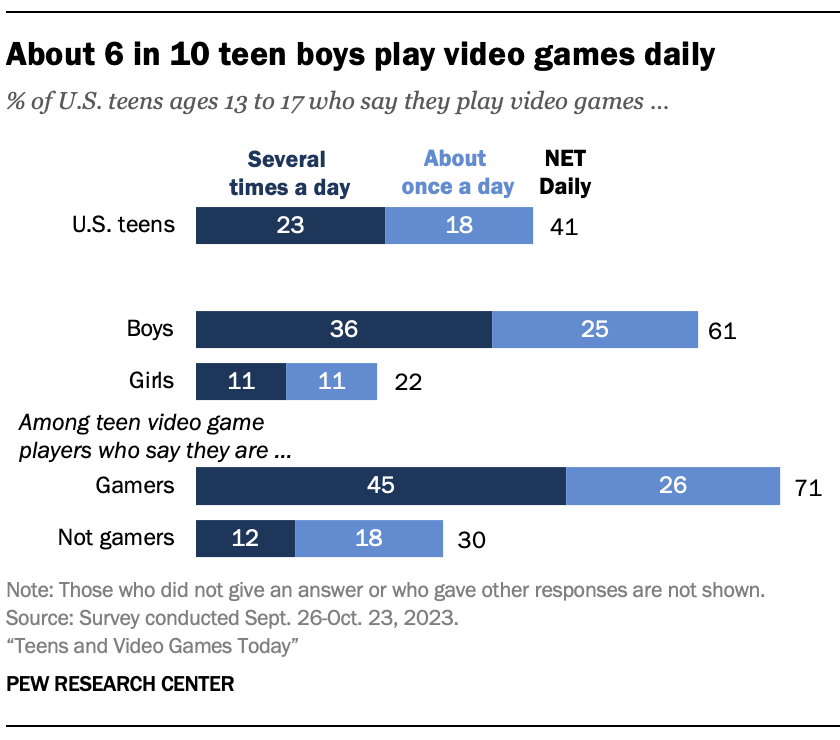
Another 22% say they play several times a week, while 21% play them about once a week or less.
Teen boys are far more likely than girls to say they play video games daily (61% vs. 22%). They are also much more likely to say they play them several times a day (36% vs. 11%).
By whether someone identifies as a gamer
About seven-in-ten teens who identify as gamers (71%) say they play video games daily. This drops to 30% among those who play them but aren’t gamers.
By household income
Roughly half of teens living in households with an annual income of less than $30,000 (53%) say they play video games at least daily. This is higher than those in households with an annual income of $30,000 to $74,999 (42%) and $75,000 or more (39%).
Go to Appendix A to see more details about who plays video games and identifies as a gamer by gender, age, race and ethnicity, and household income.
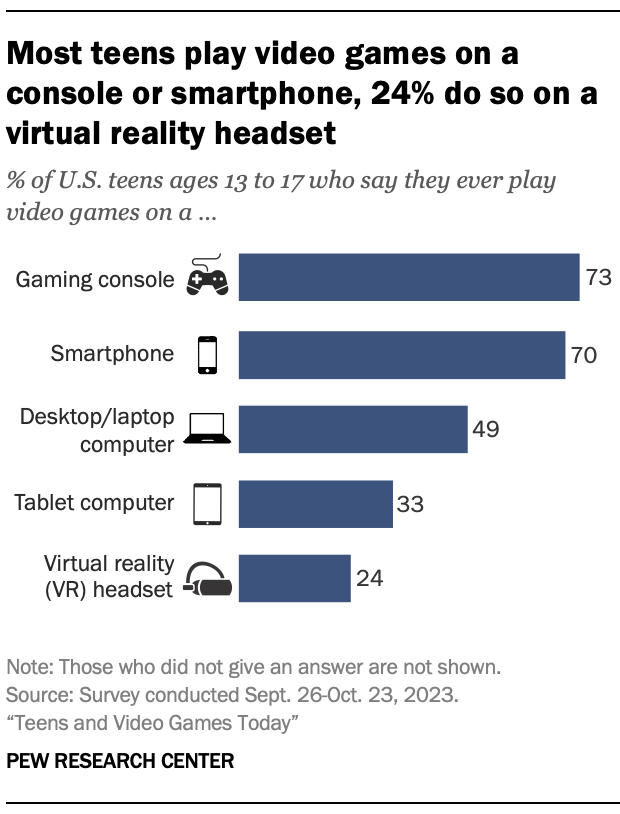
Most teens play video games on a gaming console or a smartphone. When asked about five devices, most teens report playing video games on a gaming console (73%), such as PlayStation, Switch or Xbox. And 70% do so on a smartphone. Fewer – though still sizable shares – play them on each of the following:
- 49% say they play them on a desktop or laptop computer
- 33% do so on a tablet
- 24% play them on a virtual reality (VR) headset such as Oculus, Meta Quest or PlayStation VR
Many teens play video games on multiple devices. About a quarter of teens (27%) do so on at least four of the five devices asked about, and about half (49%) play on two or three of them. Just 8% play video games on one device.
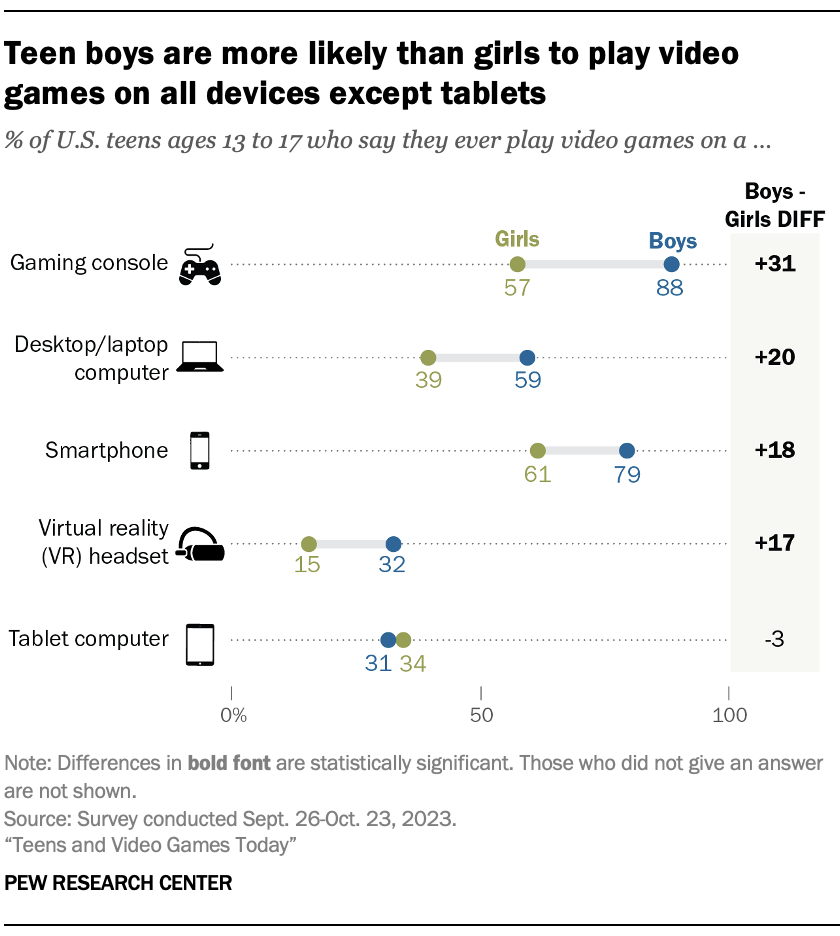
Teen boys are more likely than girls to play video games on four of the five devices asked about – all expect tablets. For instance, roughly nine-in-ten teen boys say they ever play video games on a gaming console, compared with 57% of girls. Equal shares of teen boys and girls play them on tablets.
Teens who consider themselves gamers are more likely than those who play video games but aren’t gamers to play on a gaming console (95% vs. 78%), desktop or laptop computer (72% vs. 45%) or a virtual reality (VR) headset (39% vs. 19%). Similar shares of both groups play them on smartphones and tablets.
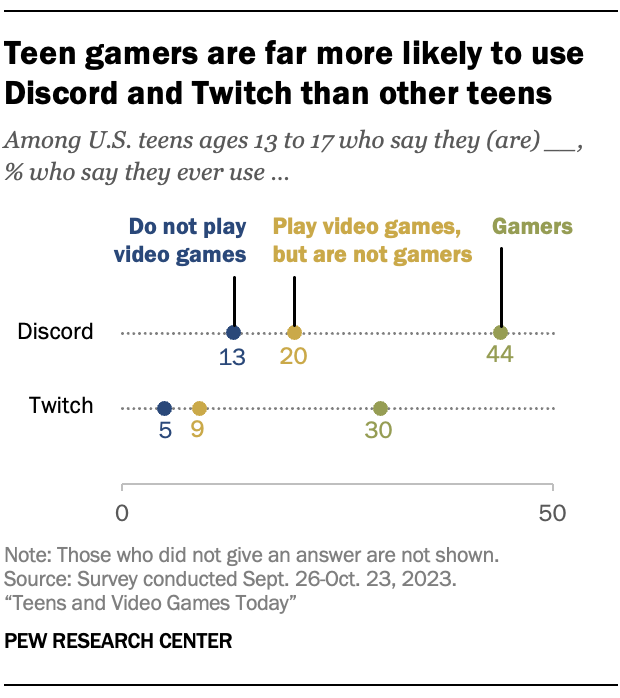
One way that teens engage with others about video games is through online platforms. And our survey findings show that teen gamers stand out for their use of two online platforms that are known for their gaming communities – Discord and Twitch :
- 44% of teen gamers say they use Discord, far higher than video game players who don’t identify as gamers or those who use the platform but do not play video games at all. About three-in-ten teens overall (28%) use Discord.
- 30% of teens gamers say they use Twitch. About one-in-ten other teens or fewer say the same; 17% of teens overall use the platform.
Previous Center research shows that U.S. teens use online platforms at high rates .
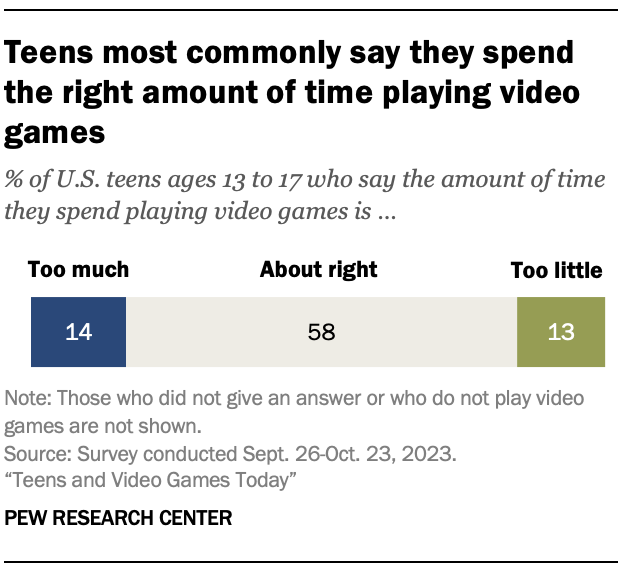
Teens largely say they spend the right amount of time playing video games. When asked about how much time they spend playing them, the largest share of teens (58%) say they spend the right amount of time. Far fewer feel they spend too much (14%) or too little (13%) time playing them.
Teen boys are more likely than girls to say they spend too much time playing video games (22% vs. 6%).
By race and ethnicity
Black (17%) and Hispanic (18%) teens are about twice as likely than White teens (8%) to say they spend too little time playing video games. 3
A quarter of teens who consider themselves gamers say they spend too much time playing video games, compared with 9% of those who play video games but don’t identify as gamers. Teen gamers are also less likely to think they spend too little time playing them (19% vs. 10%).
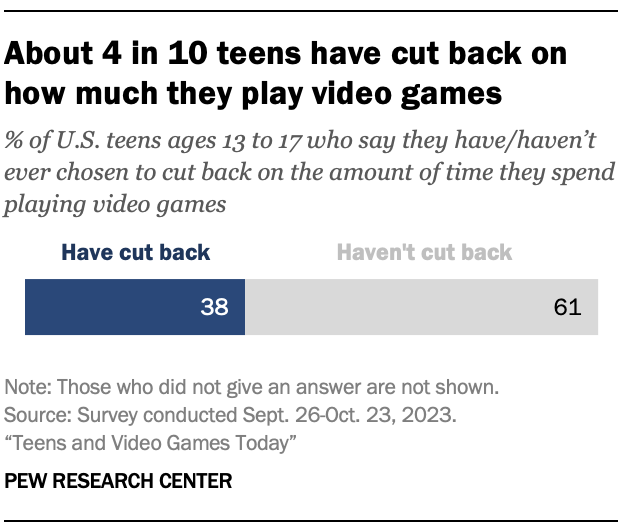
Fewer than half of teens have reduced how much they play video games. About four-in-ten (38%) say they have ever chosen to cut back on the amount of time they spend playing them. A majority (61%) report that they have not cut back at all.
This share is on par with findings about whether teenagers have cut back with their screen time – on social media or their smartphone.
Although boys are more likely to say they play video games too much, boys and girls are on par for whether they have ever cut back. About four-in-ten teen boys (39%) and girls (38%) say that they have ever cut back.
And gamers are as likely to say they have cut back as those who play video games but don’t identify as gamers (39% and 41%).
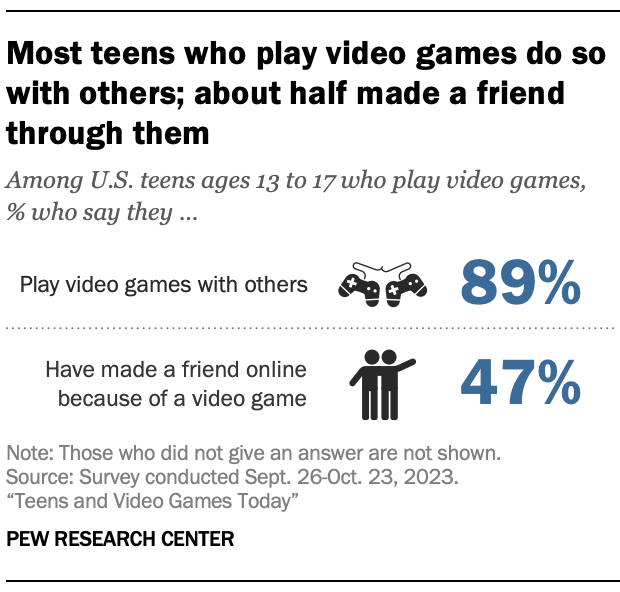
A main goal of our survey was to ask teens about their own experiences playing video games. For this section of the report, we focus on teens who say they play video games.
Socializing with others is a key part of the video game experience. Most teens who play video games do so with others, and some have developed friendships through them.
About nine-in-ten teen video game players (89%) say they play them with other people, in person or online. Far fewer (11%) play them only on their own.
Additionally, about half (47%) report that they have ever made a friend online because of a video game they both play. This equals 40% of all U.S. teens who have made a friend online because of a video game.
These experiences vary by:
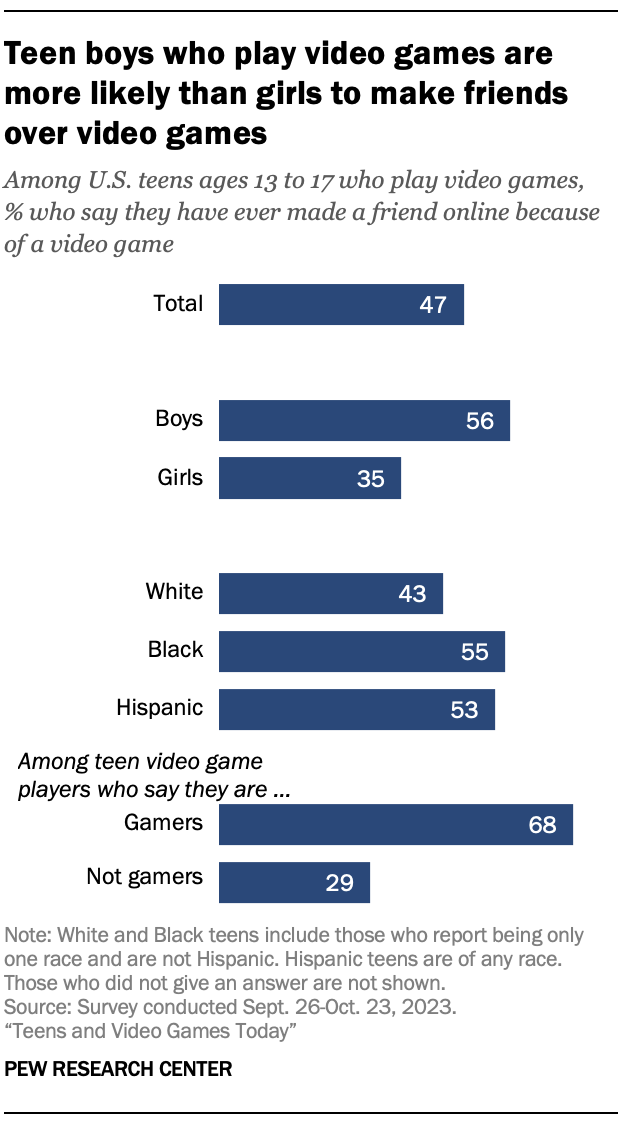
- Gender: Most teen boy and girl video game players play them with others, though it’s more common among boys (94% vs. 82%). Boys who play video games are much more likely to say they have made a friend online because of a video game (56% vs. 35%).
- Race and ethnicity: Black (55%) and Hispanic (53%) teen video game players are more likely than White teen video game players (43%) to say they have made a friend online because of them.
- Whether someone identifies as a gamer: Nearly all teen gamers report playing video games with others (98%). Fewer – though still most – of those who play video games but aren’t gamers (81%) also play them with others. And about seven-in-ten (68%) say they have made a friend online because of a video game, compared with 29% of those who play them but don’t identify as gamers.
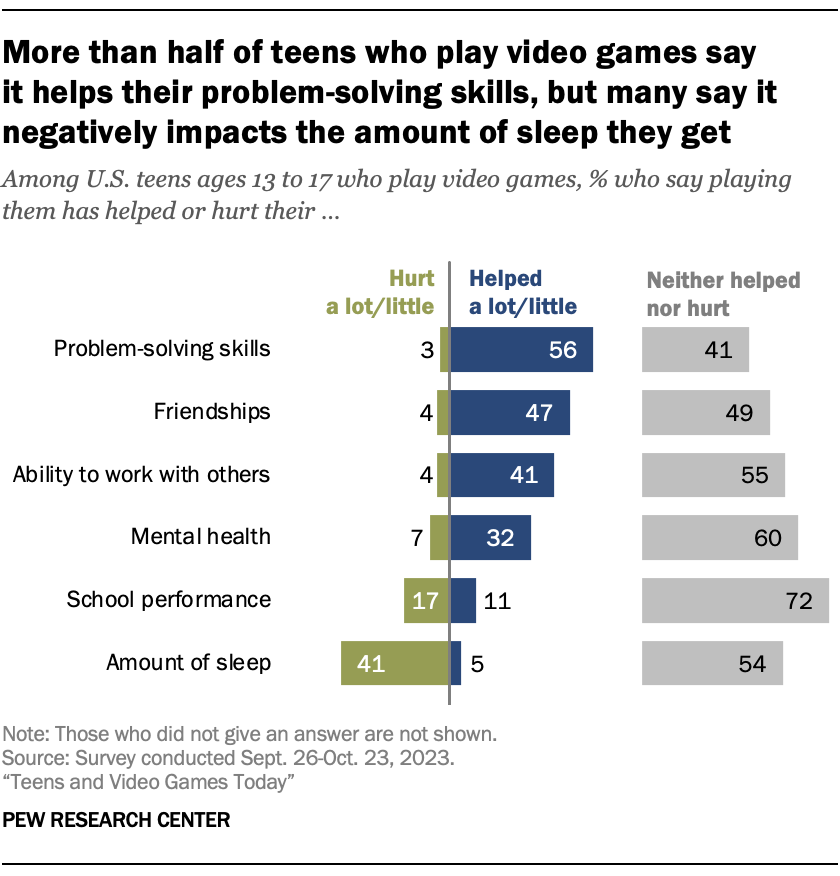
Teens who play video games are particularly likely to say video games help their problem-solving skills. More than half of teens who play video games (56%) say this.
Additionally, more think that video games help, rather than hurt, three other parts of their lives that the survey asked about. Among teens who play video games:
- Roughly half (47%) say it has helped their friendships
- 41% say it has helped how they work with others
- 32% say it has helped their mental health
No more than 7% say playing video games has hurt any of these.
More teens who play video games say it hurts, rather than helps, their sleep. Among these teens, 41% say it has hurt how much sleep they get, while just 5% say it helps. And small shares say playing video games has impacted how well they do in school in either a positive or a negative way.
Still, many teens who play video games think playing them doesn’t have much an impact in any of these areas. For instance, at least six-in-ten teens who play video games say it has neither a positive nor a negative impact on their mental health (60%) or their school performance (72%). Fewer (41%) say this of their problem-solving skills.
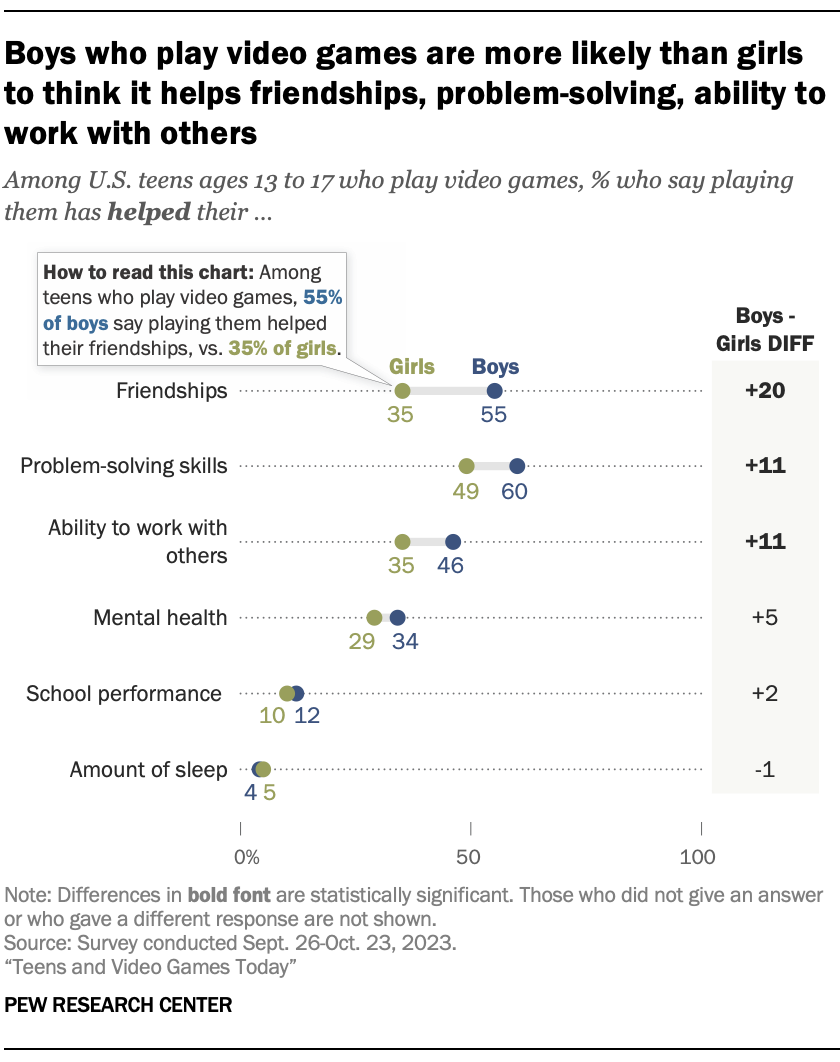
Teen boys who play video games are more likely than girls to think playing them has helped their problem-solving skills, friendships and ability to work with others. For instance, 55% of teen boys who play video games say this has helped their friendships, compared with 35% of teen girls.
As for ways that it may hurt their lives, boys who play them are more likely than girls to say that it has hurt the amount of sleep they get (45% vs. 37%) and how well they do in school (21% vs. 11%).
Teens who consider themselves gamers are more likely than those who aren’t gamers but play video games to say video games have helped their friendships (60% vs. 35%), ability to work with others (52% vs. 32%), problem-solving skills (66% vs. 47%) and mental health (41% vs. 24%).
Gamers, though, are somewhat more likely to say playing them hurt their sleep (48% vs. 36%) and how well they do in school (20% vs. 14%).
By whether teens play too much, too little or the right amount
Teens who report playing video games too much stand out for thinking video games have hurt their sleep and school performance. Two-thirds of these teens say it has hurt the amount of sleep they get, and 39% say it hurt their schoolwork. Far fewer of those who say they play the right amount (38%) or too little (32%) say it has hurt their sleep, or say it hurt their schoolwork (12% and 16%).
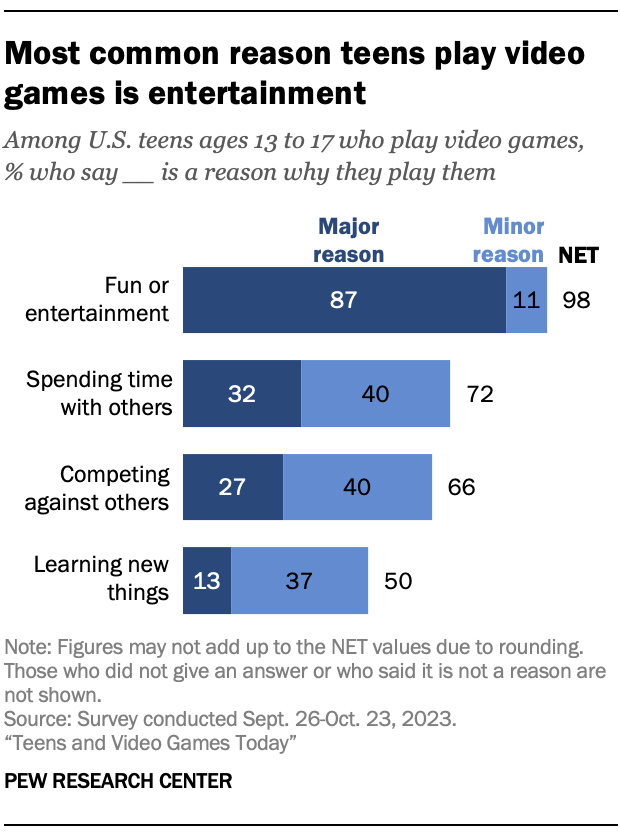
Teens who play video games say they largely do so to be entertained. And many also play them to be social with and interact with others. Teens who play video games were asked about four reasons why they play video games. Among those who play video games:
- Nearly all say fun or entertainment is a major or minor reason why they play video games – with a large majority (87%) saying it’s a major reason.
- Roughly three-quarters say spending time with others is a reason, and two-thirds say this of competing with others. Roughly three-in-ten say each is a major reason.
- Fewer – 50% – see learning something as a reason, with just 13% saying it’s a major reason.
While entertainment is by far the most common reason given by teens who play video games, differences emerge across groups in why they play video games.
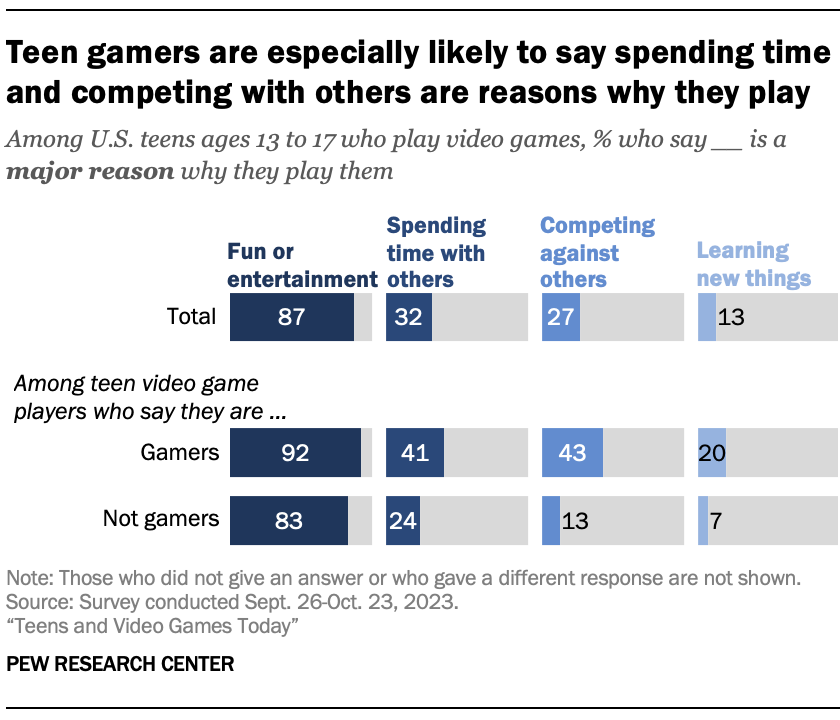
Teens who identify as gamers are particularly likely to say each is major reason, especially when it comes to competing against others. About four-in-ten gamers (43%) say this is a major reason, compared with 13% of those who play video games but aren’t gamers.
Teen boys who play video games are more likely than girls to say competing (36% vs. 15%), spending time with others (36% vs. 27%) and entertainment (90% vs. 83%) are major reasons they play video games.
Black and Hispanic teens who play video games are more likely than White teens to say that learning new things and competing against others are major reasons they play them. For instance, 29% of Black teen video game players say learning something new is a major reason, higher than 17% of Hispanic teen video game players. Both are higher than the 7% of White teen video game players who say the same.
Teens who play video games and live in lower-income households are especially likely to say competing against others and learning new things are major reasons. For instance, four-in-ten teen video game players who live in households with an annual income of less than $30,000 say competing against others is a major reason they play. This is higher than among those in households with annual incomes of $30,000 to $74,999 (29%) and $75,000 or more (23%).
Cyberbullying can happen in many online environments, but many teens encounter this in the video game world.
Our survey finds that name-calling is a relatively common feature of video game life – especially for boys. Roughly four-in-ten teen video game players (43%) say they have been harassed or bullied while playing a video game in one of three ways:
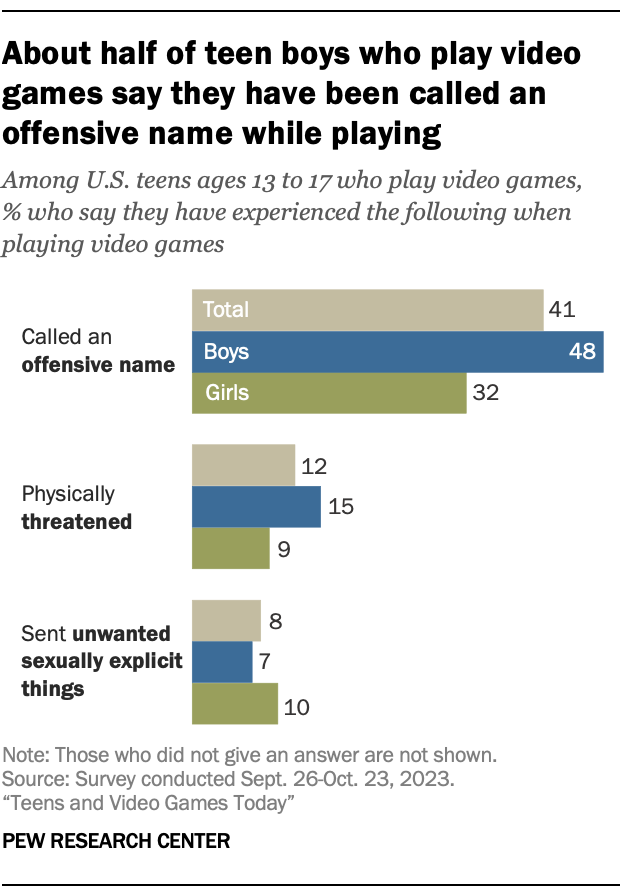
- 41% have been called an offensive name
- 12% have been physically threatened
- 8% have been sent unwanted sexually explicit things
Teen boys are particularly likely to say they have been called an offensive name. About half of teen boys who play video games (48%) say this has happened while playing them, compared with about a third of girls (32%). And they are somewhat more likely than girls to have been physically threatened (15% vs. 9%).
Teen gamers are more likely than those who play video games but aren’t gamers to say they been called and offensive name (53% vs. 30%), been physically threatened (17% vs. 8%) and sent unwanted sexually explicit things (10% vs. 6%).
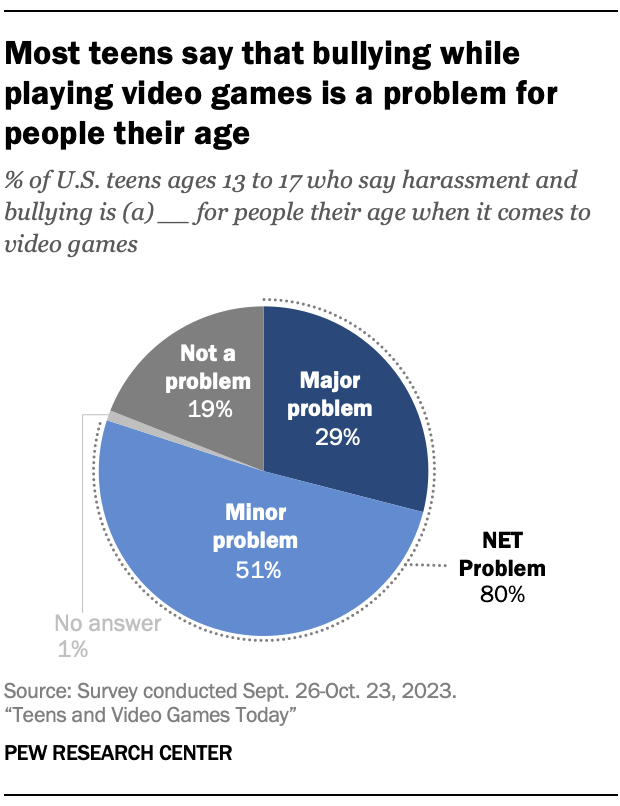
Teens – regardless of whether they’ve had these experiences – think bullying is a problem in gaming. Eight-in-ten U.S. teens say that when it comes to video games, harassment and bullying is a problem for people their age. This includes 29% who say it is a major problem.
It’s common for teens to think harassment while playing video games is a problem, but girls are somewhat more likely than boys to say it’s a major problem (33% vs. 25%).
There have also been decades-long debates about how violent video games can influence youth behavior , if at all – such as by encouraging or desensitizing them to violence. We wanted to get a sense of how commonly violence shows up in the video games teens are playing.
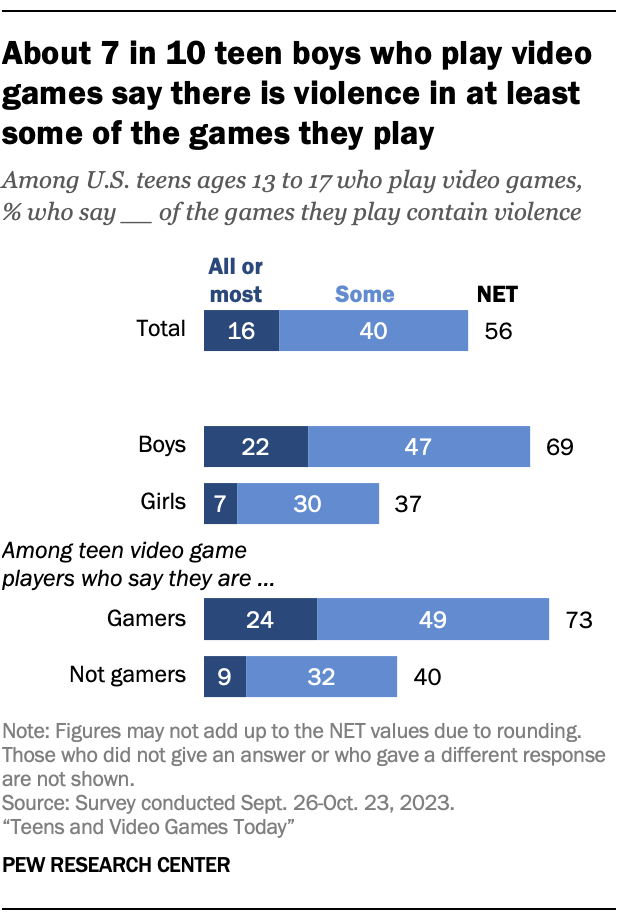
Just over half of teens who play video games (56%) say at least some of the games they play contain violence. This includes 16% who say it’s in all or most of the games they play.
Teen boys who play video games are far more likely than girls to say that at least some of the games they play contain violence (69% vs. 37%).
About three-quarters of teen gamers (73%) say that at least some of the games they play contain violence, compared with 40% among video game players who aren’t gamers.
- Throughout this report, “teens” refers to those ages 13 to 17. ↩
- Previous Center research of U.S. adults shows that men are more likely than women to identify as gamers – especially the youngest adults. ↩
- There were not enough Asian American respondents in the sample to be broken out into a separate analysis. As always, their responses are incorporated into the general population figures throughout the report. ↩
Sign up for our weekly newsletter
Fresh data delivery Saturday mornings
Sign up for The Briefing
Weekly updates on the world of news & information
- Friendships
- Online Harassment & Bullying
- Teens & Tech
- Teens & Youth
How Teens and Parents Approach Screen Time
Teens and internet, device access fact sheet, teens and social media fact sheet, teens, social media and technology 2023, what the data says about americans’ views of artificial intelligence, most popular, report materials.
1615 L St. NW, Suite 800 Washington, DC 20036 USA (+1) 202-419-4300 | Main (+1) 202-857-8562 | Fax (+1) 202-419-4372 | Media Inquiries
Research Topics
- Age & Generations
- Coronavirus (COVID-19)
- Economy & Work
- Family & Relationships
- Gender & LGBTQ
- Immigration & Migration
- International Affairs
- Internet & Technology
- Methodological Research
- News Habits & Media
- Non-U.S. Governments
- Other Topics
- Politics & Policy
- Race & Ethnicity
- Email Newsletters
ABOUT PEW RESEARCH CENTER Pew Research Center is a nonpartisan fact tank that informs the public about the issues, attitudes and trends shaping the world. It conducts public opinion polling, demographic research, media content analysis and other empirical social science research. Pew Research Center does not take policy positions. It is a subsidiary of The Pew Charitable Trusts .
Copyright 2024 Pew Research Center
An official website of the United States government
The .gov means it’s official. Federal government websites often end in .gov or .mil. Before sharing sensitive information, make sure you’re on a federal government site.
The site is secure. The https:// ensures that you are connecting to the official website and that any information you provide is encrypted and transmitted securely.
- Publications
- Account settings
Preview improvements coming to the PMC website in October 2024. Learn More or Try it out now .
- Advanced Search
- Journal List
- v.192(6); 2020 Feb 10

Smartphones, social media use and youth mental health
- Evidence from a variety of cross-sectional, longitudinal and empirical studies implicate smartphone and social media use in the increase in mental distress, self-injurious behaviour and suicidality among youth; there is a dose–response relationship, and the effects appear to be greatest among girls.
- Social media can affect adolescents’ self-view and interpersonal relationships through social comparison and negative interactions, including cyberbullying; moreover, social media content often involves normalization and even promotion of self-harm and suicidality among youth.
- High proportions of youth engage in heavy smartphone use and media multitasking, with resultant chronic sleep deprivation, and negative effects on cognitive control, academic performance and socioemotional functioning.
- Clinicians can work collaboratively with youth and their families, using open, nonjudgmental and developmentally appropriate approaches to reduce potential harms from social media and smartphone use, including education and practical problem-solving.
- There is a need for public awareness campaigns and social policy initiatives that promote nurturing home and school environments that foster resilience as youth navigate the challenges of adolescence in today’s world.
In the last decade, increasing mental distress and treatment for mental health conditions among youth in North America has paralleled a steep rise in the use of smartphones and social media by children and adolescents.
In Ontario, the proportion of teenagers reporting moderate to serious mental distress increased from 24% in 2013, to 34% in 2015 and to 39% in 2017, 1 with parallel increases in health service utilization. Inpatient hospital admissions of children and adolescents for mental health reasons increased substantially across Canada between 2007 and 2014, while admissions for other medical conditions in this age group decreased by 14%. 2 Between 2009 and 2014, admissions to hospital for intentional self-harm increased by 110% in Canadian girls. 3 Suicide is now the second leading cause of death for Canadian youth. 4 A recent analysis of survey data found the 12-month prevalence of suicidal ideation, attempts and nonsuicidal self-injury to be 8.1%, 4.3% and 8.8%, respectively, among adolescents aged 14 to 17 years, with all rates being higher in girls. 5 Similarly, administrative data in the United States show that presentations to hospital for suicidal ideation or attempts among children and adolescents almost doubled between 2008 and 2015, with the highest increase for adolescent girls. 6 Self-poisoning rates among 10- to 18-year-olds, which had declined in the US since the turn of the century, increased substantially from 2011 to 2018, primarily among girls. 7 Surveys of high school students in the US have shown a similar pattern for self-reported symptoms of depression, major depressive episodes and suicidality over the last 2 decades. 8 , 9
At the same time, social media use has increased markedly. In the US, the proportion of young people between the ages of 13 and 17 years who have a smartphone has reached 89%, more than doubling over a 6-year period; moreover, 70% of teenagers use social media multiple times per day, up from a third of teens in 2012. 10 The percentage of Ontario’s teenagers who reported spending 5 or more hours a day on social media increased from 11% in 2013, to 16% in 2015 and to 20% in 2017. 1 An analysis of Australian longitudinal data found that 86% of students owned smartphones in grade 8, increasing to 93% by grade 11, with increased use of social media communication with age. 11
We review the evidence that links smartphone and social media use with mental distress and suicidality among adolescents. We do not review evidence for online gaming. Although most existing data are observational, making causality difficult to establish, findings from a few longitudinal, randomized and controlled studies suggest that social media and smartphone use may be contributing to the rising burden of mental distress among youth. We consider the clinical implications of existing evidence, to help practising clinicians to work collaboratively with youth and families to mitigate potential negative effects of social media and smartphone use on mental health.
How has use of social media been shown to affect adolescents’ sense of self?
Two cross-sectional surveys of American and German university students, respectively, 12 , 13 found that students who spent more time on the social media platform Facebook were more likely to endorse feeling envy or sensing that others in their social network were better off than they were. The term “FOMO” — fear of missing out — has been defined as “a pervasive apprehension that others might be having rewarding experiences from which one is absent,” 14 and has been associated with increased stress related to Facebook use. 15
A systematic review of 20 studies found that use of social media was associated with body image concerns and disordered eating. 16 In a randomized study, female participants reported more negative mood after just 10 minutes of browsing their Facebook account compared with those who browsed an appearance-neutral control website. 17 Moreover, participants who were high in appearance comparison tendency reported an increased desire to change the appearance of their face, hair or skin after spending time on Facebook, in comparison with those who browsed the control website. 17
The nature of social media interactions, which are arm’s length, makes negative commenting both easy and more frequent than in-person interactions with peers. An Ontario survey of middle- and high school students showed that the odds of suicidal ideation, plans and attempts were all significantly higher among those who had experienced cyberbullying, even after controlling for a range of potential confounders. 18
Does social media addiction exist and can it affect mental health?
One study of repeat survey data from 2013, 2014 and 2015 associated the extent of self-reported use of Facebook with subsequent poor self-reported mental health and life satisfaction. 19 Concerns have been raised about social media platforms having been deliberately designed — in highly sophisticated ways that use behavioural psychology, neuroscience and artificial intelligence — to promote behavioural reinforcement and behavioural addiction. 20 , 21 Several cross-sectional studies have shown that high proportions of youth appear to be addicted to their smartphones, 22 , 23 but there is no standard or agreed-upon definition of smartphone or Internet addiction; studies have used different definitions and scales, varying from those that rely on behavioural addiction criteria, to measurement of the extent of functional impairment and level of device use. 24 , 25 As such, reported prevalence rates are highly variable. 25
A systematic review identified Internet addiction as being particularly associated with self-harm or suicidal behaviour based on 7 included studies, all of which were cross-sectional school-based surveys that used validated outcome measures and were rated as high or medium to high quality. 24 A recent large prospective study of senior high school adolescent students in Taiwan found that youth classified as experiencing Internet addiction had a significantly increased risk of having newly emerged self-harm or suicidal behaviour or both when re-evaluated 1 year later. 26
Two systematic reviews have shown that media multitasking is associated with negative effects on cognitive control, academic performance and socioemotional functioning in youth. 27 , 28 Most existing studies, however, are cross-sectional, and measures are heterogenous across studies with limited attempts to consider individual and contextual differences, making it impossible to establish causality. Youth with lower impulse control may be more susceptible to deleterious effects of media multitasking. A large longitudinal study of adolescents who did not have significant symptoms of attention-deficit/hyperactivity disorder (ADHD) at baseline found that high-frequency digital media use was positively associated with emergence of symptoms meeting Diagnostic and Statistical Manual of Mental Disorders–4th Edition (DSM-IV) criteria for ADHD over a 2-year follow-up period, even after adjusting for known confounders. 29
Can social media promote self-harm?
Youth communicate thoughts of suicidality and self-harm behaviours online, including sharing images of self-inflicted injuries. Explicit depiction of self-injury — particularly cutting — on social media is common, as shown by site content studies 30 , 31 that found photographs or live videos of self-injurious behaviour, many of which had no warnings about graphic content. Of particular concern were viewers’ comments, which typically contained positive feedback or personal disclosures about self-injury experiences, and rarely offered encouragement or discussion of recovery. Such findings show the potential for mental illness romanticizing and messaging that normalizes self-harm among youth. Indeed, a systematic review that included 26 studies (using qualitative, descriptive or cross-sectional methodology) found that social media platforms included normalization of self-harm behaviour, discussions about practical issues regarding suicidality and live depictions of self-harm acts. 32 At the same time, there were also positive elements, including providing a sense of community, suggestions for seeking treatment and advice on stopping self-harm behaviour.
Do the effects of smartphones on social skills affect mental health?
An observational study showed that spending more than a few hours per week using electronic media correlated negatively with self-reported happiness, life satisfaction and self-esteem, whereas time spent on nonscreen activities (in-person social interactions, sports or exercise, print media, homework, religious services, working at a paid job) correlated positively with psychological well-being, among adolescents. 33 Other observational studies have linked spending more than 2 hours a day on social networking sites and personal electronic devices with high rates of suicidality and depressive symptoms among adolescent girls, although youth who sustained high levels of face-to-face socializing were relatively protected against the negative consequences of too much time online. 13 , 34
Youth do increasingly interact online rather than in person, and smartphones can interfere even with face-to-face interactions via what has been termed “phubbing”: attending to one’s phone when in the presence of others. 35 A recent empirical field study using experience sampling in 304 participants showed that even the mere presence of phones on a table caused participants who were randomly assigned to that condition to feel more distracted and have lower enjoyment during social interactions compared with those who were randomized to putting their phone away. 36 Phone use was also found to predict distraction, which in turn predicted greater boredom and worse overall mood. 36
Does sleep-loss associated with use of social media affect mental health?
An analysis of US annual survey data found an abrupt increase in the proportion of adolescents getting insufficient sleep after 2011–2013, with more than 40% sleeping less than 7 hours most nights in 2015. 37 The study also showed an exposure–response relationship between daily electronic media use beyond 2 or more hours per day, and insufficient sleep. 37 An analysis of survey data from Ontario found that 63.6% of 5242 students aged 11–20 years slept less than recommended, 38 also showing a significant relationship between use of social media beyond 1 hour a day and odds of insufficient duration of sleep. 38
In a 14-day, randomized, crossover experimental study under well-controlled conditions, use of electronic screens before bedtime was shown to disrupt sleep in multiple ways: longer time to fall asleep and decreased evening sleepiness, reduced melatonin secretion, circadian clock delay, reduced amount and delay in rapid eye movement sleep, and reduced next-morning alertness. 39 A systematic review and meta-analysis that included 20 studies on the association between portable screen-based media devices and sleep outcomes found that use of media at bedtime was associated with decreased duration and quality of sleep and excessive daytime sleepiness. 40 Of note, the mere presence of portable screen-based media devices in the bedroom was shown to disrupt sleep, 40 possibly related to the temptation to check media devices when they are present or owing to a conditioned response involving increased arousal.
Data from a longitudinal study of 1101 adolescents in Australia showed that poor sleep mediated the relationship between nighttime mobile phone use and subsequent depressed mood, externalizing behaviours and decline in self-esteem and coping based on various validated scales. 11 In another longitudinal study involving 2286 adolescents in Europe, magnitude of Internet use in general had a negative impact on mental health, but the most robust effects came from the consequences — in particular, lack of sleep from Internet use had a notable adverse effect on mental health on 4-month follow-up based on measures from a validated depression, anxiety and stress scale. 41
Are some individuals more susceptible to mental health effects than others?
Although population-based studies suggest a link between social media use and mental distress among youth, the impact of these technologies may vary among individuals — and some may be less susceptible to harm, as indicated by an emerging literature of experimental studies. Girls and young women tend to spend more time on social media than boys do, have more exposure to cyberbullying and show tendency to experience more mental health effects, 10 , 34 which is consistent with recent epidemiologic trends indicating that depressive symptoms, self-harm and suicidality have increased among young females in particular. 5 – 9
The context of social media use may mediate its effects. A structural equation modelling analysis of a cross-sectional survey of 910 high school students in Belgium found that, among girls, passive use of Facebook had a negative impact on mood but active use had a positive impact on perceived online social support, which in turn had a positive impact on mood. 42 However, for boys active site use had a negative effect. A systematic review of 70 studies found that while social media use was correlated with depression, anxiety and measures of well-being, effects could be both detrimental (such as from negative interactions and social comparison) and beneficial (such as through social connectedness and support) depending on the quality of interactions and individual factors. 43 Certain cognitive styles, such as those that involve rumination and brooding, appeared to exacerbate negative effects of social media. 43 Moreover, the negative impact of social media on depressive symptoms appears to be much greater for adolescents with low levels of in-person interaction; in contrast, youth with high levels of face-to-face socializing appear to be relatively protected against the negative consequences of too much time online. 34 A recent survey of 1124 college students found that while social media contact in the absence of a face-to-face relationship was associated with depressive symptoms, the proportion of social media contacts with whom participants had a close face-to-face relationship was negatively associated with depressive symptoms. 44 In addition, the challenges associated with social media may be especially risky for young people who are already experiencing mental health difficulties, as suggested by the bidirectional relationship between use of electronic media and decrease in psychological well-being. 33 Of particular concern for such vulnerable individuals is that educational or even promotional content about suicide and self-harm is readily available and widely accessed online. 30 , 31
The role of individual differences in terms of the effects of social media is a topic of active investigation. Recent experimental studies have shown relationships between individual characteristics and social media experiences. In a randomized study of 120 college students, those who scored highly on the tendency to engage in social comparison based on measures from a validated scale had poorer self-perceptions, lower self-esteem and more negative affect after browsing the Facebook profile of an acquaintance, relative to those randomized to the control conditions, an effect not seen among students who scored low on social comparison traits. 45 In another empirical study, 102 college students who were asked to take a selfie were randomized to either of 3 conditions with different numbers of “likes” (average, above average and below average); those rated as having a greater sense of purpose in life based on measures from a validated scale had lower sensitivity to feedback (based on number of “likes”) on their self-photograph posts. 46 A study that categorized participants by social comparison orientations (“ability-based” versus “opinion-based”) found that different orientations showed different emotional responses to being compared with others, which in turn was related to life satisfaction. 47 These early findings offer some insights for the individualized care of youth presenting with emotional and mental distress.
How might physicians use this evidence to inform their practice?
Despite the limitations of the evidence base at this time, clinicians may be able to use currently available knowledge in their practice, combined with evidence on effecting behavioural change in youth.
Clinicians treating youth with mental illness and those at risk of mental distress can discuss with adolescents and their families the known risks of social media and smartphone use to mental health. Clinicians may choose to advocate for a harm reduction approach, suggesting reduced use of social media and the Internet rather than abstinence for youth, given evidence that suggests prolonged use is associated with poorer mental health. A recent large systematic review found that communication with adolescents is most effective in the context of a therapeutic alliance that is open and nonjudgmental, elicits trust and emotional safety, and offers a sense of inclusion and autonomy. 48
Encouraging parents to be proactively involved in limiting children’s and teens’ use of smartphones and social media may be helpful, given that social media use appears to become problematic when it surpasses 1 to 2 hours daily. 34 , 38 Results from a recent meta-analysis suggest that while parental limits may be effective at reducing the amount of media use by younger children, open discussion focused on positive engagement and guidance might be best for reducing media-related risks for adolescents; however, only 5 of the 52 included studies pertained to social media, all of which were based on cross-sectional surveys. 49 It is also worth reminding parents that they model smartphone use with their own behaviour; a randomized study showed that heavy parental smartphone use was associated with poorer quality of interactions with their children. 50 Youth and their families can be encouraged to set boundaries for smartphone and social media use. These could include such measures as using social media only for set times, and preferably only in common living areas in the home. A further motivator may be to discuss evidence showing an adverse impact of smartphones on learning, 51 and the benefit on academic outcomes when phones are put away when studying, preferably in another room. 52
A qualitative study that collected data via focus groups with adolescent girls found that high levels of confidence, high media literacy and sound appreciation of individual differences appeared to mitigate negative effects of social media on body image. 53 The participants reported that “these characteristics were nurtured by positive parental influence and a supportive school environment.” 53 These findings underscore the importance of a nurturing home and school environment in fostering resilience as youth navigate the challenges of adolescence. An empirical study of the effect of Instagram browsing on affect in just more than 500 adolescents found that randomization to conditions that provided greater contextual awareness regarding posts by others mitigated against postbrowsing negative affect in teens who reported higher levels of negative social comparison. 54
Sleep hygiene measures specific to social media and smartphone usage are crucial, as several studies have shown that increased smartphone use can disrupt sleep and shorten sleep duration. These would include avoiding use of electronic screens within 1 to 2 hours before bedtime, and not having portable, screen-based media devices in bedrooms overnight.
The American Academy of Pediatrics provides a number of useful health and safety tips to support youth regarding the use of social media, 55 as well as a Family Media Use Plan that offers structure to the recommendations related to limiting use and having discussions regarding appropriate use. 56 Further, the American Academy of Pediatrics has partnered with Common Sense Media to produce a Family Media Toolkit that has useful information for parents. 57 Other practical strategies to mitigate negative effects from using smartphones and related media are offered by the Center for Humane Technology ( http://humanetech.com/ ), an organization developed by former technology industry members out of concern for the potential deleterious effects of new media on psychological states.
A motivational interviewing approach may be useful to help young people start to make changes in their pattern of online behaviour. Motivational interviewing is an intervention with established effectiveness for adolescents with substance use, which could be useful for youth who appear to have poor self-control in their use of social media or smartphone. 58 This approach should involve open, nonjudgmental exploration of all aspects of a youth’s digital life, including positive and negative. Some youth might benefit from habit reversal training to address compulsive use, including having daily “nonscreen time” that can be progressively increased. Sharing evidence that a randomized controlled trial found that participants assigned to not using Facebook reported significantly greater “life satisfaction” and positive emotions after 1 week, compared with controls who were told to continue using the site as usual, 59 may be helpful in effecting change. Youth might be encouraged to inform their friends that they are taking a break from, or otherwise limiting, their social media use. Talking with youth about alternative ways to connect, including meeting in person or even talking directly by phone, could help with strategies to fill the social media gap, reinforced by discussion of evidence that in-person interaction may protect mental health.
At the system level, school and community-based programs can institute limits on social media and smartphone use, along the lines of those that have recently been shown to have a positive effect on healthy behaviours. 60 However, such interventions should be developmentally appropriate and aim to respectfully ensure adolescents’ autonomy. 61 Mobile-phone policies at the school and classroom level have been implemented in several jurisdictions, with mixed results. 62 Enforcement of blanket bans is often a challenge; rather, a more productive approach involves negotiation between teacher and students, as developmentally appropriate, in the context of a relationship built on mutual trust and respect for autonomy. 63 , 64
More broadly, public awareness campaigns can provide education on the impact of problematic use of digital media and promote healthy behaviours in this regard. Various social media platforms have placed bans and restrictions on content related to self-harm. 24 A qualitative study of focus groups involving a total of 66 adolescents found that while adolescents valued freedom and privacy, they recognized a need for protection and most were in favour of automatic monitoring in situations that were beyond their control. 65 Finally, there should be public discussion about the extent to which social media companies can use features that are deliberately designed to promote behavioural reinforcement and addiction, 20 , 21 particularly on platforms used primarily by youth.
Encouragingly, youth are increasingly recognizing the negative impact of social media on their lives and starting to take steps to mitigate this. 66 According to a recent poll, 54% of teens felt they spend too much time on their cell phone, and about half reported cutting back on the time they spend on it. 67
Given the importance of engaging youth in mitigating potential harms from social media, a prohibitionist approach would be counterproductive. The American Academy of Pediatrics suggests that online relationships are part of typical adolescent development. 55 Indeed, for adolescents today, who have not known a world without social media, digital interactions are the norm, and the potential benefits of online access to productive mental health information — including media literacy, creativity, self-expression, sense of belonging and civic engagement — as well as low barriers to resources such as crisis lines and Internet-based talking therapies cannot be discounted.
However, today’s youth could benefit from proven individual and systemic interventions to help them navigate the challenges brought about by use of smartphones and social media, protect themselves from harm and use social media in a manner that safeguards their mental health, against a background of policy initiatives aimed at addressing the social, environmental and economic factors that underpin family well-being and nurture youth resilience. 68
Acknowledgements
The authors acknowledge the valuable contributions of the anonymous reviewers and journal editors.
CMAJ Podcasts: author interview at https://soundcloud.com/cmajpodcasts/190434-ana
Competing interests: None declared.
This article has been peer reviewed.
Contributors: All of the authors contributed to the conception and design of the work. Elia Abi-Jaoude and Karline Treurnicht Naylor drafted the manuscript. All authors revised the manuscript critically for important intellectual content, gave final approval of the version to be published and agreed to be accountable for all aspects of the work.
To read this content please select one of the options below:
Please note you do not have access to teaching notes, unraveling the dark side of chatgpt: a moderated mediation model of technology anxiety and technostress.
Information Technology & People
ISSN : 0959-3845
Article publication date: 17 May 2024
Limited knowledge exists regarding the adverse effects of artificial intelligence adoption, including platforms like ChatGPT, on users’ mental well-being. The current research seeks to adopt the insight from the stressor-strain-outcome paradigm and a moderated mediation model to examine how technology anxiety moderates the direct and indirect relationships between compulsive use of ChatGPT, technostress, and life satisfaction.
Design/methodology/approach
Drawing data from a sample of 2,602 ChatGPT users in Vietnam, PROCESS macro was approached to test the moderated mediation model.
The findings indicate that compulsive use of ChatGPT exhibited a substantial and positive impact on technostress, while technostress was found to have a negative influence on life satisfaction. Moreover, although compulsive use of ChatGPT did not show a significant direct effect, it indirectly impacts life satisfaction via technostress. Remarkably, technology anxiety was found to significantly moderate both direct and indirect associations between compulsive use of ChatGPT, technostress, and life satisfaction.
Practical implications
Based on the findings of this research, some practical implications are provided.
Originality/value
The research offers a fresh perspective by applying the stressor-strain-outcome perspective to provide empirical evidence on the moderated mediation effects of technology anxiety and technostress on the relationship between compulsive use of ChatGPT and users’ life satisfaction. The research thus sheds new light on artificial intelligence adoption and its effects on users’ mental health.
- Compulsive use of ChatGPT
- Technostress
- Technology anxiety
- Life satisfaction
Acknowledgements
This research was funded by National Economics University, Hanoi, Vietnam.
Duong, C.D. , Ngo, T.V.N. , Khuc, T.A. , Tran, N.M. and Nguyen, T.P.T. (2024), "Unraveling the dark side of ChatGPT: a moderated mediation model of technology anxiety and technostress", Information Technology & People , Vol. ahead-of-print No. ahead-of-print. https://doi.org/10.1108/ITP-11-2023-1151
Emerald Publishing Limited
Copyright © 2024, Emerald Publishing Limited
Related articles
We’re listening — tell us what you think, something didn’t work….
Report bugs here
All feedback is valuable
Please share your general feedback
Join us on our journey
Platform update page.
Visit emeraldpublishing.com/platformupdate to discover the latest news and updates
Questions & More Information
Answers to the most commonly asked questions here

IMAGES
VIDEO
COMMENTS
NICK ALLEN: Use digital technology to our advantage. It is appealing to condemn social media out of hand on the basis of the — generally rather poor-quality and inconsistent — evidence ...
lack of attention. low creativity. delays in language development. delays in social and emotional development. physical inactivity and obesity. poor sleep quality. social issues, such as social ...
Some apps and digital tools offer mental health interventions providing self-management, monitoring, skills training, and other interventions that may improve mood and behavior. Additional research on the positive and negative brain health effects of technology is needed to elucidate mechanisms and underlying causal relationships.
For example, their position is that long hours of social media use contribute to depression and anxiety (Karim et al., 2020). This focus is integral in my research since it addresses the impact of technology on mental health by explaining the possible avenues for mental health crises. Lattie et al. (2019) investigate how the rise in mental ...
Digital technology use was associated with a slight decrease in adolescent well-being, ... the negative effects on mental health may well be larger now. ... "These kinds of papers, there's ...
Thus, against common concerns, digital technology as such does not affect mental health or deteriorate well-being. Its use can have both negative and positive consequences. Technology simply does not "happen" to people. Individuals can shape the experiences they have with technologies and the results of those experiences.
The literature implies that the relationship between technology use and adolescent well-being is more complicated than an overall negative linear effect. In line with meta-analyses on adults, effects of digital technology use in general are mostly neutral to small. In their meta-review of 34 meta-analyses and systematic reviews, Meier and ...
The general public is also more receptive to technology's expanded role in mental health care. "The pandemic has created a lasting relationship between technology, and it has helped increase access to mental health services across the world," says McKinley. "There are lots of people seeking help who would not have done so prior to the ...
This editorial introduces the special issue on digital mental health. The promise of digital, mobile, and connected technologies to advance mental health, and especially psychiatric rehabilitation, continues to rapidly evolve. New sensors and data, such as those derived from increasingly ubiquitous smartphones, offer a new window into the functional, social, and emotional experiences of ...
These negative impacts lead to more depression and anxiety. Our bodies experience the negative effects of technology, too. More screen time can disrupt sleep, especially if this screen time is before bed. And the longer people spend using devices, the less inactive they become. But both disrupted sleep and inactivity worsen mental health.
Some apps and digital tools offer mental health interventions providing self-management, monitoring, skills training, and other interventions that may improve mood and behavior. Additional research on the positive and negative brain health effects of technology is needed to elucidate mechanisms and underlying causal relationships.
The impact of technology has extended into the realm of health care, and it is clear that technology also is making positive changes in terms of mental health care. Research has indicated, however, that the very tools that can help alleviate mental health issues, such as smartphone apps, may be linked with the experience of mental health ...
Benefits. The use of social media significantly impacts mental health. It can enhance connection, increase self-esteem, and improve a sense of belonging. But it can also lead to tremendous stress, pressure to compare oneself to others, and increased sadness and isolation. Mindful use is essential to social media consumption.
Many researchers have postulated that worsening mental health attributed to social media use may be because social media replaces face-to-face interactions for young people (Twenge and Campbell 2018) and may contribute to greater loneliness (Bucci et al. 2019) and negative effects on other aspects of health and wellbeing (Woods and Scott 2016).
Although it has various positive effects, it can negatively affect users' mental health. Limiting the use of social media to 30 minutes a day can reduce FOMO and, in turn, relieve the loneliness ...
The Impact of Technology on Mental Health. August 2019. DOI: 10.1201/9780429325632-4. In book: Electrical Brain Stimulation for the Treatment of Neurological Disorders (pp.353-402) Authors: Bahman ...
The authors of the latest study, published on 13 May in Technology, Mind and Behaviour, sought to capture a more global picture of the Internet's effects than did previous research. "While the ...
This study investigated the effects of online learning on mental health. The focus included six aspects: academic performance, physical activity, social isolation, food insecurity and other stressors, pros and cons, and religion and mental health. Each aspect included advantages and disadvantages that adolescent students experienced. The study included 6th - 12th graders attending a Charter ...
Many researchers have postulated that worsening mental health attributed to social media use may be because social media replaces face-to-face interactions for young people (Twenge & Campbell, 2018), and may contribute to greater loneliness (Bucci et al., 2019), and negative effects on other aspects of health and wellbeing (Woods & Scott, 2016).
500 Words Essay on Negative Effects Of Technology On Health Physical Problems from Too Much Screen Time. When we use our phones, computers, or tablets a lot, we can start to have physical problems. One common issue is eye strain. Staring at screens for too long can make our eyes tired and sore. It can even lead to headaches and trouble seeing ...
To mitigate the negative effects of heavy technology use on mental health, it is important to adopt strategies for managing our technology habits. Additionally, it is important to be mindful of the impact of social media on mental health and to remember that social media often presents an unrealistic and curated version of reality.
Health Research Technology The study encompassed more than two million participants psychological wellbeing from 2006-2021 across 168 countries, in relation to internet use and psychological well-being across 33,792 different statistical models and subsets of data, 84.9% of associations between internet connectivity and wellbeing were positive ...
Essay on the Negative Effects of Technology on Mental Health. This essay sample was donated by a student to help the academic community. Papers provided by EduBirdie writers usually outdo students' samples. Technology runs the world and at this point, technological advances in any field are inevitable. Imagining a world without technology would ...
Essay About the Negative Effects of Technology on Physical, Social and Mental Health [Internet]. Edubirdie. 2022 Oct 28 [cited 2024 May 13].
Technology, Conflict And Global Pandemics As The Disruptors. I'm a student of history. I can't help drawing parallels to another time in near history when this level of mental health became a ...
Background: Structural social determinants of health have an accumulated negative impact on physical and mental health. Evidence is needed to understand whether emerging health information technology and innovative payment models can help address such structural social determinants for patients with complex health needs, such as Alzheimer's disease and related dementias (ADRD). Objective: This ...
Still, many teens who play video games think playing them doesn't have much an impact in any of these areas. For instance, at least six-in-ten teens who play video games say it has neither a positive nor a negative impact on their mental health (60%) or their school performance (72%). Fewer (41%) say this of their problem-solving skills. By ...
Evidence from a variety of cross-sectional, longitudinal and empirical studies implicate smartphone and social media use in the increase in mental distress, self-injurious behaviour and suicidality among youth; there is a dose-response relationship, and the effects appear to be greatest among girls. Social media can affect adolescents' self ...
The current research seeks to adopt the insight from the stressor-strain-outcome paradigm and a moderated mediation model to examine how technology anxiety moderates the direct and indirect relationships between compulsive use of ChatGPT, technostress, and life satisfaction.,Drawing data from a sample of 2,602 ChatGPT users in Vietnam, PROCESS ...
Purpose The continuous spread of the epidemic has inflicted serious harm upon individual's mental well-being, and effective coping mechanisms are associated with positive mental health outcomes. Prosocial behavior and a sense of meaning in life can enhance individuals' subjective well-being, which can subsequently positively impact their mental health. Thus, in the context of epidemic ...